Summer Research Scholarships
The Otago Medical Research Foundation funds around 20 summer research projects annually related to human health, including biomedical sciences and public health.
These scholarships are competitive, with many more students applying than it is possible to fund. The applications are assessed by the Foundation’s Scientific Committee so only the very best are chosen.
These student summer research projects are supervised by senior researchers and run for 10 weeks. These often lead to research and teaching careers for the students, and the projects contribute knowledge to the field.
Applications for 2025/26 closed on Thursday 14 August 2025. For details on how to apply, see the University of Otago OMRF Scholarships page.
For further details contact:
Dr Manon Knapen, Division of Health Sciences Administration
[email protected]
Otago Medical Research Foundation Summer Research Scholarships awarded for 2025/26
We are delighted to announce that 20 students have been awarded Otago Medical Research Foundation Summer Research Scholarships for 2025/6. We are truly grateful to the organisations who have generously donated funds to support these scholarships (named in italics before each student).
Click below for details of the student, their supervisor and a lay abstract of their project. Interim photos are included. Professional photos (as in previous years) will be added after an event held towards the end of their summer scholarship period.
2025/2026 Summer Scholarships
Evan and Carolyn Matheson
Andre Morice
Project: Do calcium channels contribute to frontotemporal dementia pathology?
Supervisor: Dr Owen Jones, Department of Psychology, Division of Sciences
Frontotemporal dementia (FTD) is a neurological condition which drives the degeneration of nerve cells in the brain as the disease progresses. FTD has no cure or disease-modifying treatment, hence, the majority of FTD research is focused on treating various symptoms at the earliest stages of the disease to improve the quality of life for individuals with FTD. Our lab and others have evidence that a specific type of calcium channel in neurons is overactive early in a model of FTD in one part of the brain, the hippocampus. This potentially explains some symptoms and the progression of the disease due the toxic effect excess calcium has on neurons. However, the majority of the symptoms of FTD, such as personality changes and poor impulse control, are associated with the loss of neurons in a second brain region, the prefrontal cortex.
In this research project, I will investigate whether calcium channel number or activity also show early changes in the prefrontal cortex in our model. As the hippocampus and prefrontal cortex are heavily connected, our results may highlight a network of brain regions in which calcium channel dysfunction contributes to the earliest stages of the disease. Further, our results may identify calcium channels as a general driver of pathology in FTD across brain regions. These channels could then be targeted with common drugs that are used in other diseases, in an attempt to prevent brain cell loss and restore brain function.
Professor Ailsa Goulding
Anne Puyat

Project: Role of Stress Neuron Activation on Aggressive Behaviours
Supervisor: Dr Joon Kim, Department of Physiology, School of Biomedical Sciences
Stress is well established to increase the likelihood of aggressive behaviour. Although often regarded as undesirable, aggression is an evolutionarily conserved response to stress that enables animals to compete for limited resources, defend territory, or secure mating opportunities. This primitive stress–aggression system, shaped by natural selection, persists in humans today. Despite this, the specific neural mechanisms linking brain stress circuits to aggressive behaviour remain poorly understood.
Preliminary findings from the Kim laboratory indicate that activation of a key population of stress-responsive neurons in the brain is sufficient to increase aggressive behaviours in male mice. Building on this unexpected discovery, we will use chemogenetic approaches to selectively activate these neurons and determine their causal role in generating aggression. In addition, we will investigate whether stress-induced aggression is modulated by social hierarchy, testing the hypothesis that alpha males exhibit a heightened aggressive response to stress circuit activation.
Aotearoa Gaming Trust
Audrey Zohrab

Project: Development of point of care molecular diagnostics for bacterial infections in low resource settings
Supervisor: Prof James Ussher, Department of Microbiology and Immunology, School of Biomedical Sciences
Bacterial infections present a high and growing burden of disease in low- and middle-income countries. Treatment is most effective when the infection is identified rapidly, and antimicrobial therapy is aligned with the resistance profile of the infecting organism. These goals are currently not being met across healthcare systems. There needs to be an appropriate, specific, and rapid test available for the patient when they enter the clinic.
Recombinase polymerase amplification (RPA) is a promising new technique with potential to fulfil these requirements. It works by promoting rapid DNA amplification at a single temperature (between 25 and 42°C). This eliminates the need for the temperature cycling that alternative diagnostics such as PCR demand.
In this project, I will explore the utility of RPA for use in a point of care (POC) test for Staphylococcus aureus and methicillin resistance (mecA). In my research, I will use RPA and specific primers for S. aureus and mecA to amplify the DNA of various strains of S. aureus. I will detect this amplified DNA using gel electrophoresis and real time fluorimetry to ‘diagnose’ the infection. I will test various methods of detecting this amplified DNA, trialling different test conditions to find out the optimum methodology to use in the point of care test. This research will contribute to a growing field around the utility of RPA in POC diagnostics, with the aim being to create functional POC tests for various pathogens suitable for use in low resource environments.
Healthcare Otago Charitable Trust
Bonnie Huang

Project: Discovering the interactome of different oligomeric forms of an antioxidant enzyme
Supervisor: Assoc Prof Liz Ledgerwood, Department of Biochemistry, School of Biomedical Sciences
Reactive Oxygen Species (ROS) are a group of highly reactive molecules that contain oxygen, such as hydrogen peroxide (H2O2). They play important roles in cell signalling and the body’s response against pathogens. However, when present at high levels, they can cause oxidative stress, resulting in damage within the cell. Oxidative stress can disrupt normal functioning of cells and has been associated with many diseases including major global killers such as ischaemic heart disease, cancer, and stroke.
Peroxiredoxins are a group of proteins found abundantly inside cells across many life forms and play a major role in regulating H2O2 levels. Previous work has shown that peroxiredoxins can transition between 2-subunit structures, 10-subunit ring structures, and stacks of 10-subunit ring structures, depending on amount of oxidation. Proteins transitioning between different formations is common throughout cellular biology and allows for changes in protein activity, function, location, stability, and interactions with other proteins. There has been extensive research done on peroxiredoxins changing formations outside cells. However, the environment inside cells is very complex.
Therefore, evidence from these studies cannot be confidently translated to what happens within cells. In the past, research on structural transitions within a cell in real time and space has been limited by experimental methods. Recent advances in technologies such as high- resolution microscopy and methods to monitor proteins within a cell has allowed investigating structural transitions of peroxiredoxins feasible. This research project aims to investigate what proteins interact with the different peroxiredoxin structures inside cells, with and without H2O2 stimulation.
Healthcare Otago Charitable Trust
Caleb Lopez-Sanchez

Project: Lived experiences of youth with type 1 diabetes using fully closed loop patch pumps: A qualitative study
Supervisor: Prof Ben Wheeler, Department of Paediatric & Child Health, Dunedin School of Medicine
This summer studentship involves conducting in-depth interviews and analysing qualitative data from a multi-phase clinical study involving people with type 1 diabetes (T1D). The broader study is testing a new patch insulin pump, a small, tubeless device controlled by a phone app, used alongside an open-source automated insulin delivery (AID) system. This next-generation technology helps to minimise disease burden by delivering insulin automatically, without needing users to count carbohydrates or enter meals.
The project includes 40 participants aged 16 years and above with T1D and with suboptimal glycaemia, despite use of the best currently funded commercial AID system in New Zealand. This studentship will particularly focus on the experience of youth and young adults (16-25 years), who often face the highest diabetes burden yet remain underrepresented in clinical trials. I will help conduct one-on-one interviews with participants to understand how they feel about using this new system. The scope of the interviews will include ease of use, lifestyle fit, and the overall experience of the user. This work aims to centre youth voices in the development of diabetes technology, helping ensure that future treatments are both clinically selective and meet the needs of those who use them.
University of Otago Fund – McGillivray Brother’s Legacy
Campbell Buck
Project: Uncovering the role of the SLC22A3 solute transporter in Lp(a) endocytosis
Supervisor: Prof Sally McCormick, Department of Biochemistry, School of Biomedical Sciences
Lipoprotein(a) [Lp(a)] is a cholesterol-carrying particle in the blood that resembles LDL (“bad cholesterol”) but contains an additional protein, apo(a), which gives it unique properties. Elevated Lp(a) levels are a strong genetic risk factor for heart disease and stroke. Lp(a) promotes the buildup of fatty plaques in blood vessels and interferes with the body’s natural clot-dissolving systems, making dangerous clots more likely to form. The liver produces most Lp(a), but how it is cleared from circulation remains unclear. Evidence shows that liver cells can take up Lp(a) through macropinocytosis, a process where the cell surface engulfs and internalises particles.
Serotonin has been shown to enhance macropinocytosis, suggesting it could increase Lp(a) clearance from the bloodstream. The protein transporter SLC22A3 moves serotonin in and out of cells and is located near the apo(a) gene. Variations in SLC22A3 are associated with higher Lp(a) levels and greater cardiovascular risk. This project aims to determine whether SLC22A3 influences Lp(a) uptake by the liver.
We will study both normal and genetically altered versions of SLC22A3 to assess how they affect serotonin availability outside cells and, in turn, the amount of Lp(a) absorbed. This work could explain why some individuals naturally have higher Lp(a) levels and point toward new strategies to reduce Lp(a) and risk of cardiovascular disease.
Anonymous Funder
Charlotte Hayde
Project: Investigating the Effect of Somatostatin on CRH Neuron Excitability Using Brain Slice Calcium Imaging
Supervisor: Assoc Prof Karl Iremonger, Department of Physiology, School of Biomedical Sciences
My proposed research project is based on the stress response that originates in the brain. It will look at the regulation of a certain type of neuron that initiates the stress response. These types of neurons are known as corticotropin-releasing hormone (CRH) neurons. Some neurons found in the same brain region as CRH neurons release a molecule called somatostatin (SST). We aim to determine if SST has a direct effect on CRH neurons, as this has not been previously studied.
We will examine mouse brain tissue under a microscope using a technique that makes CRH neurons light up when they are activated. We will apply SST to the brain, as well as similar drugs that target different sites that SST acts on. We will compare the activation of CRH neurons under each different condition to conclude if and how SST directly affects CRH neurons.
We predict that SST reduces the activity of the neurons involved in the stress response, which would mean SST “turns down” the body’s response to stress, making sure it doesn’t get out of control. If this is true, the neurons that release SST, and the sites that SST acts on, could become targets for new therapy of stress-related conditions such as chronic stress, depression and anxiety.
Aotearoa Gaming Trust
Chloe Goodkind
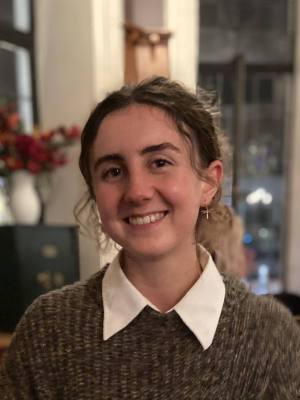
Project: Examining the Role of L1CAM in Sensory Neuron Axon Outgrowth
Supervisor: Dr Laura Gumy, Department of Anatomy, School of Biomedical Sciences
Mammalian sensory neurons form pathways that carry information from the body to the brain, enabling us to perceive the world around us. These neurons have a distinct morphology, consisting of two long branches, called axons, emanating from a singular cell body. One axon extends peripherally to the skin, muscles, and organs, where it detects sensory cues like heat and pressure. The second axon connects to the brain, where sensory information gets delivered.
Despite being part of the same neuron, the two axons respond differently to injury. When the peripheral branch is damaged it can regrow, whereas the central axon cannot repair itself. The molecular basis for this regenerative asymmetry remains unknown.
The Gumy Lab recently discovered that a protein called MAP2 might regulate the regenerative ability of axons. However, MAP2 acts through a molecular pathway that we have not yet mapped out. L1CAM protein is a newly discovered member of the MAP2 pathway. To understand MAP2 better, this project will focus on the related L1CAM protein. We will use genetic tools, microscopy, and cellular assays to determine how L1CAM influences regeneration. If confirmed as a MAP2-associated growth regulator, L1CAM may become a promising target for future therapies in nerve damage repair after spinal cord injury, stroke, and other neurological damage.
Kingston Sedgfield Charitable Trust and the Estate of H Robert Wilson
Chloe Johnston

Project: Plaque analysis after drug treatment to prevent seizures in Alzheimer’s disease model mice
Supervisor: Dr Shane Ohline, Department of Physiology, School of Biomedical Sciences
Alzheimer's disease (AD) is devastating for patients and families, causing progressive memory loss and cognitive decline. Scientists have discovered that problems with calcium regulation in brain cells may be a key driver of the disease, occurring even before the characteristic amyloid plaques fully develop. This research focuses on ryanodine receptor 2 (RyR2), a protein channel that normally controls calcium levels in brain cells. In AD, these channels become "leaky," causing too much calcium to flood into neurons. This calcium overload leads to brain cell death, seizures, and accelerated disease progression. R-carvedilol is a drug originally developed for heart conditions that can reduce excessive leak from RyR2 channels.
A recent survival study in mice showed promising but puzzling results; female mice seemed to benefit from the treatment, while males showed increased risk. This project will examine brain tissue from those same mice to understand why. We will measure amyloid plaque levels, the hallmark protein deposits of Alzheimer's, to determine if R-carvedilol actually changes the underlying disease process or just treats symptoms. By comparing plaque levels between treated and untreated mice, and between males and females, we can explain the survival differences and determine if this heart medication could become a new Alzheimer's treatment. This research could lead to repurposing an existing, well-tested medication to slow or prevent AD progression.
Aotearoa Gaming Trust
Gryffin Powell

Project: ACTL6A: Understanding its Role in Brain Development and Disease
Supervisor: Assoc Prof Louise Bicknell, Department of Biochemistry, School of Biomedical Sciences
This project aims to better understand the role of the gene ACTL6A, which encodes a protein subunit in the chromatin remodelling complex. Changes in this gene have been linked to neurodevelopmental conditions, but the scientific evidence is currently limited.
The Bicknell Lab is investigating whether specific ACTL6A variants may be pathogenic or not. One variant of particular interest was inherited by a New Zealand father and daughter, who both have intellectual disability and similar facial features. We will grow human cells in the lab and introduce either the normal or altered form of ACTL6A using plasmid transfection. To test whether the altered protein affects the activity of other important genes, we will extract RNA and use RT-qPCR to measure changes in gene expression.
Unexpectedly, we have found that ACTL6A is located not only in the nucleus (where it is expected to function), but also in the cytoplasm. To explore this further, we will use immunofluorescence microscopy to compare different forms of the ACTL6A protein and investigate what determines where it localises within the cells. By combining these approaches, this research will help clarify ACTL6A’s role in gene regulation and brain development and may strengthen its link to neurodevelopmental disorders.
Evan and Carolyn Matheson
Hannah Sime

Project: Low dose ketamine recapitulates brain changes seen in the MIA model of Schizophrenia
Supervisor: Dr Robert Munn, Department of Anatomy, School of Biomedical Sciences
The hippocampus is a part of the brain that helps us form and store memories. In healthy brains, this process is supported by deep brain waves that help “lock in” memories by synchronising activity between brain cells. In people with schizophrenia, this wave synchronisation is often disrupted, and this may be part of why memory and thinking problems occur.
In this project, we use a mouse model to study this disruption in more detail. Some mice will be given a very low dose of ketamine, which temporarily mimics certain features of schizophrenia, including the disruption of these brain waves. This creates an animal model that helps us explore whether wave synchronisation (or the lack of it) could be used as a measurable sign—or biomarker—of the condition.
Under the supervision of Dr Rob Munn, I will assist in collecting brain activity data using surgically implanted recording devices. These devices allow us to monitor electrical signals in the brain in real time. After recording, I will help analyse the data by separating signals from individual neurons and examining overall brain wave patterns using a programming tool called MATLAB.
By understanding how brain wave synchrony changes in this model, we hope to better understand the underlying brain changes in schizophrenia—and potentially find ways to track or treat them in the future.
Estate of H Robert Wilson
Jay Taylor

Project: Stabilisation motifs to optimise RNA vaccine design
Supervisor: Assoc Prof Paul Gardner, Department of Biochemistry, School of Biomedical Sciences
RNA is a versatile biomolecule that is being explored for potential applications in the world of medicine and pharmacology. While RNA is relatively unstable in many situations, there are many strategies that have evolved within nature that increase resistance to degradation. On account of recent advances made in characterising structures that improve the stability of RNA, this project will explore how these structures may enhance the use of RNA in the rapidly growing field of RNA therapeutics.
We are able to use Infernal to assess the wealth of published exoribonuclease resistance RNA (xrRNA) sequences and predict a highly accurate degradation resistant structure. Through integrating knowledge of both sequence and structure, Infernal is able to overcome many of the pitfalls that other bioinformatic tools face when it comes to RNA structural prediction. We can then use the motif constructed by Infernal and incorporate it into mRNA sequences. Within this project we will write a straightforward programme that seeks optimal degradation resistance through integrating structures that promote stability. The genetic algorithm will make tolerable changes to the mRNA, which is simple to achieve as varying different RNA sequences will encode the same protein, allowing us to edit the sequence without impacting the intended function of the mRNA. The final product of this project could be used to improve technologies such as RNA vaccines, as well as creating opportunity for investigation into other sequence and structural elements that have evolved to improve RNA stability, ushering in a new era of drug design.
MM & JH Hughes Family Trust
Liam Young
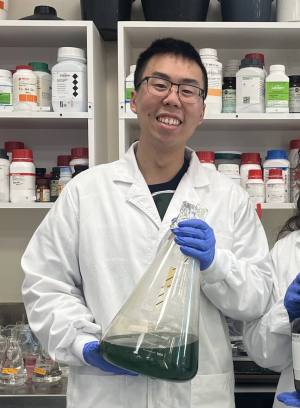
Project: Can we improve breast cancer treatment by understanding genetic drivers?
Supervisor: Assoc Prof Anita Dunbier, Department of Biochemistry, School of Biomedical Sciences
Breast cancer comprises approximately 12% of the cancer burden worldwide and approximately 3,500 New Zealanders are diagnosed annually. Despite its prevalence, only a relatively small proportion of cancers can be linked to specific cancer genes and syndromes. Individuals who carry specific variants in a gene named APOBEC appear to have a higher risk of breast cancer. This variant is linked to development of tumours with numerous DNA alterations compared to normal cells in the body. Fortunately, these tumours may respond well to immune-targeting therapies. Māori, Pasifika and Asian populations appear to have a particularly high incidence of this gene variant and we aim to decipher how this affects both the development of breast cancer and our understanding of how to treat it.
In this project we plan to analyse DNA and RNA in previously developed cell models and to use data from patients with a range of different cancer types to analyse how variants in this gene lead to DNA changes during the development of cancers. We hope that identifying these key changes in patients will help us treat their cancers better.
Deloitte
Lily Stoddart
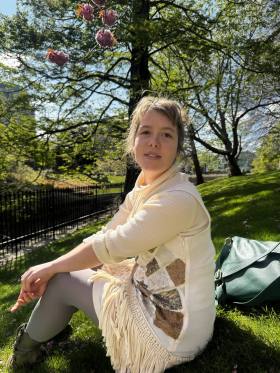
Project: Chemical modifications of next-generation drugs that will improve cancer treatments
Supervisor: Dr Nick Green, Department of Chemistry, Division of Sciences
One in three New Zealanders are expected to be diagnosed with cancer in their lifetime and Māori and Pacific peoples are more likely to be diagnosed with cancer than other groups. Oligonucleotide therapeutics is one of the most exciting developments in medicine because it has the potential to treat a broad range of diseases, including cancer. An obstacle in the development of these treatments is that our cells have evolved to protect themselves from naked oligonucleotides like RNA and DNA. To circumvent this, oligonucleotides, such as the mRNA in COVID-19 vaccines, are encapsulated in a “lipid nanoparticle”, essentially a protective oily ball, that delivers them safely to cells.
This project will develop a new way to modify oligonucleotides, enabling their delivery to cells and release of payload without lipid nanoparticles. This will render oligonucleotides more effective, cheaper, and modifiable to target many different types of disease.
Professor Ailsa Goulding
Matthew Bradley
Project: Unravelling the role of large genome deletions (LGDs) in drug-resistant Mycobacterium tuberculosis isolates
Supervisor: Assoc Prof Htin Lin Aung, Department of Microbiology & Immunology, School of Biomedical Sciences
Tuberculosis (TB), caused by Mycobacterium tuberculosis (Mtb), is a pressing global health issue that affects millions worldwide. Unfortunately, the increasing incidence of drug-resistant TB (DR-TB) makes treatment both difficult and costly. Genomic sequencing of Mtb has identified large genomic deletions (LGDs) in some DR-TB isolates, affecting genes thought to contribute to bacterial virulence and survival. However, it remains unknown whether these deletions actively drive resistance or are a product of random chance.
This project will determine the functional role of genes affected by LGDs by using a CRISPR interference (CRISPRi) system. CRISPRi enables targeted gene silencing through the use of a deactivated Cas9 protein guided to specific DNA sequences by short RNAs. Unlike genome editing, CRISPRi does not change the DNA sequence, instead it prevents transcription of the target gene.
This research project involves the design of guide RNAs (sgRNAs) targeting selected Mtb genes, cloning into CRISPRi plasmids and transformation into a model bacterial system (Escherichia coli). This will verify if silencing these genes mimics the phenotypes observed in drug-resistant strains. Defining the impact of LGDs is essential for assessing their possible contribution to antimicrobial resistance and may inform the development of targeted diagnostics and treatments for tuberculosis.
ACE Shacklock Charitable Trust and Estate of Shona Anne Rowley
Megan Lilly

Project: Investigating FN14 as a Driver of Malignant Cell Behaviour in Triple Negative Breast Cancer
Supervisor: Assoc Prof Heather Cunliffe, Department of Pathology, Dunedin School of Medicine
Triple Negative Breast Cancer (TNBC) is a distinct subtype of breast cancer characterised by a lack of expression of three important receptors, limiting treatment opportunities and typically affects younger women. Despite making up only 15% of breast cancer diagnoses, it’s disproportionally responsible for 40% of breast cancer-related deaths, which is largely due to its fast and aggressive growth. To improve patient outcomes and develop evidence-based targeted therapeutics, identification of key biological drivers is required.
Promising research in the Cunliffe laboratory has identified the cell surface receptor, Fn14, is abnormally overproduced in 75% of invasive breast cancers but not in healthy breast tissue. The Fn14 receptor controls biological pathways which have a known involvement in cancer progression, making it an ideal target for novel therapies. Recent research has also specifically identified a link between the Fn14 overproduction and metastatic spread of TNBC to distinct organs, providing avenues for further research to determine how to best halt this process and improve patient survival.
This project will investigate the effect of a deliberate removal of the gene encoding Fn14 has on TNBC cell malignant behaviour. Using TNBC cell lines from the Cunliffe laboratory, with and without confirmed CRISPR-Cas9 knockout of the Fn14 gene, we will perform a series of experiments to assess differences in malignant behaviour in laboratory culture, including measurements of cell invasion capacity, movement, and rate/ability of for tumour formation. This pre-clinical work will serve as a model for durable pharmacological targeted inhibition of Fn14 in patients with TNBC.
Kākāpō Consulting
Norah Lee

Project: Is any too many? Aotearoa Needs Better Access to Dilation and Evacuation to Avoid Hysterotomy Use for Later Abortion Care
Supervisor: Dr Helen Paterson, Department of Obstetrics, Gynaecology and Women's Health, Dunedin School of Medicine
Later abortion care, the termination of pregnancies after 14 weeks, comprises an important part of reproductive healthcare. It can be provided surgically through dilation and evacuation hysterotomy or via medical induction. The safest and internationally recommended surgical procedure is dilation and evacuation (D&E), where trained providers remove foetal tissue under ultrasound guidance.
However, D&E is commonly unavailable in Aotearoa due to limited training pathways. Currently, formal training is only offered through the RANZCOG Sexual and Reproductive Health Advanced Training Pathway that has no training sites in Aotearoa, and a recently developed NZCSRH module.
A hysterotomy involves a vertical uterine incision, typically reserved when other methods are unavailable or have failed. It carries significant risks such as excessive bleeding during the procedure and potential of uterine rupture in future pregnancies. The lack of D&E providers may mean that patients in Aotearoa seeking later abortions must undergo unnecessary hysterotomy or experience travel burdens for appropriate care access.
This project will explore the incidence and geographical distribution of later abortion procedures, particularly hysterotomy, performed between 14 and 22+6 weeks’ gestation in Aotearoa. In Aotearoa, current national abortion reporting does not capture this procedural- level information. Descriptive statistics will be used to analyse the findings then compared to international abortion care guidelines. This project aims to determine whether hysterotomy use reflects a gap in provider training. Findings may support the argument for including funded and required D&E training in the FRANZCOG curriculum to improve access for safer and more equitable later abortion care across Aotearoa.
Aotearoa Gaming Trust
Sam Meikle
Project: Investigating altered microglial synaptic pruning during neurodevelopment in a PCOS-like model
Supervisor: Prof Rebecca Campbell, Department of Physiology, School of Biomedical Sciences
Many long-term or chronic diseases may begin during early development before and shortly after birth. Because brain development is complex and carefully timed, it is particularly vulnerable to long-lasting issues if there are disruptions during these critical windows.
One important process in brain development is synaptic pruning, where unnecessary connections between neurons are removed to refine brain networks into their adult form. This pruning is done by microglia, immune cells in the brain which perform many roles involved with establishing and maintaining healthy brain function.
Previous studies have linked problems with synaptic pruning to brain disorders like autism, schizophrenia, and Alzheimer’s disease. Recently, this link has been extended to polycystic ovary syndrome (PCOS), a common hormonal disorder affecting 4-20% of reproductive aged women worldwide. PCOS carries a range of severe symptoms and is a leading cause of infertility.
Despite the prevalence and severity of PCOS, the exact causes of this disease remain unknown. However, PCOS is strongly connected to excess androgen (male hormones) exposure during early development. It is thought that this exposure affects the brain circuits which control reproduction, which show altered activity in PCOS, possibly as a consequence of how their neural connections are shaped by microglial pruning. This project will investigate whether microglial pruning is altered in the central reproductive network in an animal model of PCOS exposed to excess androgens before birth.
Anonymous Funder
Sasha Anisimova

Project: Does Vaping Help Smokers Quit? Real-World Outcomes and Health Impacts in the Dunedin Study
Supervisor: Prof Bob Hancox, Department of Preventive & Social Medicine, Dunedin School of Medicine
We will examine whether vaping helps people quit smoking in everyday life using data from the Dunedin Health Study. While research in controlled settings suggests that vaping can be an effective quitting method, not much known on how beneficial it is the real world. This is because of differences in device quality, nicotine strength and habits of users.
The topic is made more important in currently by the 2023-2024 repeal of smokefree laws in New Zealand, which places more reliance on individual level quitting strategies such as vaping. Therefore it is important to weigh the potential benefits of vaping against reported health harms and broader social effects, such as perpetuation of health inequalities, youth uptake and dual use of smoking and vaping.
We will focus on participants now aged 52 to analyse their success in quitting smoking over a 7 year period. We will compare success in vapers and non-vapers, investigate the influence of factors like gender, socio-economic status and previous quit attempts, and look at patterns of dual use and long term vaping. This study will further explore whether using vaping to quit smoking is associated with an improvement in respiratory symptoms.
Marsh Family Charitable Trust
Tabitha Leinfellner
Project: The clinical significance of an emergency department pathway for symptomatic first trimester pregnancy patients
Supervisor: Dr Sierra Beck, Dunedin School of Medicine
My research project looks at evaluating a pathway that was implemented in the Dunedin Hospital to streamline the care of patients in their first trimester of pregnancy who come to the emergency department (ED) with abdominal pain and/or vaginal bleeding. It has been shown that the use of point-of-care ultrasound (POCUS), a type of imaging, can help to identify if the baby is intrauterine or in an unknown location, this being a critical first step in the treatment when these patients come to the ED.
This research would assess the implemented pathway, which includes the use of POCUS, to compare primarily if through the pathway there was a reduction in the amount of time spent by the patients in the ED. Alongside this, several other factors including admission rates and the number of patients cared for by different types of clinicians will be compared. The accuracy of the POCUS images will also be assessed to see how accurate they were in giving the right diagnosis. Overall, this research could prove either the benefit of this implemented pathway in aiding the safe treatment of pregnant patients who come into the ED with some complications and show the beneficial nature of using POCUS in these situations, or that the pathway changed very little to what was done beforehand. Critically reviewing the care of these patients will also help to inform future quality improvement projects.
2024/2025 Summer Scholarships

Professor Ailsa Goulding
Abraham Siaw
Project: Unravelling the role of large genome deletions (LGD) in drug-resistant Mycobacterium tuberculosis isolates
Supervisor: Assoc Prof Hitin Li Aung, Department of Microbiology and Immunology, BMS
This research project aims to understand the role of large genome deletions (LGD) in the drug-resistant Mycobacterium tuberculosis (DR-TB) in New Zealand and the Pacific region. In New Zealand, most DR-TB cases come from people born overseas, particularly from the Pacific region. The Aung Lab has conducted a genome sequencing study of DR-TB isolates across high, middle, and low TB-burden countries, including New Zealand and Fiji, using short-read Illumina sequencing. The study found more than a 5kb genome deletion in a DR-TB strain from New Zealand and the Pacific region that might contribute to drug resistance in Mtb. However, due to the limitation of short-read Illumina sequencing, there is a risk of sequencing errors that provide false-positive results. To accurately identify the significance of teh LGD, the research will conduct long-read DNS sequencing with Oxford Nanopore technology (ONT), which can span large variants and cover the sequence gaps missed by short-read sequencing. Identifying LGDs in DR-TB helps in understanding their role in antimicrobial resistance in Mtb. This understanding could lead to more effective public health strategies and treatments, ultimately helping to control the spread of drug-resistant TB in New Zealand and the Pacific region.

Aotearoa Gaming Trust
Ally Genet
Project: The Role of Protein Synthesis in Impairments of Memory Mechanisms
Supervisor: Prof Cliff Abraham, Department of Psychology, Division of Sciences
Synaptic plasticity refers to the activity-dependent enhancement or reduction of connections between brain cells. By extension, metaplasticity is the brain’s ability to regulate its own synaptic plasticity over time that is critical for learning and memory.
Certain brain activities have shown to suppress synaptic plasticity, and this particular metaplasticity mechanism is linked to the inhibition of memory-related synaptic plasticity seen in Alzheimer’s and related dementia models. The mechanism of the metaplasticity effect is unknown however, it appears to be linked to the production of certain proteins made within brain cells. In particular, pro/brain-derived neurotrophic factor is a specific protein of interest, with its role in synaptic plasticity being analogous to the metaplasticity impairment seen in Alzheimer’s. However, the contribution of abnormal pro/BDNF synthesis on cognitive decline still needs to be confirmed.
The current research project will use mouse models to further understand these processes. Normal control mice will be compared with genetically altered mice who lack the metaplasticity effect to observe any existing protein synthesis differences within the hippocampus, a brain region that is impaired in Alzheimer’s disease. By ethically preparing brain slices and using specific labelling techniques, the aim is to pinpoint how and when proBDNF is produced in hippocampal brain cells and whether this may play a role in inhibiting memory-related brain changes. Overall, this research could help identify new treatment targets for conditions like Alzheimer’s disease, which is estimated to impact 170,000 New Zealanders by 2050 (Alzheimer’s New Zealand, 2023).

Aotearoa Gaming Trust
Asha Bhakta
Project: Determination of the molecular mechanisms underpinning bacteriophage hitchhiking
Supervisor: Dr Suzanne-Louise Warring, Department of Microbiology and Immunology, BMS
This project explores the mechanisms of bacteriophage ‘hitchhiking’, where bacteriophage (viruses that infect bacteria), attach to motile non-host bacteria for enhanced environmental speed, beyond what is observed with passive diffusion.
While little is known about this process, preliminary data suggests that key phage proteins may play a pivotal role. Specifically, the T4-phage hoc gene has been identified as crucial for binding to and carriage by the non-host bacterium Pseudomonas fluorescens. However, it is unclear if similar genes in other phages have the same function. To test this, we have identified hoc homologue proteins in Escherichia coli phages Bas44 and Bas63. This project aims to delete these proteins via gene knockouts and assess the effects on phage binding and carriage in spatial assays. Understanding phage hitchhiking could significantly impact phage therapy, an emerging antimicrobial strategy targeting drug-resistant bacteria like E. coli. Phage therapeutic effectiveness against multi-drug-resistant bacteria is promising, but challenges include inefficient delivery, poor pharmacokinetics and bacterial resistance. By investigating phage hitchhiking, this research seeks to improve phage delivery systems, enhancing the efficacy of phage therapy. Further exploration of proteins involved in bindings between E. coli phages and P. fluorescens would be groundbreaking, offering valuable insights into phage ecology and contributing to development of more effective therapeutic application of phages.

Walsh & Beck
Connor Nicholls
Project: Calcium channel-mediated plasticity in a model of frontotemporal dementia
Supervisor: Dr Owen Jones, Department of Psychology, Division of Sciences
Frontotemporal dementia (FTD) is a group of diseases in which the frontal and temporal lobes of the brain degenerate, causing progressive and devastating cognitive problems, and eventually death. Sadly, no effective treatments exist.
A main culprit in FTD is tau, a protein which normally stabilizes nerve cell structure. In FTD, genetic mutations cause tau to clump together, disrupting normal processes and damaging brain cells. Mice with these same toxic tau mutations show similar pathological changes. Typically, these mice show disrupted functions of synapses, the connections between cells that are strengthened during learning. This means neurons cannot communicate properly, or effective store information. Cognitive function therefore becomes impaired. Unfortunately, most information about toxic tau comes from investigating older animals, meaning we don’t know much about the early stages of FTD pathology. Unexpectedly, our lab discovered that certain calcium channels are overly engaged in young FTD model mice, and drive changes in synapse strengthening and the generation of nerve impulses. This is important, as calcium entering through these channels can be toxic, meaning their prolonged and repeated activation could be driving the later death of brain cells in the FTD model mice. We know that toxic tau causes a string of biological events which results in calcium channel overactivity. We want to see whether inhibiting this chain of events normalises the effects of calcium channel activation in young FTD model mice. If successful, we may reveal new drug targets for treating FTD by stopping harmful changes early on in the disease.

Deloitte
Emma McKay
Project: The Availability of Effective Emergency Contraception in Aotearoa New Zealand: A qualitative study
Supervisor: Dr Helen Paterson, Department of Women's and Children's Health, DSM
Emergency contraception can be used after unprotected sexual intercourse to prevent an unwanted pregnancy. In Aotearoa we have two types of emergency contraception available; the first is a pill that is taken orally known as levonorgestrel, and the second is the copper intra-uterine device (IUD) which is inserted by a health professional into the uterus. The oral pill is more commonly used for this purpose since it is easier to obtain than the copper IUD, however it is not as effective if taken beyond three days after unprotected intercourse, and if the individual taking it weighs more than 70 kg. This is a problem as the average weight for women in Aotearoa is about 75kg (health survey) and even higher for Māori and Pacific women, creating a barrier to accessing effective and equitable emergency contraception for these populations. A survey on emergency contraception was carried out earlier this year, and the results show that there are significant barriers preventing people from accessing emergency contraception in Aotearoa. This indicates a need for a new oral pill to be available in Aotearoa, known as EllaOne®, which can be taken up to five days after unprotected intercourse and works better in those over 70 kg. In order to expand on the survey results, this research will involve recruiting participants and then interviewing them so that this data can be used alongside the survey data in a Pharmac application to get EllaOne® funded.

OMRF Iverach
Janaya Mitchell-Byrne
Project: Timely intervention, monitoring and education matters in Multiple Sclerosis - Standards of care in newly diagnosed MS in the South Island of New Zealand 2022-2024
Supervisor: Dr Sarah Buchanan, Department of Medicine, DSM
Multiple sclerosis (MS) is an incurable chronic inflammatory disease. MS is caused by an autoimmune reaction, which means the body mistakenly attacks itself, along with a combination of viruses, environmental factors, and genetics. The areas of the body that are attacked are the brain and spinal cord, specifically the fatty substance called myelin that surrounds and protects the nerves. MS is a very unpredictable disease, as it affects various areas of the brain and spinal cord, resulting in a wide range of presentations in different individuals.
This study aims to assess standards of care against the internal consensus standard for newly diagnosed MS patients in the South Island. The internal consensus for standards of care includes three levels: core (minimal care), achievable (good care) and aspirational (high-quality care). Additionally, the study aims to evaluate differences in quality of care among subgroups at risk of inequities and regional variations in newly diagnosed MS patients. The subgroups to be explored for inequities and barriers to care include ethnicity, socioeconomic deprivation, and distance to treatment centre.
Data will be collected from the three main databases in the South Island that contain information on newly diagnosed and clinical follow-up patients. Data collected will include time to diagnosis, initiation of treatment, follow-up, and subgroup information. Data will be compared to international standards of care to assess the levels of core, achievable, and aspirational care. The study will identify areas of need and inequities and will be valuable for informing resource allocation in regional areas.

Healthcare Otago Charitable Trust
John Clemance
Project: A clinical audit of patients listed for total hip replacement to ascertain presence of Developmental Dysplasia of the Hip
Supervisor: Assoc Prof Sebastian Lippross, Department of Surgical Sciences, DSM
Hip dysplasia in Aotearoa is hypothesised to contribute to over 10% of total hip arthroplasty (hip replacements) cases later in life. Misdiagnosis or residual dysplasia can predispose individuals to early-onset hip osteoarthritis (destruction of cartilage). The link
between hip dysplasia (lateral deviation of the head of ball and socket joint) and osteoarthritis is complex, likely involving abnormal biomechanics and shear forces.
In Aotearoa, there is a lack of data in this field, particularly concerning its impact on Māori. Our study aims to gain greater insight into these effects by reviewing X-rays to determine the prevalence of hip dysplasia in adults, including subcategories such as Māori. By establishing the prevalence, we can identify the need for new methods and understand the potential effects of misdiagnosis on Aotearoa and Māori specifically. This information could help prevent the severity and number of total hip replacements, reduce surgeries, maintain function, and enable lives with fewer comorbidities. The data collected will provide a clearer picture of the extent of the issue and help us determine if there is a need for improved diagnostic techniques or interventions.
If our hypothesis is confirmed by the data, it will allow us to question and potentially improve our screening methods and standardisation. This could involve considering techniques such as the Graf screening technique used in Europe. By better understanding the prevalence and impact of hip dysplasia, particularly among Māori, we can work towards reducing the incidence of hip osteoarthritis and the need for surgical interventions.
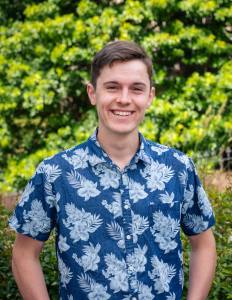
Aotearoa Gaming Trust
Luke Geddes
Project: Investigating neuron-astrocyte crosstalk in Parkinson's disease
Supervisor: Dr Indranil Basak, Department of Biochemistry, BMS
A neurodegenerative condition with no cure, Parkinson’s Disease (PD) is a debilitating disease disproportionately affecting men which will dramatically increase in prevalence across New Zealand in the coming years.
Dr Indranil Basak leads a research team at Otago, determined to improve our ability to model PD. Skin cell-derived stem cells can be reprogrammed into different human brain cell types like neurons and astrocytes, thereby providing a way to determine how PD symptoms develop from specific genetic mutations. There is a lack of clarity, however, as to whether the neuronal death in PD is associated with astrocytes interacting directly or indirectly with neurons.
Dr Basak's group have successfully established a direct and indirect co-culture of human astrocytes and neurons to study PD. In this summer internship, I will track morphological changes in human neurons cultured directly with astrocytes deficient of a protein leading to PD-like cellular changes. To study the neuronal changes, I will gain a high level of proficiency in immunocytochemistry critical for detecting proteins of interest, which can indicate whether neurons and astrocytes are interacting directly or indirectly.
Continuing the work of current members of Dr Basak’s group, this project endeavours to chart how cells interact with each other in PD alongside teaching myself valuable lab techniques essential for future projects with Dr Basak. Understanding the contribution of different brain cells in the development and progression of PD will enable us to develop more targeted therapies in PD.

K and J Scott Family Trust
Nicole Whittaker
Project: Acetylation in inflammasome-mediated sensing of influenza virus infection
Supervisor: Assoc Prof Matloob Husain, Department of Microbiology and Immunology, BMS
Influenza A virus (IAV) has been endemic in human populations for centuries and is expected to remain so for the foreseeable future. Seasonally, the flu puts a huge strain on the healthcare system and can be very dangerous for those who are young, old, or immunocompromised. Therefore, research on IAV should be at the forefront of our minds. Additionally, IAV remains a pandemic threat, as it easily mutates due to its highly malleable genome. It has broad host range, inhabiting animals in the water (seals, waterfowl), land (humans, pigs, chickens, cats, horses), and air (birds, bats). IAV’s plastic RNA genome and numerous hosts mean that it can emerge in various forms with new mutations and behaviours, which causes reduction in the efficacy of vaccines and emergence of resistance to antiviral drugs. Therefore, it is important to continue studying IAV biology in the host to understand its pathogenesis and develop alternative antiviral strategies.
During IAV infection, the first step in the host innate immune response is the sensing of virus particles by intracellular receptors, one of which is the inflammasome. This research project aims to better understand the molecular mechanisms of the sensing of IAV particles by inflammasomes, and to determine whether those mechanisms could be targeted for anti-influenza strategies. For this, a physiologically relevant cell culture model and contemporary molecular biology techniques will be used, and the data will be analysed for statistical significance.

Professor Ailsa Goulding
Qiyue (Teresa) Gu
Project: The optimal patient position in the quantification of venous reflux using non-invasive ultrasound
Supervisor: Gerry Hill, Department of Surgical Sciences, DSM
Venous disease is common problem within our community. The gold standard to help manage this problem is to perform a non-invasive venous ultrasound scan to determine the function of the lower limb venous system. Poor function is defined as reverse flow
(reflux) in veins, and the duration of reflux is important. What is not clear, is the best way to perform this test. Some suggest that it should be conducted whilst standing, whilst others suggest that a tilt-bed will be sufficient. This continues to cause debate
and hence it is important to measure what difference the patient position can have on the functional values (i.e. reflux times).
In this project reflux time will be measured in patients with known venous disease, when lying down and standing up, and four in between tilted positions. The idea is that reflex would be worse when standing up as gravity will affect the veins more.

Aotearoa Gaming Trust
Shivannee Ganeshan
Project: Identifying novel treatment options for carbapenemase-producing WHO critical pathogens in Fiji
Supervisor: Prof James Ussher, Department of Microbiology and Immunology, BMS
The proposed research project aims to investigate the susceptibility of various carbapenemase-producing gram-negative bacteria to a panel of novel antibiotics. The bacterial strains in focus include Escherichia coli, Klebsiella pneumoniae, Acinetobacter baumannii, and Pseudomonas aeruginosa. These strains are significantly known for their resistance to carbapenems (a form of beta-lactams) and pose as a higher risk. In a study, 32% of patients infectedwith these strains died within 14 days of admission. This signifies the
severeness of these bacteria. With the importance of discovering more about these strains of bacteria and contributing to treatment, it has led us to the question, “What antibiotics would be effective in treating these carbapenemase-producing gram negatives?”. These isolates will be sourced from a culture collection curated by Saki with samples originally from Fiji. The antibiotics being tested encompass a range of new and promising compounds, such as minocycline, eravacycline, tigecycline, cefiderocol, sulbactam-durlobactam, aztreonam, and ceeazidime-avibactam. The susceptibility testing will be conducted using a combination of disc diffusion, E-tests, and broth microdilution methods which would help both verify and quantify the effectiveness of antimicrobials ensuring comprehensive and accurate results. This research is pivotal in identifying effective treatment options against these resistant pathogens, potentially guiding future clinical practices and contributing to the global effort in combating antibiotic resistance.
2023/2024 Summer Scholarships

OMRF Wilkinson
Amy Hoi-Yan Choi
Project: The Relationship Between Vision Loss and Dementia
Supervisors: Dr Nick Cutfield and Dr Francesc March de Ribot, Department of Medicine, DSM
Dementia is a key challenge to healthy ageing, and the lack of treatment options makes prevention a strong public interest. Several studies have shown that correcting sensory impairment, including hearing loss and, more recently, vision loss, is a potential approach to reducing dementia risk.
The aim of this project was to explore how vision impairment affects rates of dementia diagnosis in older New Zealanders. We used the interRAI database a mandatory health questionnaire routinely-collected. The data analyzed has included 469,817 analysis between 2016 - 2020. We found that increasing severity of visual impairment was correlated to an increasing prevalence of dementia, with a stronger trend in Māori and Pacific ethnic groups.
In contrast to this trend, we found that the group with no vision had a lower rate of dementia diagnosis. This could have been due them having a greater chance of being sampled with their admission to long-term residential care. As the ‘no vision’ group was younger on average, we proposed that despite vision negatively affecting independence, health management, and physical activity, which are key dementia risk factors, early complete vision loss may affect influence other risk factors differently compared to later onset, progressive vision loss.
Hearing loss and vision loss affect social connection, mediating the risk of dementia. The effects of hearing loss are more significant in mid-life than late life, possibly because social events tend to occur in louder environments, imposing more social isolation in mid-life. Thus, we suggest that the onset of vision impairment could impact dementia risk through differential effects on social connection. Retention of more friends may be more likely at younger ages, and friendship has been found to be more influential in adapting to vision impairment than other relationships. Depression is another key risk factor for dementia, and it is correlated with earlier stages of adaptation to sensory impairment. Younger people losing all vision are therefore may have more sufficiently adapted to their visual function, having less consequences on depression and therefore dementia development.
Early visual loss is correlated to reorganisation of brain structure and function, which may mitigate the mechanisms which sensory impairment is proposed to contribute to dementia.
The relationship between the severity of vision loss and modelled proportions of dementia was consistent with other studies. As our study is not longitudinal, we cannot ascertain causation and studies following cohorts of people with vision loss over time are needed to confirm that the visual impairment precedes dementia. There is increasing evidence that preventing or treating vision loss will benefit cognitive health on a population scale. In light of recent studies showing that cataract surgery reduces dementia risk by 30%, promoting more public funding surgeries would be a significant improvement.

Marion Rhodes Memorial Scholarship
Andrew Yip
Project: How does MKRN1 label other proteins for destruction?
Supervisors: Professor Catherine Day and Dr Fareeda Barzak, Department of Biochemistry, BMS
Our bodies are made of around 36 trillion cells, each of which performs a specific function to keep us alive. Proteins are essential biomolecules that are within all of our cells that make these functions happen. To ensure that the right processes are happening at the right time, there are a series of proteins that can regulate the abundance of other proteins. One key process that controls abundance is called ubiquitylation, which involves attaching a small protein called ubiquitin to other proteins. Once attached, a ubiquitin chain can be formed which signals the cell to destroy the substrate protein. This cascade involves three types of enzymes.
E3 ligases facilitate the attachment of ubiquitin to the target protein. With over 700 E3 ligases known, they have been shown to ensure that the correct protein is tagged with ubiquitin to maintain protein abundance. Dysfunctions in the E3 ligase family of proteins can lead to a multitude of diseases.
Makorin-1 (MKRN1) is a RING E3 ligase with five domains called zinc fingers (ZFs). The RING domain attaches ubiquitin to the target protein, while the ZFs assist with the functionality of the protein. MKRN1 specifically targets a protein called poly-A binding protein C (PABPC), which regulates the construction of proteins from mRNA. Studies of MKRN1 dysfunction have shown to be associated with many diseases, such as cancer and cardiac-related diseases. While much research has been conducted on the cellular functionality of MKRN1, the mechanism by which MKRN1 attaches ubiquitin to proteins is not well understood. This project aimed to identify if any ZFs are required to attach ubiquitin to proteins such as PABPC via the RING domain in MKRN1.
Throughout the project, we have identified domain boundaries by comparing sequences of MKRN1 between species, designed five constructs and purified full-length MKRN1 (FL-MKRN1) and RZ5, which was a construct containing the RING domain and ZF5. It was found that RZ5 was capable of forming ubiquitin chains, which suggests that ZF5 supports ubiquitin chain formation.
To determine if ZF5 is required for activity, we would need to compare it with the RING domain alone. We would also need to test other combinations of the five ZFs to see if any of the other ZFs support ubiquitylation from MKRN1. However, showing that ZF5 supports RING activity in MKRN1 provides valuable insight into how this protein functions and will support future research.

C&E Matheson
Ariana Tuson
Project: The Contribution of Protein Synthesis to the Impairment of Memory Mechanisms
Supervisors: Professor Cliff Abraham and Dr Shruthi Sateesh, Department of Psychology, Sciences Division
The hippocampus is a brain structure with a vital role in memory. Synaptic plasticity plays a key role in memory formation. Memories are formed by altering connections between nerve cells, and long-term potentiation (LTP) can strengthen these connections. Prior neural activity (priming) can influence synaptic plasticity and inhibit subsequent LTP, a phenomenon known as metaplasticity. Protein synthesis plays a vital role in regulating synaptic strength and plasticity thresholds (Abraham & Bear, 1996). Previous research has found protein synthesis in the hippocampus to be important for one form of metaplasticity, but the location, the protein being synthesised, and the type of cell involved (neuronal or astrocytic) are unknown. This research focused significantly on the Cornu Ammonis (CA1) hippocampal region. The primary objective was to first confirm if there is protein synthesis that is occurring post-priming, the subregion where it is occurring in the hippocampus, and whether it is an astrocyte-mediated process. The second objective was to identify which protein is being synthesised. There is evidence that pro-brain-derived neurotrophic factor (pro-BDNF; a precursor of BDNF) impairs LTP (Xie et al., 2015). Thus, my research focused on the possibility of pro-BDNF being the synthesised protein. I used mice without the inositol trisphosphate (IP3) receptor type 2 (IP3R2-KO; present only in astrocytes), in which the metaplasticity effect is absent (Jones et al., 2023). These mice were compared to their normal counterparts (Wild-type (WT)). My study hypothesised that priming stimulation increases protein synthesis in WT but not KO mice. I also hypothesised that the newly synthesized protein is pro-BDNF, with astrocytes playing a role in this process. To explore these objectives, I first undertook electrophysiology to confirm elevated protein synthesis by priming stimulation. This was followed by immunofluorescence staining to further identify the location and identity of protein synthesis. This was done using antibodies to NeuN (a neuronal marker), GFAP (an astrocytic marker), puromycin to label newly synthesised proteins, and pro-BDNF. Results showed no significant priming-induced LTP differences between KO and WT mice, with no notable CA1 differences, particularly between puromycin and pro-BDNF staining. However, there was a significant puromycin staining disparity in the dentate gyrus (DG) subregion of the hippocampus between KO test pulses and KO priming, opposing the initial hypothesis (that this staining would be higher in WT mice). From staining observations, it appears there is an overlap between puromycin and both astrocyte and neuronal bodies, and thus protein synthesis may be occurring in both locations. Furthermore, pro-BDNF staining appears to coincide with puromycin staining, but little conclusion can yet be drawn from this without more specific co-localisation methods conducted. The hypothesis of astrocytic involvement is partially supported by qualitative conclusions of astrocytic staining, but cannot be entirely confirmed as the location is still unclear. This research suggests that the absence of IP3R2 does not significantly impact protein synthesis activity in CA1 under the conditions tested. In the broader context, this may imply that other mechanisms or compensatory pathways may be regulating protein synthesis, highlighting the complexity of synaptic plasticity regulation.

Platinum Recruitment
Bonnie Huang
Project: Investigating the effects of a novel targeted therapy combined with a conventional therapy in a subset of breast cancer
Supervisors: Dr Sarah Diermeier and Dr Kaitlyn Tippett, Department of Biochemistry, BMS
Breast cancer is the third most common cancer in New Zealand and accounts for more than 600 deaths every year. Triple negative breast cancer (TNBC) makes up ~15% of those cases. It is an aggressive subtype of breast cancer that is prone to spreading to other parts of the body. Patients with TNBC have limited targeted therapeutic options compared those with other breast cancer subtypes. This is because TNBC lacks the three markers present in the other breast cancer subtypes that can be targeted. Olaparib is one of the few targeted therapies available for a subset of TNBC patients but development of drug resistance in patients is a problem. A way to combat this is through combining treatments which reduces the likelihood of drug resistance developing and may make the treatment overall more effective.
Long non-coding RNAs (lncRNAs) are RNAs that do not produce a protein and are longer than 200 nucleotides. Some of them are highly tissue specific and are abnormally expressed in cancer cells. This makes them potential targets for developing new cancer therapies. Antisense oligonucleotides (ASOs) can bind to RNA and target these lncRNAs, therefore, can be used as a potential drug. I hypothesise that lncRNA targeting drugs can work synergistically with existing therapies such as Olaparib.
The aims of my project were to test whether a novel oncogene lncRNA target (lncTNBC3) is expressed in a TNBC cell line, can be downregulated by a specific ASO drug, and whether combination of the new ASO drug with Olaparib has a synergistic effect on cell growth.
We showed that lncTNBC3 was expressed in our model cell line. We discovered that our ASO drug reduced the levels of lncTNBC3 in the cells, and inhibited TNBC cell growth. However, when cells were treated with ASO and Olaparib together, there was no significant synergistic effect.
The next steps include experimenting with other concentrations of Olaparib to find the concentration at which synergistic effects can be observed. In addition to this, ASO2 may not work in synergy with Olaparib, so combinations with other available treatment options for TNBC patients such as Paclitaxel could be further investigated.

OMRF McQueen
Echo Kite-Bell
Project: Electronic patient healthcare information in Surgery. Cultural co-design of a patient centred health platform
Supervisors: Dr John Woodfield and Dr Kari Clifford, Department of Surgical Sciences, DSM
The aim of this study was to investigate whether integrating tikanga Māori (culturally appropriate practices) into an electronic health platform would enhance the user experience, particularly for those who self-identify as Māori. The health platform called ‘Go Well Health’ is currently utilised in the colorectal surgical department of Dunedin Hospital. It provides tailored educational information and support for patients throughout their surgical journey. Co-design of the original packs given to participants is underway, focusing on the incorporation of tikanga Māori, mātauranga Māori (Māori knowledge) and Te Reo Māori (Māori language).
Participants were contacted based on a series of selection criteria, one of which was identifying as having Māori heritage. They were asked to read five sets of documents comparing the original versions to the co-designed versions. A short survey was conducted after each set and a final interview was held.
This study was a collaboration between Māori who had colorectal surgery within the last 10 years, their immediate family/friends, and the surgical sciences research department. Co-design studies have been highlighted as the best way to work with Māori regarding their health. It gives Māori the chance to have a say in their own health narrative, and allows them to be heard, listened to and most importantly, understood.
The key findings of this study were as followed:
- The inability to read Te Reo Māori proved to be a barrier for some individuals, affecting their ability to engage in the co-design documents.
- The co-designed document was praised for its easy readability and cultural inclusivity.
- The inclusion of tikanga Māori, mātauranga Māori and Te Reo Māori received largely positive feedback from participants.
It is widely recognized that disparities exist concerning Māori health statistics. It is acknowledged as a multifaceted issue with various layers to consider. Several areas have been highlighted as contributors; socioeconomic elements, lifestyle choices, healthcare accessibility, and discriminatory practices(1) all playing a major role. The expectation is that through enhancing the user experience, individuals would be more likely to participate in the online platform, therefore adhere to recommendations, consequently reducing health disparities between Māori and Non-Māori.
One of the primary challenges encountered in this study was the limited number of eligible participants, which consequently influenced the recruitment. Upon reviewing the initial data, it became evident that there were minimal individuals with Māori ancestry available for contact. This study would therefore benefit from employing a combined approach, incorporating data from other regions who have a greater proportion of Māori. Preliminary findings pointed towards the cultural integration benefiting the user experience, particularly those of Māori ancestry, however further study is recommended to understand how beneficial it may be, and to explore the delicate nature of implementing such a program.

Walsh & Beck
Emily Light
Project: Incidence of umbilical cord insertion variations and their association with adverse outcomes in Otago
Supervisors: Dr Celia Devenish and Dr Susan Craw, Department of Women's and Children's Health, DSM
The placenta is an essential organ for pregnancy which enables the baby to grow. Usually, it develops with a central umbilical cord insertion, but variations include insertion at the edge of the placenta (marginal cord insertion) or where the umbilical cord may not directly attach to the placenta because it divides in the surrounding tissue (velamentous cord insertion). The shape of the placenta disc may also be different. There could be an additional lobe connected to the main placenta (succenturiate lobe) or the placenta disc could be smaller, causing the membranes to fold back on itself (circumvallate placenta).
International research has shown cord insertion anomalies can increase the risk of adverse outcomes for the mother and baby. These include reduced fetal growth, fetal concerns in labour, emergency caesarean section, and the need for newborn resuscitation or admission to the neonatal intensive care unit. To our knowledge, there has been no research on ultrasound diagnosis of placenta and cord insertion anomalies and their association with adverse outcomes in New Zealand.
This study aimed to identify how common these placenta and umbilical cord insertion anomalies are in the Otago District and to investigate their association with adverse outcomes. We identified patients diagnosed with these conditions at their 20-week pregnancy ultrasound scan in the Otago district over 20 months between 1st January 2022 and 1st August 2023. We then found the total number of births in the Otago district during this time period to estimate how frequent these conditions were. At routine 20-week ultrasound, we found that 0.5% had velamentous cord insertion, 1.9% had marginal cord insertion, 0.2% had succenturiate placenta and 0.6% had circumvallate placenta.
Next, we looked at the association between abnormal cord insertion (marginal cord insertion and velamentous cord insertion) and adverse outcomes. This included emergency caesarean section, elective caesarean section, low birthweight, resuscitation of the newborn, NICU admission, fetal distress, and total fetal adverse outcomes. Our abnormal cord insertion group included 57 patients diagnosed at the 20-week pregnancy scan. Our comparison group included 2108 people who did not have these conditions at the 20-week scan. They all gave birth in Dunedin Hospital. Our study showed that there was no association between abnormal cord insertion and adverse outcomes. This result differs from international studies and likely occurred because of the small number of people in our exposed group. A larger multi-centered study in New Zealand would be recommended to clarify these results.
Interestingly, we found that the diagnosis of cord insertion anomalies at the 20-week ultrasound differed from what was reported at birth. We found that 8% of people who had a normal report at the 20-week ultrasound had the condition identified at birth. We also found that only 23% of people who had an abnormal cord insertion at the 20-week scan had a matching report at birth.
This study has provided important information about how common these conditions are in Otago and has highlighted the need for a larger study to be done in New Zealand.

Aotearoa Gaming Trust
Finlay Anderson
Project: Targeted next-generation sequencing as a diagnostic tool for multi-drug resistant tuberculosis
Supervisor: Dr Htin Lin Aung, Department of Microbiology and Immunology, BMS
Tuberculosis (TB), the disease caused by Mycobacterium tuberculosis is currently the leading cause of death from infectious disease. The usual treatment for TB consists of multiple injectable drugs which are administered daily for around nine months and is associated with a multitude of harmful side-effects and huge costs both for health systems and patients. Furthermore, resistance to these drugs is on the rise, making treatment considerably less effective and posing a major threat to the global fight against TB. Because of the financial burdens associated with treatment, many TB patients fail to adhere to this, further contributing to the rise of resistance in lower-socioeconomic regions where most TB cases occur.
In New Zealand, TB disproportionately affects marginalised communities such as refugees, Māori, and Pasifika. Thus, TB is as much an equity issue as it is a health issue, and fighting it requires consideration of a variety of determinants. To try overcome this, the World Health Organisation (WHO) recently recommended a shorter, entirely oral drug regimen for multi-drug resistant TB (MDR-TB) which exhibits resistance to two or more first-line TB drugs. However, resistance is already emerging for these drugs, some of which have no alternatives. Therefore, it is crucial that effective diagnostics are made available to accurately diagnose and treat MDR-TB to curb the rise of resistance to these vital drugs.
Oxford Nanopore Technologies (ONT) MinION device is the cheapest and most portable next-generation sequencing technology currently available and has been previously shown to effectively diagnose drug resistance. Furthermore, the WHO has recently endorsed targeted next-generation sequencing (tNGS) for diagnosis of MDR-TB. This project aimed to develop a tNGS platform using MinION to detect drug resistance to key drugs of the new oral regimen. This involved using polymerase chain reaction (PCR) to amplify specific genes which mutations occur in causing resistance. These genes are atpE, Rv0678 and pepQ for the drug bedaquiline, ddn and fbiA for delamanid and rrl and rplC for linezolid. We successfully amplified these specific genes, allowing us to sequence them (hence “targeted” sequencing). We then used a variety of software to visualise the sequencing data, confirm it was done correctly, and determine resistance status. We had difficulty figuring out the right conditions for PCR, however now that we have these optimised, the process would be relatively efficient to repeat. This is a crucial first step in developing MinIONs diagnostic capability for resistance to these drugs. The next step would be to streamline this process further by optimising PCR conditions for multiplex PCR, meaning all genes could be amplified simultaneously, shortening the diagnostic timeline. Another important next step is to explore the ability of MinION to perform tNGS directly from patient sputum samples, bypassing lengthy culturing and DNA-extraction procedures. Our results suggest that tNGS with MinION could make TB diagnostics more accurate and more accessible (both financially and operationally). Because it predominantly affects lower-socioeconomic regions with limited infrastructure, this could be revolutionary in the fight against TB, where the many complex factors contributing to disease cannot be overlooked.

Perpetual Guardian Foundation
Leesuk Isaac Kim
Project: Engineering of nanobody protein to block migraine signalling
Supervisors: Assoc Professor Peter Mace, Department of Biochemistry, and Dr Michael Garelja, Department of Pharmacology and Toxicology, BMS
The focus of my research is to design and engineer a nanobody protein, which is a smaller version of antibody, to bind to a neural receptor called CLR-RAMP1 which usually causes neural inflammation and migraine symptoms when it meets with its partner protein, CGRP. The nanobody that we design does a similar job as the CGRP, by binding to the CLR-RAMP1 receptor, however, does not cause migraine symptoms. Therefore, this provides a therapeutic effect by blocking migraine-causing CGRP from binding to its receptor CLR-RAMP1. A therapeutically approved drug, called Erenumab is also an antibody that treats migraine through the same mechanism. Therefore, this study will help deepen the understanding of the mechanism of Erenumab.
Furthermore, this research looks deep into designing a nanobody that can differentiate between CLR-RAMP1 and its twin brother receptor CLR-RAMP3. It was known studying CLR-RAMP3 may also help enhance migraine therapy.
The 10 weeks of my research starts from constructing, making, and purifying both the nanobody and the CLR-RAMP1 protein. I have been able to sequence the DNA, purify the proteins, and use yeast system to test whether the designed nanobody is competent to bind to the protein CLR-RAMP1.

MM & JH Hughes Family Trust
Katie Wong
Project: Understanding PBT2-Zn’s role in enhancing antibiotics against MRSA
Supervisors: Professor Greg Cook and Dr Scott Ferguson, Department of Microbiology and Immunology, BMS
Summary: Antimicrobial resistance (AMR) poses a major global health threat, reducing our ability to combat bacterial infections, and methicillin-resistant Staphylococcus aureus (MRSA) is a leading cause of AMR-related deaths. In New Zealand, rising AMR is expected to impact Māori and Pasifika communities disproportionately. Unfortunately, research and development of new antimicrobials have decreased over the past few decades, emphasising the need for alternative strategies. PBT2 is a zinc ionophore that transports zinc (Zn) ions across biological membranes, and PBT2 has been previously shown to act as an antibiotic adjuvant, effectively overcoming/breaking AMR in bacterial pathogens when combined with Zn. It has also been observed that the antimicrobial effects of PBT2- Zn are reduced when MRSA is supplemented with manganese (Mn). This is referred to as Mn rescue, and this process is not fully understood.
Aims of the Project: This research aims to understand the molecular and metabolic mechanisms behind breaking AMR, specifically focusing on PBT2-Zn (PZ) ability to render MRSA susceptible to otherwise ineffective antibiotics. Additionally, we aim to understand the role of Mn in this process. This aim will be achieved by identifying and characterising genes associated with Mn rescue in MRSA.
Main Findings: We have identified approximately 80 putative MRSA genes which we hypothesise are involved in Mn rescue, and five of these mutants were further characterised, including NTML1725, which has a non-functional Cytochrome D ubiquinol oxidase subunit II (cydD). This study utilised many complementary techniques, including screening, checkerboard synergy assays, and time-kill experiments to observe the effects of PZ and Mn on MRSA cell viability.
Key Points of Discussion: The research highlights the importance of Mn in the ability of PBT2-Zn to reverse antibacterial resistance in MRSA and potentially implicates a role for cydD due to its hypothesised role in bacterial metal ions. However, this study also recognises the need for further investigation, including statistical validation, ICP-MS analysis, and the generation of single- or double-gene markerless deletion mutations, to validate our findings further.
Conclusions and Recommendations: The study concludes that the identified genes involved in cell viability restoration under Mn supplementation require further characterisation and confirmation. Understanding the molecular mechanism that drives PBT2-Zn-mediated resistance reversal is crucial for advancing this work further. The broader implication of this work emphasises the importance of studying chemical adjuvants to revitalise existing antimicrobials, which will be critical for combating the AMR crisis. Future experiments should include additional biological replicates to reduce variation, detailed metal ion concentration analysis, and the creation of markerless gene deletion MRSA mutants to facilitate a more comprehensive understanding. This research provides valuable insights into potential avenues for overcoming antimicrobial resistance and underscores the urgency of addressing this critical health issue.

Healthcare Otago Charitable Trust
Lucy Simmonds
Project: Barriers and facilitators of compression stocking use in patients with disease affecting veins of the lower limb
Supervisors: Dr Jo Krysa, Dr Kari Clifford and Abby Currie, Department of Surgical Sciences, DSM
Compression Stockings are a key aspect of treatment for conditions associated with vein dysfunction in the legs. Their benefits in symptom relief and preventing disease progression are well documented. Despite this, adherence is poor. This project aimed to identify factors affecting stocking adherence, in the form of barriers and facilitators to compression stocking use.
Patients in Dunedin get their first pair of stockings funded, after which they self-fund further stockings, whereas Invercargill patients do not get any stockings funded. To determine the impact of this, the experiences of participants from Dunedin and Invercargill were compared. Furthermore, the vein clinics in Dunedin have noted several young patients employed at the freezing works coming in with severe disease likely associated with their occupation, which requires long periods of time standing still. This study aimed to get the freezing works involved, as well as to compare barriers for patients of varying ages.
Twenty-five participants were recruited and interviewed about their use of compression stockings. Through analysis of the interview transcriptions, three key themes were identified, and ten subthemes outlined below.
Theme 1: Physical Factors. Subthemes: symptom relief, discomfort, application difficulty.
Theme 2: Psychological Factors. Subthemes: sense of security, daily routine, appearance, interactions with health care workers, disbelief of efficacy.
Theme 3: External Factors. Subthemes: finances, post-surgical experiences.
Many of these themes are consistent with previous studies. The subtheme of having the compression stockings become a part of patients’ daily routine is a facilitator that has not been previously identified. Experiences with finances were similar between Invercargill and Dunedin participants as they described having to choose between purchasing stockings and various other necessities. Although Dunedin participants appreciated having the first pair funded, many wore stockings for several years, minimising the overall impact of having a single pair funded. The study also found that participants aged over 65 more frequently mentioned disease, such as arthritis, making it more difficult to put the stockings on. On the other hand, the subtheme of appearance was more frequently mentioned in younger participants. Many males cited appearance concerns regarding their gender expression due to stockings being traditionally associated with women’s clothing, which acted as a deterrent.
Despite numerous enquiries, the freezing works companies were not interested in taking part in the study. One current and one previous employee were recruited. During their interviews they discussed that the freezing works were not taking any steps to reduce the development of venous disease in their employees. They were uncertain whether the introduction of compression stockings for employees would encourage use.
This study consolidates much of the previous research, in addition to gaining a deeper understanding of the influence of age and sex. Areas for further research include the previously undocumented facilitator of stocking use being part of a patient’s daily routine, as well as more enquiries with freezing works companies.

Deloitte
Naomi Grambin
Project: Testing whether novel antimicrobial peptides are toxic to human cells or cause an immune reaction.
Supervisor: Dr Daniel Pletzer, Department of Microbiology and Immunology, BMS
The focus of this project was to discover whether novel antimicrobial peptides, so-called peptoids, can cause harm to human skin cells, alongside identifying whether their application interferes with the immune system. The study of peptoids is an attractive area of research for the development of new antimicrobial treatments, given the problems associated with the rise of antibiotic resistance in many high-risk microbes. The potential for peptoids to kill human cells has not yet been fully explored, therefore, part of this project was dedicated to exposing peptoids to human skin cells. Out of the fifteen peptoids tested, six of them did not cause the skin cells to die, at the tested concentrations. Therefore, these six would be the only suitable contenders to potentially becoming usable antimicrobial treatments. There is little to no previous research that was conducted to investigate the antimicrobial properties of three of the six peptoids that did not damage skin cells. Therefore, in the future, the ability to efficiently kill bacteria may be explored further for these peptoids, against skin-specific disease-causing bacteria. Their efficacy in killing those microbes will tell whether they can be further developed as tangible alternatives to antibiotics. The second part of this project was directed towards determining whether peptoids can assist the host immune system in fighting off an infection. Previous research with other peptoids showed that they could assist the immune system to fight off microbial infection at a faster rate. Therefore, it is a significant property for a novel potential antimicrobial treatment to have and warrants further investigation. Unfortunately, due to the short amount of time allocated to this part of the summer project, alongside difficulty in optimizing the specific experiment, it was not possible to determine the immunomodulatory effect of the non-toxic lead peptoids. Therefore, future directions would include the continuation of this project by further optimizing the experimental parameters. To conclude, during this summer project, a few properties of the fifteen peptoids were tested. This provided information on their behaviour upon contact with human skin cells, which aids in the development of a novel antimicrobial treatment. Although there remains room for more work to be done in this investigation of the tested peptoids’ properties, the data obtained in this project has provided a head start on the drug development process.

Aotearoa Gaming Trust
Noah Kelly-Foleni
Project: How does the X126 splice mutation impact cancer cells
Supervisor: Dr Sunali Mehta, Department of Pathology, DSM
Cancer affects thousands of people each year in New Zealand with 25,000 people being diagnosed each year. Within this group there are ethnic disparities, and some communities face a higher burden than others. The Pasifika community although having similar rates of cancer diagnosis compared to other ethnic groups have a much higher mortality rate for cancers such as breast, lung, uterine, stomach, and liver. This is due to many factors such as late screenings and diagnoses, socioeconomic factors, ease of health care factors etc. These factors make characterising mutations such as the TP53 X126 splice mutation important to study as it can lead to better understanding of cancer development and treatment.
The X126 splice mutation occurs in the TP53 tumour supressing gene. The TP53 gene produces a p53 protein which helps stress response such as DNA damage and helps maintain regular cell function. When this gene is mutated, it can cause disruptions to these functions and result in more aggressive cancers and poorer patient outcomes. Normally when activated the TP53 gene will create a message to make a p53 protein. However, when there is an X126 splice mutation part of the message (mRNA) is changed which means the instructions to build the p53 proteins and how much protein to build will be changed.
The aim of this project was to determine the influence of the X126 splice mutation on known p53 protein forms. This was done by first obtaining cells that had two normal copies of the TP53 gene (Wild type), cells with one normal copy of TP53 gene and one copy of the X126 mutated gene (heterozygous), and finally cells with two copies of the X126 mutated gene. Then I preformed RT-qPCR and ddPCR analysis which measure the type, amount, and number of messages sent by each of the cell types.
When compared to the wild type cells the heterozygous cells produced less mRNA in all of the target transcripts in both RT-qPCR and ddPCR. This implied that protein p53 levels would be low in these cells which could cause issues with cell function and potentially influence cancer development. The levels of target mRNA in the homozygous cells were shown to either be much higher or at a similar level to the wild type cells but could not be determined as the two measurement methods conflicted with each other. Because of these conflicting results the experiments will have to be repeated in order to find out what is truly happening in the homozygous cells.
In future it would be necessary to test the protein levels to see if the messages the mutant TP53 genes are sending are being utilised and to see what kind of proteins are being made as not all mRNA transcripts are necessarily made into proteins. It would also be necessary to sequence the whole mRNA message to see what messages are being sent as only parts of the mRNA transcript were being measured in this experiment.
Aotearoa Gaming Trust
Sana Atithi
Project: Deciphering the Brain’s Rapid Stress Response Circuit
Supervisors: Professor Colin Brown and Dr Joon Kim, Department of Physiology, BMS
Aim: This study explored the complexities of the brain's mechanisms in responding to stress, with a particular focus on identifying the neural pathways that facilitate rapid escape reactions when faced with stress. Understanding the stress circuits responsible for such behaviours is crucial for understanding mammalian survival strategies and illuminating how disruptions to these pathways could lead to dysregulated stress responses. Recent evidence has suggested that brain regions involved in detecting stress and escape motor control might be directly connected to orchestrate swift escape responses upon the onset of stress. This investigation aimed to determine the stress-escape circuit by employing a virus to deliver a fluorescent marker into specific neurons to map the pathway between the stress detecting areas and motor control regions.
Findings: Contrary to our expectations, we did not find evidence of a direct projection from the stress detecting areas and motor control regions. instead, our findings revealed the possible involvement of the thalamus (which is an integrative hub facilitating complex decision-making tasks) as an intermediary region within the stress-escape circuit.
Discussion: These findings challenge the traditional view that stress responses are mere reflexes. They suggest that the brain's response to stress involves a more sophisticated process evaluating a wide array of sensory inputs and potential outcomes to develop effective navigation strategies. This allows for a more adaptive approach and a better chance of survival.
Conclusion and Recommendations: Further research is needed to understand the importance of the thalamus in the stress-escape circuit. Our research has uncovered a previously unknown aspect of the brain's stress response network, enriching our understanding of how stress modifies behaviour in mammals. This work opens new avenues for research in this field to understand the stress response and address abnormal stress responses.

Aotearoa Gaming Trust
Sarah Grant
Project: Investigating the effect of antidepressants on lipoprotein metabolism
Supervisor: Professor Sally McCormick, Department of Biochemistry, BMS
There are several things that contribute to a healthy heart. Many people have heard of ‘good’ and ‘bad’ cholesterol, otherwise known as HDL and LDL, but there is another important one called lipoprotein (a) [Lp(a)]. Lp(a) looks similar to LDL but has a unique piece attached to it called apolipoprotein(a) [apo(a)]. Researchers have found that a lot of Lp(a) in plasma causes increased risk of heart disease. It has also been found that people with depression have higher levels of Lp(a). This means that people with depression are more likely to have heart disease. Recent studies have shown that serotonin-based antidepressants can cause liver cells to increase the amount of Lp(a) they clear from the blood. This could mean that the risk of heart disease decreases. The aim of this study was to find out if norepinephrine-based antidepressants functioned similarly. It was found that one norepinephrine based antidepressant called atomoxetine was able to increase the uptake of apo(a) up to a certain concentration. While these are early findings it could mean that both types of antidepressants have the ability to remove Lp(a) from plasma. This could translate to a lower chance of heart disease.

C&E Matheson
Solomon Filipo
Project: Electronic patient healthcare information in Surgery. Cultural co-design of a patient centred health platform
Supervisor: Dr Francesc March de Ribot, Department of Medicine, DSM
During my summer studentship, I was directed to complete two projects. The first piece was an editorial to the New Zealand medical journal highlighting the need for more population-based eye research in New Zealand. The main aims of this project were to evaluate the current state of eye health in New Zealand. The editorial is titled – Open your eyes: the need for population-based eye research in New Zealand. The main goals of this project were to get more equitable outcomes for Māori and Pacific eye health in New Zealand. The main findings from this editorial piece were that there is a current shortage of data on Pacific and Māori eye health in New Zealand. The current research shows that other public health efforts have been made for more equitable health outcomes. This piece highlighted the need for more data, as well as gave recommendations for more equitable health outcomes in the future. I hope to present this editorial at the Pacific medical conference, as well as the Royal Australian and New Zealand college of Ophthalmology conference in May.
The other project I completed was a report on the Mercy charitable trust in Dunedin. I was able to connect with the trust to reach the Pacific community of Dunedin to share data on access to visual aids, as well as the links between low vision and Dementia. The event was attended by 30 members of the Pacific community and robust discussion was facilitated on Dementia risk and eye health by me, Dr March, and guest speaker Dr. Xaviour Walker. The main aims of this project were to investigate the charitable trust and highlight the work they do for the local Dunedin community, within the field of Ophthalmology. The main findings from this report were the funding of 21 Cataract surgeries over the last 5 years. The surgeries that were funded was mostly for Māori and Pacific who would not usually be able to access their eye surgery in the public health system. Through this report, I was able to demonstrate a local need for more funding and research within the field of Ophthalmology. Furthermore, I was able to inform the public about important measures that need to be taken to prevent worsening vision. From networking with the local community through the trust, I am now able to plan more outreach sessions through the help of local Pacific organisations. In the future, hopefully this discussion can reach a national stage.

Dr Ailsa Goulding
Tessa Cloutman
Project: Examining a region associated with breast cancer susceptibility
Supervisor: Assoc Professor Anita Dunbier, Department of Biochemistry, BMS
One in nine New Zealand women will be affected by breast cancer over their lifetimes. Approximately 70% of these cases will be positive for the presence of the oestrogen receptor, particularly the oestrogen receptor alpha (ERα), which is coded for by the ESR1 gene. Exposure of these cells to the hormone oestrogen is known to promote tumour growth by activating the oestrogen receptor and inducing the proliferation and invasiveness of cells. Previous work has identified a genomic variant within an enhancer element upstream of ESR1, which is associated with breast cancer susceptibility. Enhancers are non-coding distal genetic elements that activate the expression of target genes. It is possible that this variant may therefore influence the expression of ESR1, hence affecting the development of breast cancer. This project aimed to investigate the influence of the risk variant on enhancer activity in this region.
The first stage of this project was to insert this potential enhancer element containing the variant into a circular piece of DNA known as a plasmid in a process called ‘cloning’. In this step of the cloning process, many copies of the region of interest (ROI) are amplified through a specific Polymerase Chain Reaction (PCR). However, as the ROI had a very similar sequence to other areas in the genome, I found that the PCR also amplified other off-target regions of DNA. This resulted in the first plasmids constructed containing inserts of inconsistent lengths ranging from 750 base pairs (bp) up to 1500bp. From this, the DNA mixture made from the PCR was purified to remove any DNA outside of the 1000-1200bp range before being used in a second cloning attempt. This was done to isolate only the 1112bp long region of insert. However, sequencing of the insert regions of the second group of plasmids revealed that they still did not contain the correct insert. This was explained by there being other DNA fragments of the same length as the region of interest within the DNA mixture used in the cloning, and hence remained in the DNA mixture following the purification. The PCR primers, the component of the reaction which give specificity to the PCR, were therefore redesigned to better target just the region of interest. Following the third cloning attempt, five out of the six plasmids made contained the correct insert and were therefore deemed successful. From the cloning procedure optimised during this project, the plasmids will be able to be used in future experiments to further explore if the variant influences enhancer activity. This work will help provide insight into the development of breast cancer and aid in the development of new treatments.

Rosey McConnon
Tom McDermott
Project: Are CAR T cells susceptible to natural killer cell mediated killing?
Supervisor: Professor Alexander McLellan, Department of Microbiology and Immunology, BMS
Chimeric antigen receptor (CAR) T cell therapy is a novel means of treating cancers involving the sampling of a patient’s blood and genetically modifying a specific subset of their immune cells (T cells) that are present within this blood sample. This modification allows these immune cells to recognise, target and kill cancerous cells, which are put back into the patient after being altered to allow them to clear out the cancer. While this has been shown to be successful in cancers of the blood and lymph, such as non-Hodgkin’s lymphoma, a major challenge facing this therapy is its effective application in solid tumours. A potential solution to this problem is combining the use of CAR T cells with other therapeutic cell types, such as Natural Killer (NK) cells. NK cells can readily be obtained from a patient or donor’s blood, with populations expanded and prepared for therapeutic delivery – however, their potential negative effects on CAR T cells require further investigation. For example, in a normal immune response, NK cells have been shown to inhibit T cells as a means of preventing an overpowered immune response (which can lead to further pathologies similar to septic shock). The aim of this project was to culture these two cell types together and determine whether therapeutically cultured NK cells had any killing action on CAR T cells, in order to guide how these two agents may be co-delivered (ie. whether this could be done simultaneously or staggered). We did not observe any killing of T cells by NK cells in our co-culture experiments, but instead the continued proliferation of both cell types. This suggests synergistic interactions between NK and T cells different to those seen during a typical immune response. This means that delivery of the two therapeutic cell types could be simultaneous, however, their interactions in the presence of a malignancy and proper in vivo investigations are necessary before this can be said with any confidence.
2022/2023 Summer Scholarships

Walsh & Beck Scholar
Alice Robinson
Project: Investigating a novel target for gastric cancer therapy
Supervisor: Dr Silke Neumann and Dr Sharon Pattison, Department of Medicine, Dunedin School of Medicine
Gastric cancer is the fifth most common cancer in Aotearoa. Māori and Pasifika experience younger diagnoses and worse outcomes compared to NZ Europeans. We identified a protein complex controlling immune responses in gastric cancer together with the immunoproteasome. This breaks down intracellular proteins, prolonging inflammation in several cancers through effects on immune cells within the tumour. It is unclear why this complex improves survival in some cancers but worsens outcomes in others. In this project, we examined the role of the immunoproteasome in gastric cancer’s immune response, and whether it is a suitable cancer therapy target. We did not detect statistically significant differences in immune responses toward gastric cancer cells with decreased immunoproteasome subunit expression. However, we found a trend of decreased immune cell migration towards cancer cells in intestinal type gastric cancer with decreased expression of immunoproteasome subunits, but conversely, increases in immune cell migration in the diffuse type.

Aotearoa Gaming Trust Scholar
Annabel Walsh
Renshaw Prize Winner (joint) for the best OMRF summer research scholar report
See the project video here
Project:Developing new treatment tools for bacterial infections
Supervisor: Dr Matthias Fellner, Biochemisty, BMS
The FphH protein from the disease-causing bacteria, Staphylococcus aureus, has been identified as an enzyme associated with biofilm formation. Biofilm formation is a process by which bacterial cells secrete a sticky substance around their growing population, shielding them from the attack of an infected person’s immune system or antibiotics taken to treat the infection. FphH has shown potential as a target for new antibiotic development, requiring knowledge about the structure and function of the enzyme for medications to be developed in the future. To characterise FphH, the substrate preference was investigated as well as the activity of a suspected inhibitory compound, and antibiotic, fusidic acid. To connect these observations, an in-depth search of the available publications referencing FphH was carried out. FphH was found to be a lipase, an enzyme which breaks down fats, that was inhibited by Compound 3 and unaffected by fusidic acid.

C & E Matheson Scholar
Bochen Zhu
Project: Targeting the Undruggable: Investing Small Peptide Modulators of E2 Ubiquitin Conjugating
Supervisor: Dr Adam Middleton, Biochemistry, BMS
Proteins are one of the fundamental building blocks of cells. When proteins are not needed or become dysfunctional, they are tagged with a molecule called ubiquitin which signals the cell to degrade these proteins. This project focused on E2 ubiquitin conjugating enzymes which catalyse the central step of ubiquitin transfer. Abnormal E2 enzymes have been found in various types of cancer. So, blocking these enzymes could be beneficial for cancer treatment. Recently, the Middleton lab discovered four small molecules called peptides that could bind to E2 enzymes. However, whether these peptides would block the activity of E2 enzymes was not determined. So, in this project, we used well-established biochemistry methods to investigate the effects of peptides on E2 enzyme activity. Three peptides stopped the E2 enzymes from transferring ubiquitin. These peptides will be used in future experiments to further investigate peptide-E2 enzyme interaction and could eventually be developed into therapeutics.

A Goulding Scholar
Erin Porter
Project: An investigation of the differential methylation of certain genes and their potential to aid early diagnosis of lung cancer
Supervisor: Dr Magda Ratajska and Dr Suzan AlMomani, Department of Pathology, Dunedin School of Medicine
Lung cancer is the leading cause of global cancer-related mortality with Māori as the most affected ethnic group at the highest incidence and mortality. Lung cancer is associated with DNA methylation, a molecular mechanism of gene silencing of gene promoters, which plays a vital role in the development of a variety of cancers. We hypothesised that because methylation plays an important role in lung cancer progression and if differential methylation could be found for the genes we investigated, that could present them as potential early diagnostic tools. We investigated the methylation status of multiple genes in lung cancer and normal cell samples, and found that every gene tested was differentially methylated with statistical significance. Overall, this is a step toward finding new and promising biomarkers to aid in early diagnosis of lung cancer.

Taieri Rotary Club Scholar
Grace Kelly
Project:Hippocampal long-term potentiation in response to tinnitus in rats
Supervisor: Dr Anurag Singh, Associate Professor Yiwen Zheng and Professor Paul Smith, Department of Pharmacology and Toxicology, School of Biomedical Sciences
Tinnitus occurs when sound is heard in absence of an external sound stimulus. This common condition can lead to insomnia, anxiety, and depression. Tinnitus is thought to be caused by the failure of a “noise cancellation” system in the brain to prevent unwanted sound from being consciously perceived. To further understand how this occurs, this project investigated the ability of neurons to communicate with each other in a specific brain region called the hippocampus, which is part of the “noise cancellation” system, in an animal model of tinnitus. In this animal model, tinnitus was induced by exposing the animals to acoustic trauma. It was found that animals that received acoustic trauma had an increased strength of communication in the hippocampus compared to the control. This suggests that increased neural communication inside the hippocampus may contribute to the failure of the cancellation of tinnitus sound in the brain.

OMRF Iverach Scholar
Grayson Wass
Project: Investigating the use and prognostic value of PET scans in patients with prostate cancer
Supervisor: Professor Rathan Subramaniam, Department of Medicine and Dr Kari Clifford, Department of Surgical Sciences, Dunedin School of Medicine
Prostate cancer (PCa) is an uncontrolled growth of cells in the prostate gland, which can later spread to other areas of the body. During diagnosis, nuclear medicine imaging such as PSMA positron emission tomography (PET) can help stage the cancer and determine the best options for treatment. PSMA PET is a new imaging technique which is more accurate for staging PCa compared to conventional imaging. This study analysed the demographic and clinical characteristics of NZ PCa patients who received PSMA scans. We found that patients living in Auckland had the most PSMA scans (41.3%). Of the patients who received scans, 85.4% were European and 8.9% were Māori/Pacific. We found that patients living in the South Island were 0.78 times (CI 0.62-0.99); p = 0.038) as likely to be diagnosed at a public hospital, compared to patients in the North Island, highlighting potential differences in the availability of public healthcare.

C&E Matheson Scholar
Harry Gardner
Project: Neurotransmitter regulation of a memory mechanism
Supervisor: Professor Cliff Abraham and Dr Shruthi Sateesh, Department of Psychology, Division of Sciences
The brain works on electrical impulses, and the ability of brain cells to change this electrical conductivity underpins learning and memory. The ability of certain regions of the brain to learn can be influenced by prior electrical activity in completely separate areas of the brain. This is termed metaplasticity and is a crucial memory mechanism which appears to be dysregulated in neurodegenerative diseases such as Alzheimer’s. I investigated the trigger of this effect by replacing this prior electrical activity with a chemical which acts like the one that starts this chain reaction. I found a difference in the trigger of the mechanism compared to other major brain memory regions. This novel data helps further understand the complexity of this strange phenomenon. This is crucial because understanding these processes helps us generate treatments for diseases such as Alzheimer’s which have rising incidence rates due to our ageing population.

Don Sims Memorial Scholarship
Isabel Ayora
Project: Long lasting disruption to neurocircuitry following adolescent stress: role of epigenetics
Supervisor: Dr Megan Wilson and Dr Mick Watt, Department of Anatomy, School of Biomedical Sciences
Stress during adolescence has lasting impacts on the functioning of the adult brain. This study used an animal model to investigate how these lasting impacts might reflect changes to the control of a key gene, DAT1, and whether these changes differed between males and females. DAT1 is responsible for the Through measurements of relative DAT1 expression compared between isolated and control rats (kept in pairs), a significantly greater expression of DAT1 was identified in the isolated rats. There was no evidence that this effect differed between male and female rats. These findings are limited by the small number of rats available for analysis, especially female control (paired) rats (of which there was only one). Conclusions about the mechanism for this increased DAT1 expression are still on hold until the converted sequences of the key DAT1 control regions are returned for analysis.

Rosey McConnon Scholar
Joshua Young
Project: Dolphin Teeth: A Natural Model for Unravelling the Complexity of Tooth Development
Supervisor: Dr Carolina Loch and Professor Dawn Coates, Sir John Walsh Research Institute, Faculty of Dentistry
Enamel is the outermost layer of mammalian teeth. In humans, enamel has a complex structure. Enamel development disturbances can simplify structure and cause diseases, compromising oral and general health. However, in dolphins, different types of enamel structure are naturally occurring from complex to extremely simple. Two key proteins important in human enamel development are Runt-related transcription factor 2 (RUNX2) and Kallikrein-related peptidase-4 (KLK4); the presence of these proteins are yet to be confirmed in dolphins. We conducted experiments to confirm whether RUNX2 and KLK4 are present in Common dolphins. We identified KLK4, but RUNX2 could not be confirmed. These findings confirm dolphin tissues are viable natural models to study enamel development and structural differences. This project provided foundations for future investigation of key enamel development proteins, and how they may influence enamel structure.

Middlemass Scholar
Madeleine Hardie Boys
Project: DNA-binding proteins as drug targets in Pseudomonas aeruginosa
Supervisor: Dr Daniel Pletzer, Microbiology and Immunology, BMS
Pseudomonas aeruginosa is a top priority bacterium, causing infections in the urinary tract, lungs, and wounds. It causes especially high death rates in people with cystic fibrosis and is highly resistant to multiple antibiotics. It has a variety of mechanisms that contribute to its high drug resistance and infectivity, including the ability to clump together and adhere to surfaces such as the airways or medical equipment. The aim of this research project was to delete two genes, hypothesised to be involved in these mechanisms, and analyse the effects of these deletions on the bacterium. If the deletions reduced infectivity, then these genes are possible new drug targets. A screening process identified potential isolates with both genes deleted, but confirmation tests revealed that they had reverted to a wild-type phenotype.

OMRF McQueen Scholar
Natasha Drummy
Project: CRISPR-Cas technologies for therapeutic outcomes
Supervisor: Professor Peter Fineran and Dr Rob Fagerlund, Department of Microbiology and Immunology, and Dr Laura Gumy and Dr Macarena Pavez, Department of Anatomy, School of Biomedical Sciences
Silencing of particular genes may hold therapeutic potential if those genes are involved in pathology or are inhibitory for cellular repair pathways. CRISPR-Cas systems can be used to silence genes, but their therapeutic use in this manner has been limited. Here, we have initiated work to generate expression vectors and develop proof-of-concept data to test whether newly characterised CRISPR-Cas systems may have therapeutic potential in eukaryotic cells. Multiple plasmids were constructed and transfection experiments into eukaryotic cells was initiated.

Deloitte Scholar
Nicholas Anderson
Project: Does the speed of egg growth in the ovary affect its quality?
Supervisor: Dr Michael Pankhurst, Anatomy, BMS
In the ovary, eggs mature inside ovarian follicles. As the egg develops, the fastest-growing follicle in the ovary will become dominant and ovulate. Good eggs are important for a successful pregnancy and for IVF success rates. Naturally, ovulated eggs usually are the best quality and have the highest chance of resulting in pregnancy. It has been suggested that the fastest-growing follicles contain good-quality eggs. This research examined whether we can predict the quality of eggs based on how quickly the follicles grew in culture. No relationship was found between growth speed and egg quality. This suggests that other factors in the ovary are at play in determining and selecting good eggs. Further research in this area is important for improving the success of IVF and assisting those experiencing infertility.

Werribee Trust Scholar
Polina Shevchuk
Project: The Effect of an Uncharacterised Mutation in a Tumour Suppressor on Cell Responses
Supervisor: Dr Magda Ratajska and Dr Sunali Mehta, Department of Pathology, Dunedin School of Medicine
The protein p53 normally prevents damaged cells from turning into cancers, however, it is mutated in about half of all human cancers causing it to lose its function. Although it is frequently mutated, it is not yet understood how each p53 mutation specifically influences the biology of the cancer cell. One mutation causes significantly worse patient outcomes compared to patients with commonly studied p53 mutations, but it is not yet known why. This project created this singular mutation and showed it causes the cell to respond as if the protein is completely absent from the cell, even though this mutation is the only thing different about the p53. This forms a basis for future studies in understanding exactly what changes happen to the cell when this mutation is present.

Aotearoa Gaming Trust Scholar
Rhea Bhide
Project: Site of the lingual nerve in the third molar region in New Zealand European
Supervisor: Professor George Dias, Department of Anatomy, School of Biomedical Sciences and Associate Professor Harsha De Silva, Department of Oral Diagnostic and Surgical Sciences, Faculty of Dentistry
Injury to the lingual nerve, which provides sensation to the tongue and various other oral structures, can have detrimental effects. Its close proximity to the mandible makes it vulnerable in various dental and oral surgical procedures, including wisdom tooth extractions. Hence, lingual nerve protection is vital. Adequate nerve protection requires precise knowledge of the site of the nerve, which is not always consistent with textbook descriptions. Research is essential in discovering key anatomical differences specific to certain populations. This study focussed on the New Zealand European population. Data gathered via cadaveric dissections was used to estimate the location where the lingual nerve runs closest to the inner surface of the mandible in relation to three clinically distinct bony landmarks. The study produced a practically applicable guideline clinicians can utilise to estimate the anatomical position of the lingual nerve and thus mitigate the risk of inadvertent nerve damage.

Stonelake Foundation Scholar
Storm Voyce-McCulloch
Project: Understanding how changing the shape of an antioxidant protein affect its function
Supervisor: Associate Professor Liz Ledgerwood, Biochemistry, BMS
Peroxiredoxins are an enzyme family important in cellular processes due to their range of functions, namely the removal of reactive oxygen species. Altered activity of peroxiredoxins has been implicated in disease development such as cancer. Peroxiredoxins exist as two structures: one smaller, made of two parts, and the other a larger, ring-like structure. No methods are available to study the relationship between the different structures of peroxiredoxin and their activity in cells. Nanobodies are a new tool in the research of proteins and have previously been fluorescently tagged and used to study proteins in cells. This project has made progress in the development of nanobodies specific to peroxiredoxin, through introducing two mutations into the nanobody sequence. This sequence in future can be used to express mutant peroxiredoxin specific nanobodies, that can be fluorescently tagged, and used to study how peroxiredoxin structures relate to their activity in the cell.

Aotearoa Gaming Trust Scholar
Thomas Noble-Campbell
Renshaw Prize Winner (joint) for the best OMRF summer research scholar report
See the project video here
Project: In Plane Sight: Assessing Root Canal Length Using three-dimensional X-ray Imaging; A Pilot Study
Supervisor: Associate Professor Peter Cathro and Dr Finn Gilroy, Department of Oral Rehabilitation, Dr David Roessler, Dean’s Office and Dr Malcolm Dacker, Department of Oral Diagnostic and Surgical Sciences, Faculty of Dentistry
The aims of this study were to 1) evaluate the accuracy of canal lengths measured using two three-dimensional X-ray measurement approaches and 2) provide the first report on the canal configurations of Māori lower first molars. Fourteen extracted New Zealand European and Māori lower first molars were analysed. Canal lengths and configurations were recorded using each approach. No significant difference was observed between measurement approaches. Compared to actual root canal length, one method (axial view) had a higher proportion of measurements accurate within ±0.5mm. Māori first molars presented most commonly with four canals. Vertucci type IV and II configurations were most common in the mesial (75%) and distal canals (50%), respectively. Axial canal length measurements may be more clinically accurate in mandibular first molar teeth.

Aotearoa Gaming Trust Scholar
Venus Cahusac de Caux
Project: Using automated technology to improve outcomes for adolescents and young adults with type 1 diabetes
Supervisor: Professor Peter McIntyre, Associate Professor Ben Wheeler and Dr Alisa Boucsein, Department of Women’s and Children’s Health, Dunedin School of Medicine
New automated technology is revolutionizing management of type 1 diabetes through both confining blood glucose levels to a healthy range and reducing the overall burden of treatment. This study of 20 participants aged 13-25 years, used the Medtronic 780G advanced hybrid closed loop (AHCL) system that both measures glucose and doses an appropriate amount of insulin to maintain glucose levels in a healthy range. We showed improvements in glucose control over a period of 6 and 9 months, with glycated haemoglobin (HbA1c) lowering by 33.3%. Maintaining tight control on glucose levels reduces the lifelong risks of diabetes complications, thus this new system has potential to alter the course of disease for those living with type 1 diabetes.

Platinum Recruitment Scholar
Yani Remoto
Project: The Healthy Heart Study
Supervisor: Dr Andrew Reynolds, Fiona Hood, and Professor Jim Mann, Department of Medicine, Dunedin School of Medicine
Non-communicable disease (NCD) numbers continue to increase, with coronary heart disease (CHD) causing the most illness and death. Thus, we must prevent it and improve current treatments. One way to do so is by looking at what we eat, as it is a major risk factor for CHD. The Healthy Heart Study investigates the benefits of 12-week delivery of free healthy groceries – either high in fibre or high in healthy fats – to those who recently had a major heart event such as a heart attack. My project is an initial analysis of this ongoing study, looking at fat levels in the blood, weight, body mass index (BMI), body fat percentage, blood sugar and diet satisfaction after 12 weeks for 102 participants. Results from this project suggest some changes, but completion of the study is needed to quantify these changes. Findings in this study will help form innovative management of CHD.

OMRF Wilkinson Scholar
Zoe van Wijk
Project: Regulation of oncogenic p53 isoforms by miRNA
Supervisor: Dr Glen Reid, Pathology, DSM
An issue that often occurs in the treatment of cancer is drug resistance following targeted therapy. Recently, it has been found that isoforms of the p53 tumour suppressor protein are highly expressed in cells surviving targeted therapy and contribute to relapse. These isoforms are proteins with sequence variations to the full-length p53 protein, and importantly have differing 3’ untranslated regions (UTRs) at one end of the messenger RNA (mRNA). Micro-RNAs (miRNA) are RNA molecules that bind to mRNA at the 3’UTR region and downregulate the expression of the subsequent protein. With this knowledge, it was theorised that miRNAs could play a role in regulating the expression of the ∆133p53 isoforms which are enriched in drug-tolerant cancer cells. In this project, I developed experiments to test the role of these isoforms in cells surviving targeted therapy.
2021/2022 Summer Scholarships

C&E Matheson Scholar
Alex (Alexander) Van der Weerden
Project: Studying Batten Disease in a Dish
Supervisor: Dr Indranil Basak, Department of Biochemistry
Batten disease is group of fatal genetic diseases that predominantly affect children. This project investigated how brain cells are affected in six different forms of Batten disease: CLN2, CLN3, CLN5, CLN6, CLN10, and CLN12. Human brain cells were grown in dish mimicking each of these forms of Batten disease forms. We found that CLN2- and CLN3-Batten disease brain cells had disrupted cellular recycling machinery and appeared to have abnormal overall structure, which may contribute to causing these forms of Batten disease. A build-up of a specific toxic protein, which is common in Parkinson’s disease, was also found in CLN2-Batten disease brain cells that has never been reported before. Our study has revealed key defects in the brain cells with Batten disease, which will contribute to the understanding of the brain cell pathologies in Batten disease that brings us closer to finding a cure.

Aotearoa Gaming Trust Scholar
Alex (Alexandrya) Stephenson
Project: Coding selection criteria to create experimental and control groups, for use in future research on psychiatric disorders
Supervisor: Associate Professor Bruce Russell, Department of Pharmacy
The UK Biobank contains information across a many measures, including mental diagnoses, and drug history, information on magnetic resonance imaging (MRI) scans, and basic demographic information for around 500,000 participants in the UK. This data allows a unique opportunity to investigate the impact on certain drugs, and their unknown role in certain psychiatric disorders. However hand selecting participants who are eligible for such studies is tedious, time-consuming and overwhelming for most computer systems. Therefore, I have written a coding pipeline using RStudio, (a widely used statistical software), to filter the dataset of 500,000, into datasets which only contain those who have the psychiatric disorder of interest and/or drugs of interest. The code can be easily manipulated to swap out disorders or drugs, and also allows participants to be excluded from the study if they fall under certain conditions. The resultant smaller data can then be used for further statistical testing.

Walsh & Beck Scholar
Amabelle Voice-Powell
Project: Unmasking the connection between inflammation and anxiety
Supervisor: Dr Mick Watt, Department of Anatomy
Anxiety disorders are a leading cause of health loss in New Zealand. Anxiety disorders are linked to higher levels of inflammation in the brain, but exactly how inflammatory molecules alter brain circuitry to trigger anxiety is unclear. Proinflammatory cytokines are molecules that appear to decrease the level of the brain chemical serotonin, promoting anxious behaviour. A new research tool called optogenetics has allowed us to study the role of inflammation in anxiety disorders. Optogenetics involves shining coloured light into specific brain regions that have been infused with a light-responsive viral vector. This allows brain signalling pathways to be turned on/off in a controlled manner. Using optogenetics, this project has begun to investigate how proinflammatory cytokines are modulating the serotonin system to cause anxiety. We hope to unmask the link between inflammation and anxiety to find new treatments for anxiety disorders.

Kingston Sedgfield Charitable Trust Scholar
Anita Lu
Project: Discovering how mutations of an immune regulator cause disease
Supervisor: Professor Catherine Day, Department of Biochemistry
Ring Finger protein 125 (RNF125) is a protein that tags other proteins for destruction. One target is Retinoic Acid-Inducible gene I (RIG-I), a protein that senses when a virus infects a cell. If a virus is present, RIG-I turns on the RIG-I pathway, resulting in an inflammatory immune response against the virus. When the virus is overcome, RNF125 destroys RIG-I to turn the pathway off. Defects in RNF125 have been found in patients with Tenorio syndrome, an overgrowth syndrome linked to autoimmunity. This project aimed to characterise the RIG-I pathway in cells with and without RNF125, then investigate how the defects in RNF125 affect the RIG-I pathway. This project began to develop a method to detect activation of the pathway by probing the level of RIG-I in cells. Although refinement is needed, it provides a starting point for investigation into defects in RNF125 and the effects on the pathway.

Healthcare Otago Charitable Trust Scholar
Bianca Crichton
Project: Evaluating Health Improvement Practitioners in Small Practices
Supervisor: Dr Jim Ross, Department of General Practice and Rural Health
The Access and Choice programme (A+C) is a new approach to wellbeing within General Practice. The service uses a Health Improvement Practitioner (HIP), Health Coach (HC) and Community Support Worker (CSW), who work as a team to support those with mild and moderate mental health issues and/or long-term physical conditions. Many small and rural practices do not have the space, resources, or patient numbers to have A+C staff in the practice full time, therefore changes have to be made to the model to make it work in these contexts. This research maps out some of the different ways small and rural practices have adapted to these challenges, helping make the service work within their own contexts.

Stonelake Foundation Scholar
Cabriana Earl
Project: A cautionary tale; the process of subcloning a toxic gene
Supervisor: Associate Professor Caroline Beck, Department of Zoology
Rare disorders involving delays in brain development and with seizures called developmental and epileptic encephalopathies (DEE) may often be due to unique genetic mistakes in children who develop it. In this case, a four-year-old New Zealand patient with DEE had a unique mistake identified in DNA important for brain development. To find out whether this causes DEE, it was planned to inject a form of this mutation into African clawed frog embryos. Once grown into tadpoles, monitoring whether altered behaviour was seen could indicate whether the mistake is the cause of the DEE. However, preparing genetic material for injection into early frog embryos was more difficult than expected – this region of DNA was toxic to the bacteria that were needed for growing more of it. Through many attempts and alterations, this process was adapted to cope with the gene toxicity – meaning the likelihood of being prepared for injection was increased.

Perpetual Medical Services Charitable Trust (Lions Club of Dunedin South) Scholar
Caitlynn Illingworth
Project: Do differences in how cells of our inner-ear produce energy relate to damaged produced by antibiotics?
Supervisor: Professor Paul Smith, Department of Pharmacology & Toxicology
Aminoglycosides (AGs) were one of the first antibiotic classes replaced when safer forms were developed. However, with bacteria learning ways to avoid death by newer antibiotics, practitioners are opting to prescribe older drug generation. One consequence of this is deafness, which develops when AGs kill cells of our inner ears, however, how AGs select which part of the inner ear to damage isn’t understood. This project aimed to understand whether differences in how parts of the inner ear produce energy determine what inner ear region the drug damages. To investigate this possibility, rats inner ears were dissected and kept alive outside of the animal. Two different antibodies labeling two energy pathways were used to examine how inner ear regions produced energy. Results indicate that energy production does not differ between inner ear systems, which would need confirming with further research. Such results will provide a foundation by which protective drugs can be developed.

OMRF Iverach Scholar
Ciara White
Project: Bertolotti Syndrome: An investigation of symptoms and effects on quality of life following a review of X-rays
Supervisor: Professor Simon Stebbings, Department of Medicine
Bertolotti syndrome is symptoms caused by an anatomical abnormality in the lower spine. The most common symptom is low back pain. It is not well understood and so can be mistaken for arthritis of the back. This project is investigating whether Bertolotti syndrome should be considered when clinicians are diagnosing inflammatory back pain. Participants were sent questionnaires assessing inflammatory back pain, pain severity and quality of life. Previous X-rays of the participants were reviewed to look for other unusual features in the lower back. The results found that many participants did show signs of inflammatory back pain and their pain was having a significant impact on them. Because of this, we conclude that Bertolotti syndrome should be considered when diagnosing inflammatory back pain.

Aotearoa Gaming Trust Scholar
Daniel Vallabhjee
Project: How non-coding RNAs regulate phage resistance in bacteria
Supervisor: Professor Peter Fineran, Department of Microbiology & Immunology
Rising antibiotic resistance in bacteria necessitates new antimicrobial approaches. One possibility are bacteriophages – viruses that specifically kill bacteria. However, bacteria have ‘adaptive immune systems’ called CRISPR-Cas, which can protect against phages. To understand when these ‘immune systems’ are active and therefore, how best to minimise their effect during phage-based antimicrobial approaches, we must know how CRISPR-Cas systems are controlled. Serratia species include opportunistic pathogens and the Fineran lab discovered that in one strain, CRISPR-Cas systems are regulated by Hfq. Hfq affects gene expression post-transcriptionally by helping small non-coding RNAs (sRNAs) bind and control target mRNAs. However, sRNAs that regulate CRISPR-Cas are unknown. In this project, to determine which sRNAs regulate CRISPR-Cas, I generated 96 plasmids that will enable the knockdown of >45 potential sRNAs using a CRISPRi-based gene-silencing method. In the future, these sRNA knockdown plasmids will be used to assess which sRNAs are involved in CRISPR-Cas regulation.

Marion Rhodes Memorial Scholarship Scholar
David Barclay
Project: A new technology for liquid cancer biopsy
Supervisor: Professor Parry Guilford, Department of Biochemistry
Colorectal cancer is a blight on New Zealand, with significant discrepancies between Maori and NZ European outcomes. Novel tests that allow tumour surveillance in an affordable and accurate manner are urgently needed, especially those that are accessible in rural areas. Circulating tumour DNA is a biomarker with potential to meet these criteria given it can be measured with a simple blood test. New techniques analysing methylation from Oxford Nanopore sequencing data are poised to overcome some limitations in this field. This study aimed to test this methodology in the hopes of improvements in clinical practice, especially in rural regions. Results were promising, with the new technology producing measurements which were consistent with previous techniques, but further study is required to move this from research to clinic.

Aotearoa Gaming Trust Scholar
Divyashri Thakkar
Project: The role of H441 cells in studying ENaC for COVID- 19
Supervisor: Dr Martin Fronius, Department of Physiology
The recent novel coronavirus disease (COVID-19) outbreak is a worldwide emergency. With 203 million cases and 4.3 million deaths worldwide, severe acute respiratory syndrome coronavirus 2 (SARS-CoV-2) remains a severe public health problem and will continue to be until effective and sustainable therapies are available. Recent studies evidence a correlation between COVID-19 symptoms and how sodium is managed by lung tissues via dysfunctional epithelial sodium channels (ENaC). In this project we investigated the function of ENaC in the lung and its potential contribution to lung fluid accumulation – a primary driver of COVID-19 related mortality and morbidity. We found a strong correlation between SARS-CoV-2 infection and ENaC dysfunction in lung cells. These results will give rise to more accessible and equitable treatment opportunities, reducing the global burden of this disease.

C&E Matheson Scholar
Flynn Butler
Project: Altering brain cell function to control the production of a key protein in alzheimer’s disease
Supervisor: Dr Bruce Mockett, Department of Psychology
The ability of brain cells to change is important for brain function. Making new proteins is at the core of this, but it may not be working properly in some diseases, including Alzheimer’s Disease (AD). One protein is called sAPPα, and is formed by an enzyme called ADAM10. sAPPα is beneficial for the brain, so may be used to treat brain diseases. One possible way to do this is to activate brain cells to produce sAPPα, by activating a protein on the surface of brain cells called mGluR. This may release sAPPα from brain cells. In this project, using rat brain cells grown in a dish, we showed that a 30-min activation of mGluR induces sAPPα release, and that this release slows over time. These findings will inform future studies into the control of sAPPα release.

Dr Ailsa Goulding Scholar
Fong Fu
Project: Sexual management for men with erectile dysfunction
Supervisor: Dr Erik Wibowo, Department of Anatomy
The external penile prosthesis (EPP), or strap-on-dildo, is a sexual device men with erectile dysfunction (ED) can use for sexual intercourse, but there is insufficient information surrounding its use. I investigated ED patients’ views, preferences, and willingness to use the EPP. 162 participants (92% experienced ED) completed an online survey. Their willingness to try EPP increased after being presented with more information about the rationale for using EPP. Participants preferred being introduced to EPP by either a sexual health therapist/ counsellor (27.2%) or a physician (25.3%). 47.5% thought the EPP should be introduced after men have tried more commonly recommended strategies (e.g., oral medication, penile injection, etc.). 36.4% preferred trying a customised (size/colour) EPP. Younger age, shorter relationship duration, and more flexibility in approaching sexual issue were associated with more willingness to try the EPP. Overall, my data provides information on how the EPP may appropriately be presented to ED patients.

EMM Haynes Charitable Trust Scholar
Henry Ward
Project: How patient demographics and surgical care influence the risk of death and returning cancer following surgical treatment of rectal cancer in South District Health Board area
Supervisor: Associate Professor Mark Thompson-Fawcett, Department of Surgical Sciences
Colorectal cancer is a significant cause of death and suffering in our society and it is especially prevalent here in New Zealand. The purpose of this study is to identify aspects of patient demographics and care associated with the risk of death and of cancer returning after treatment. We analysed information about patients at the time of operation and surgical outcomes over a five-year period to identify associations between patient demographic and surgical care factors and the risk of death or recurrence. We found that only the stage of the disease (how advanced the cancer is) and the presence of a positive circumferential resection margin (a narrow area of tissue surrounding the tumour that is taken out) were significantly associated with cancer returning in another part of the body (distant recurrence) or death.

Aotearoa Gaming Trust Scholar
Jessica Seow
Project: Investigating the most efficient method of repairing fractured 3D-printed dentures
Supervisor: Associate Professor Sunyoung Ma, Department of Oral Rehabilitation
3D printing presents improvements to the long and costly process of conventional denture manufacture. Nevertheless, 3D-printed dentures also experience fracture due to wear and tear. Therefore, it is important to find an efficient method for repairing them. In our study, 3D-printed denture resin samples were artificially aged and then sectioned to simulate a fracture after 12 months of clinical use. The flexural strength (FS) of the repaired samples after three types of surface treatment (bur roughening, sandblasting or chemical primer application) was then tested. Two groups were further artificially aged (simulating 12 and 24 months of use) to measure the long-term efficiency of each treatment. Mean FS of the bur-roughened samples decreased significantly after artificial ageing compared to immediately after repair. Bur roughening produced significantly higher FS than the sandblasted samples tested immediately after repair. However, this efficacy did not last throughout the additional 12 and 24 months of wear.

Rosey McConnon Scholar
Lachie (Lachlan) Dobson
Project: Growing a Population of Memory White Blood Cells
Supervisor: Professor Alexander McLellan, Department of Microbiology & Immunology
Natural killer (NK) cells are a subset of white blood cells that provide a natural anti-tumour defence to the body with potential to be genetically manipulated and utilised in cancer treatments. NK cells activate and divide following exposure to cells expressing signalling molecules and secreting soluble growth factors (cytokines). During this growth phase, NK cells develop different physical characteristics based on cytokine exposure and antigen presenting cells presence. We tested if the presence of a molecule (peptide-beta2-microglobulin-HLAE-SCT) on antigen presenting cells would enhance the development of anti-tumour characteristics of NK cells, increasing their cancer-fighting abilities. Though we did observe changes consistent with our hypothesis, we found that this response was variable. These observations will aid future work is this field.

Otago Southland Diabetes Research Trust Scholar (administered by Perpetual Guardian)
Oscar Sergel-Stringer
Project: Alcohol consumption in young adults with type one diabetes
Supervisor: Associate Professor Hesham Al-Sallami, Department of Pharmacy
Type one diabetes is a chronic condition that is most diagnosed early in life – particularly in children and young adults. Many studies have shown that young adults are typically one of the age groups where individuals find it most difficult to control their condition. A factor in this is the introduction of alcohol, and specifically binge-drinking becomes apparent in this age group. Alcohol impacts diabetes by destabilising blood sugars, impairing awareness, and increasing the likelihood of potentially fatal complications such as hypoglycaemia. This interview-based study investigated young adults with type one diabetes who previously had consumed or currently consume alcohol, and ascertained their experiences, as well as their knowledge of potential harms, and how they alter their behaviour when drinking. The information gathered from this study provides new understanding for healthcare teams caring for these individuals about how guidelines and education may need to be altered to be more practicable.

EMM Haynes Charitable Trust Scholar
Phoebe Allan
Project: The ways the pathogen P. aeruginosa may be resisting antibiotic treatment
Supervisor: Professor Iain Lamont, Department of Biochemistry
P. aeruginosa is a pathogen that causes potentially fatal illness in people with weakened immune systems. One way P. aeruginosa resists treatment with antibiotics, such as ceftazidime, is by mutating their genomes. In this project mutations in two genes, dacB and mpl were analysed to determine if they are contributing to resistance to ceftazidime. It was found that a key resistance enzyme (AmpC) had increased activity in P. aeruginosa with a mpl mutation, suggesting that this may be the way this bacteria resists antibiotic treatment.

OMRF McQueen Scholar
Sarah Barber
Renshaw Prize Winner for the best OMRF summer research scholar report
See the project video here
Project: Induction of cell death promoting an immune response in oestrogen receptor positive breast cancer
Supervisor: Dr Anita Dunbier, Department of Biochemistry
Breast cancer is the most diagnosed cancer around the world and >70% of breast cancers are positive for the estrogen receptor (ER+). Despite current chemotherapy and endocrine therapy treatments against this breast cancer subtype, a large fraction of people still show resistance, outlining the need for improved treatment strategies. Immunogenic cell death (ICD) is a special type of cell death which induces an immune response that brings more immune cells into the area. ICD of cancer cells has the potential to improve treatment responses and lower the number of people that show resistance, however this has not been trialed in ER+ breast cancer. This study found that ivermectin caused over 93% of treated cells to undergo ICD; significantly higher than doxorubicin, a current ER+ breast cancer therapy. This shows potential for ivermectin to be used as a future treatment to decrease tumour size and decrease the chance of recurrence.

Perpetual Guardian Foundation’s McGillvray Brothers Scholar
Syibri Syafiq Moh Fahmi
Project: Towards developing a diagnostic test for TR anxiety and depression patients
Supervisor: Dr Shabah Shadli, Department of Psychology
Neurotic disorders (anxiety and depression), are the most prevalent mental disorders in New Zealand, USA and Europe. Anxiety and depression can be persistent and highly disabling. They can come with suicidal thoughts and suicide attempts. Anxiety and depression can have severe impacts both on society and costs to public health. But, currently available medications are ineffective in almost 35 to 40% anxious/depressed patients; making them treatment resistant (TR). Diagnosis is considered as the key problem of the TR scenario since weak diagnoses lead to weak treatment outcomes. We are currently working to develop a diagnostic tool to enable better diagnosis of anxiety disorders and so, better treatment outcome. In this summer studentship, we tested our already developed biomarker with TR anxiety and depression patients and found they also show positive biomarker responses.

Grand Casino Scholar
Theresa Matheson-Grant
Project: Investigating the role of histones in brain development
Supervisor: Dr Karen Knapp, Department of Biochemistry
Histone H4 is a component of the nucleosome, which condenses DNA into chromatin, and is an essential protein in the cell. A novel neurodevelopmental disorder is caused by mutations in H4, which are thought to interfere with binding to histone H3 and histone chaperones (ASF1a, CHAF1a, MCM2, POLE3) that play essential roles in replication of DNA through their interactions with the nucleosome. This study investigated whether these key protein-protein interactions are disrupted by H4 mutations, which would both provide insight into what causes this disorder and further our understanding of the role histones play in brain development. We expressed mutant H4 in a human cell line and saw it was located in cell nuclei, where DNA is wrapped around nucleosomes. Interactions with histone chaperones were difficult to identify due to issues in the protocol we used, therefore further research is required.

Deloitte Scholar
Tithi Gandhi
Project: DNA methylation and isoform gene expression during mouse sex determination
Supervisor: Dr Megan Wilson, Department of Anatomy
Chemical changes to DNA (DNA Methylation) can change whether a gene is ‘read’ by a cell. The present project aimed to determine if sex-specific DNA methylation and sex-specific gene expression is observed in the male and female gonads during sex determination in mouse embryos. Three genes with roles during sex determination, associated with infertility and intersex conditions, having specific regions for DNA methylation and showing sex-specific expression of transcript isoforms (different forms of the same gene) were investigated – Lefl, WT1 and Emx2. No sex-specific differences in their DNA methylation levels were observed in either male or female gonads. While sex-specific methylation and isoform expression was not observed, this project will inform the design of future studies in this field.

OMRF Wilkinson Scholar
Vicky He
Project: Predicting major depressive disorder
Supervisor: Associate Professor Narun Pat, Department of Psychology
Research discovered that “resting-state functional magnetic resonance imaging (re-fMRI) can be used to predict major depressive disorder (MDD). However, results have been inconsistent, possibly due to the small samples used in most studies, and the existence of different analysis methods. In this project, we aimed to compare classification performance among different methods using a large scale MDD dataset. We tested six quantification methods as well as four algorithms for analysing rs-fMRI data. We also tested if combining the quantification methods would boost classification performance. All methods we tried produced good results, and we found that using the amplitude of low frequency fluctuation to quantify rs-fMRI data resulted in the best performance. We also found that algorithms did not affect performance much, and the benefit of combining across quantification methods was not obvious, which might require further investigation.
2020/2021 Summer Scholarships

OMRF Wilkinson Scholar
Aileen Harwood
Project: Validating Novel Toxin/Antitoxin Systems in Bacteria
Supervisor: Dr Simon Jackson, Microbiology and Immunology
Toxin/antitoxin (TA) systems are widely distributed in bacteria and are important in protecting bacteria against bacteriophage attack, starvation and antibiotic stress. This project aimed to determine whether fourteen computationally predicted TA systems are genuine. First, to determine whether the putative toxin gene was toxic, toxicity assays were completed. Following this, antitoxins were cloned. Finally, toxin and antitoxin genes were expressed alone and together in toxicity neutralisation assays to determine whether the toxin induced a growth defect and whether the antitoxin could neutralise this. Here, we present the results of the functional validation of four predicted TA systems. Overall, we confirm that three putative systems – TA3, TA18 and TA19 – are genuine TA system. However, without further experiments, we cannot make conclusions about the other predicted TA systems.

Dunedin Casino Scholar
Aliesha Kemp
Project: Investigating new cellular roles for DONSON in brain disorders
Supervisor: Dr Louise Bicknell,Pathology
Mutations in DONSON have been identified in two different genetic disorders; Meier-Gorlin syndrome, and Microcephaly, Short Stature and Limb Abnormalities syndrome. These two groups of patients have a wide range of brain growth profiles and the underlying reason is currently unclear. However, a new role for DONSON at the centrosome, an important structure in the cell involved in cell division, was recently proposed which might link to the variable reduction in brain size . DNA containing the patient mutations were introduced into cells to investigate their effect. Overall it was observed that some mutations were able to produce normal appearing cells, while others lead to some abnormal number of centrosomes within some cells. Based on these preliminary findings, future investigations can be directed towards investigating this new role of DONSON and the possible explanation for the differences in brain growth.
 Deloitte Scholar
Deloitte Scholar
Ammar Manawasala
Project: Exosomes: Potential nano molecules for treating ischaemic heart disease in diabetic patients?
Supervisor: Associate Professor Rajesh Katare, Physiology
In diabetic patients, the risk of developing heart diseases is much greater. Additionally, patients with diabetes have a lower chance of recovering from these diseases. One potential promising therapy is stem cell therapy. However, recent studies identified that stem cell therapy mainly acts through the communication between cells to promote regeneration of lost cells. The reason for this loss of communication is not known. In a healthy environment, cell-to-cell communication occurs through biological molecules transferred in small nanovesicles called exosomes. In this study, we tested whether, diabetes affects exosomes by measuring their size and preliminary results showed that diabetic exosomes were larger than their non-diabetic component, signalling a potential explanation for poorer prognosis in diabetic patients.
 OMRF McQueen Scholar
OMRF McQueen Scholar
Amy Bennie
Project: How Does Dioxin Reduce Breast Cancer Risk at Low Doses, but Increase Risk at High Doses?
Supervisor: Prof Rhonda Rosengren, Pharmacology and Toxicology
Dioxin, a common environmental pollutant, has been associated with a decreased risk of developing breast cancer at low doses, but an increased risk at high doses. The mechanism underlying this unusual trend is not yet understood. Dioxin blocks one growth pathway used by breast cancer cells, thus one way this trend may occur could be through increased activity of other pathways within cells causing them to grow. Therefore, this research aimed to investigate whether this was observed in breast cancer cells. The preliminary findings of this study suggest that dioxin does indeed increase the growth of certain breast cancer cells at moderate and high concentrations, providing support for the validity of the trend observed in previously published studies.
 Kingston Sedgfield Scholar
Kingston Sedgfield Scholar
Andrea van Turnhout
Project: How does low dose Carbon Monoxide protect the heart prior to surgery?
Supervisor: Associate Professor Ivan Sammut, Pharmacology and Toxicology
Cardiovascular disease remains the leading cause of death globally and in New Zealand and with the continual increase in the numbers of patients experiencing heart failure comes a heightened demand for effective interventional surgery. ‘Open heart’ surgery is a substantial clinical undertaking wherein the blood supply to the heart is momentarily stopped and can potentiate cardiac injury. Interestingly, low protective doses of carbon monoxide (CO) may be the key to improving patient outcomes by decreasing the impact of a lack of oxygen to the heart during surgery. Thus, CO has the potential to improve patient outcomes and quality of life. Our collaborative team has developed compounds to safely deliver CO to tissue, using fast-release precursors such as oCOm-21. My research conducted using mitochondrial specific fluorescent dyes and real-time cell fluorescence studies showed that low dose oCOm-21 can activate mitochondrial signalling pathways in human heart cells.
 Walsh & Beck Scholar
Walsh & Beck Scholar
Andrew Xiao
Project: Can MRI be used to detect aortic valve stiffening?
Supervisor: Dr Sean Coffey, Medicine
Heart valve disease places a significant burden on the healthcare system in New Zealand, and aortic stenosis is one of the most common forms of heart valve disease. Aortic stenosis is currently diagnosed using heart ultrasound (echocardiography). Cardiac MRI is only rarely used to examine heart valve disease. Our project examines whether cardiac MRI can also be used for aortic stenosis detection. By examining 188 consecutive cardiac MRI and their corresponding echocardiograms, we found that cardiac MRI shows promise in ruling out aortic stenosis in negative tests, but due to small numbers of patients with aortic stenosis having cardiac MRI, there is uncertainty about the accuracy of the test. Future research will require larger numbers of patients to reduce the degree of uncertainty about the accuracy of cardiac MRI in diagnosing aortic stenosis.
 EMM Haynes Charitable Trust Scholar
EMM Haynes Charitable Trust Scholar
Ella Macbeth
Project: Reversing antibiotic resistance in an important human pathogen
Supervisor: Dr Scott Ferguson, Microbiology and Immunology
If antimicrobial resistance (AMR) could be chemically reversed, and this mechanism understood, then antibiotics that have been rendered ineffective could be ‘brought back to life’ and used again as therapeutics. Zinc inonphores such as PBT2 translocate zinc across bacterial membranes and resensitize methicillin-resistant Staphylococcus aureus (MRSA) to β-lactam antibiotics of the penicillin subclass (e.g. oxacillin) through an undefined mechanism. Previous research in this laboratory indicates PBT2 causes the intracellular build-up of zinc ions, which dysregulates the balance of manganese ions. This project aimed to examine the relationship between PBT2-mediated manganese starvation and β-lactam resensitization in MRSA. Manganese supplementation rescued MRSA from an otherwise inhibitory combination of PBT2, zinc and oxacillin, highlighting the importance of this metal in β-lactam resistance. Additionally, PBT2 was unable to resensitize MRSA to killing by other β-lactam subclasses beyond penicillans (e.g. carbapenems). Future experiments will be aimed at developing PBT2 for use as a combination therapy to treat severe MRSA infections.
 The Perpetual Guardian Foundation’s McGillvray Brothers Scholar
The Perpetual Guardian Foundation’s McGillvray Brothers Scholar
Emma Horn
Project: Testing novel antiviral therapies against SARS-CoV-2
Supervisor: Dr Blair Lawley, Microbiology and Immunology
Two years ago in China, a whisper of disturbance crept across the streets of Wuhan City, a novel coronavirus which has since spread internationally to cause the largest pandemic in over a century. With scientists striving to create effective treatments and vaccines, much attention is focussed on developing optimised methods to test their efficacy. We aimed to develop a protocol that could be used by the Quiñones-Mateu laboratory to test vaccines and novel drugs in a faster, cheaper and safer way compared to the previous system. This involved testing multiple viral constructs known as ‘pseudotypes’ which infect cell cultures in the same way as SARS-CoV-2, without replicating or causing disease. Five different pseudotypes were analysed using fluorescent microscopy and luciferase assays to find the one most compatible with our requirements. This pseudotype, containing a Luc/ZsGreen identifiable viral core, will be used to analyse COVID-19 treatments and vaccine induced antibodies.
 Healthcare Otago Charitable Trust Scholar
Healthcare Otago Charitable Trust Scholar
Grayson Wass
Project: Investigating genetic variants in Māori/Pacific populations that associate with gout
Supervisor: Prof Julia Horsfield, Pathology
This project used zebrafish and their embryos as a model to study Māori and Pacific genetic variants that associate with gout. Gout is a chronic disease which, in Aotearoa, has been shown to disproportionately affect Māori and Pacific populations. The Māori /Pacific genetic variants were cloned into various constructs that can later be microinjected into developing zebrafish embryos. Embryos that had previously been injected were analysed for expression with the results showing putative expression around the zebrafish brain and eye. Furthermore, the expression of seven genes that were shown to be linked with the genetic variants were analysed using a technique called whole- mount in situ hybridisation. Two of these genes had expression around the developing zebrafish brain. By linking genes to the Māori and Pacific variants the mechanisms of how they are associated with gout can begin to be uncovered and research can begin to be translated into clinical benefit.
 Fiordland Discovery Scholar
Fiordland Discovery Scholar
Hannah Dawes
Project: Assessing a New Therapeutic Target for Colorectal Cancer
Dr Sarah Diermeier, Biochemistry
Colorectal cancer (CRC) is the second biggest killer in terms of cancer in New Zealand. In this project, a molecule previously shown to contribute to breast cancer development was studied as a possible new therapeutic target for CRC. To test whether this molecule, hMaTAR17, contributes to CRC, CRC cells with and without hMaTAR17 were compared. From these tests it was identified that hMaTAR17 may regulate the Vimentin gene, known to increase the spread of cancer. CRC cells containing hMaTAR17 were found to grow 26% faster than cells without, suggesting the molecule increases the rate of cancer growth. Overall, this project showed that hMaTAR17 increases CRC development and growth, indicating a potential new CRC therapeutic target.
 Manning Memorial Summer Research Scholar
Manning Memorial Summer Research Scholar
Jacob (Jake) Ward
Project: Are we managing gout properly in renal patients? A pilot study on the efficacy of allopurinol in dialysis patients
Supervisor: Prof Robert Walker, Medicine
Gout is very prevalent in New Zealand, posing a significant burden on those who suffer from it. Patients with impaired kidney function have an increased risk of developing this debilitating disease. Allopurinol is a medication used to prevent gout, but how it is removed from the body of patients undergoing peritoneal dialysis (PD) is poorly understood. This study aimed to investigate the clearance of allopurinol in peritoneal dialysis patients being treated with allopurinol for gout by measuring the concentrations of allopurinol in the plasma, dialysate and urine over a 24 hour period in these participants. The hope is to have a better understanding of the effectiveness of the current recommended doses. Unfortunately, we were unable to recruit enough participants over the summer period to perform any analysis, and this project will extend over the coming year.
 Marion Rhodes Memorial Scholar
Marion Rhodes Memorial Scholar
Jenna (Yuyi) Feng
Project: Analysis of mechanisms by which p53 isoforms contribute to oncogenic pathway activation in cancer cells
Supervisor: Dr Marina Kazantseva, Pathology
Cancer promoting shortened variants of the TP53 gene, called Δ133p53 isoforms have been shown to be increased in many aggressive cancers that are more likely to resist treatment, invade and recur. In this project, we investigated whether Δ133p53 isoforms contribute to cancer pathway activation via activation of a tyrosine kinase receptor, AXL. Using western blot analysis to detect specific protein expression we found an increased level of activated/phosphorylated AXL and its ligand Gas6 in Δ133p53-expressing lung cancer cells compared to control cells. Signalling pathway for cell migration, p38 MAPK controlled by AXL was also activated in Δ133p53 cells. These results point the role for Δ133p53 in promoting cancer progression via regulation of Gas6/AXL pathway activation. This can provide better understanding of cancer pathways to improve treatment.
 Dr Ailsa Goulding Scholar
Dr Ailsa Goulding Scholar
Kate McElroy
Project: Genes implicated in mucoepidermoid cancer
Supervisor: Prof Alison Rich, Pathology
Mucoepidermoid carcinoma (MEC) is the most common malignant tumour that occurs in salivary glands. Recently, advances have been made in understanding the genetic basis of this tumour, identifying specific mutations in more than half of cases. Identification of these mutations is useful in distinguishing MEC from other tumours that may mimic its appearance under the microscope. Fluorescent in-situ hybridisation (FISH), is a relatively new technique used to identify these mutations, and is in increasingly common use internationally. Our research utilised FISH to investigate the presence of these mutations in cases of MEC diagnosed at the University of Otago’s Oral Pathology Centre, over a 20 year period (2000-2020). We found that half of our cases of MEC were positive for this mutation, and confirmed that the mutation was absent in the comparison tumours investigated. These findings are consistent with existing international literature, and provide confirmation of the presence of these mutations in NZ samples.
 Stonelake Foundation Scholar
Stonelake Foundation Scholar
Lauren Carr
Project: Does host factor EP300 enable influenza virus infection?
Supervisor: Dr Matloob Husain, Microbiology and Immunology
This research aimed to investigate the possible proviral role that host gene ‘EP300’ plays during an infection with the ‘pandemic potentiator’ Influenza A Virus. Data produced by experiments where the expression of EP300 gene was depleted using genetic tools indicates that EP300 is a contributing factor to increased severity of Influenza A Virus infection. The results of this report add to the repertoire of research currently being undertaken in the Husain Laboratory surrounding this area, and they provide a significant piece to the ever-growing puzzle of possible new targets in the fight against Influenza A Virus. These results are particularly important in a world currently battling a pandemic caused by another respiratory virus – a battle that would be significantly harder in the event of a ‘co-infection’ pandemic.
 The Perpetual Guardian Foundation’s McGillvray Brothers Scholar
The Perpetual Guardian Foundation’s McGillvray Brothers Scholar
Macy Cattell
Project: Investigating new metal-based drugs as anti-cancer agents
Supervisor: Dr Gregory Giles, Pharmacology and Toxicology
Cancer cells rapidly divide and spread, causing many problems in our bodies. This project investigated how a new type of metal-based compound works at killing cancer cells. Firstly, an experiment was carried out to test how well this compound works at killing the cells at different concentrations. Then the cells were treated with this compound for different lengths of time to see how the area of the nucleus changed over time. This was to investigate how the compound actually kills the cells. The results were compared to two known compounds; another previously researched metal-based helicate, and a toxic agent called Menadione. This investigation showed that this new helicate has a lower potency and takes longer to act than the known helicate and Menadione. The results also showed that this new helicate acts differently to the known helicate, and has similarities to Menadione. The application of my research is that helicates are potential sources for new drugs. Further investigation into this helicate, and others, could reveal more information about their mechanisms-of-action and therefore their suitability to be used as anti-cancer agents
 The Perpetual Guardian Foundation’s McGillvray Brothers Scholar
The Perpetual Guardian Foundation’s McGillvray Brothers Scholar
Pare (Parearau) Graham
Project: A study evaluating psychotherapeutic professional's understanding of kaupapa Māori approach to therapy.
Supervisor: Professor Jo Baxter, Kōhatu – Centre for Hauora Māori
This research aimed to explore the way in which psychotherapeutic professionals understand and implement kaupapa Māoriframeworks when working alongside Māori clients. The research involved a clinical psychologists and a registered psychotherapist. They were recruited to participate in an interview surrounding their professional training, their experiences working alongside Māori and their understanding of Kaupapa Māori frameworks. The interviews were then recorded, transcribed and thematically analysed.
Findings suggested that mainstream clinical training does not emphasise the utilisation of kaupapa Māori approaches to therapy, and the need for cultural competence and cultural safety to be valued as equally as clinical competence across psychotherapeutic professions. This research project highlighted that there is a need for all psychotherapeutic professions to integrate Kaupapa Māori i frameworks and te ao Māori within their curriculum and clinical training to better equip clinicians with the skills and tools to work with Māori. By doing so, this would improve the support and service delivery provided to Māori.
 Esperanz Summer Research Scholar
Esperanz Summer Research Scholar
Rawiri Kapa-Hakeney
Project: No more finger pricks: Continuous glucose monitoring in adolescents with poorly controlled type 1 diabetes
Supervisor: Associate Professor Ben Wheeler, Women's and Children's Health
Youth with T1D typically have sub-optimal control of their glucose levels, which is linked with poorer health outcomes. Continuous glucose monitoring (CGM) – the latest of which is called Dexcom G6 (DG6) – is an alternative to finger prick blood testing – a burdensome and stigmatizing task required in diabetes to check glucose. No research on user experience of DG6 has been done because it is so new, particularly in New Zealand. This project was conducted on youth in multiple sites around NZ with poorly controlled T1D and aimed to uncover insights into the user experience of DG6. 2 interviews were conducted, producing early findings which suggest DG6 modified the frequency of glucose checking, made self-management of diabetes easier and had technical issues. These findings have allowed better understanding of how the technology is received in youth and contributes to the foundations for a continuing research project throughout 2021.
 OMRF Iverach Scholar
OMRF Iverach Scholar
Ruikang (Ricco) Guo
Project: The effect of chronic vaping on airways in young adults
Supervisor: Dr Jack Dummer, Otago Medical School
In recent years, vaping has increased in popularity although its health effects on the lungs are not fully understood. This study was conducted in order to investigate the harmful effects of vaping, in the absence of traditional tobacco products and any respiratory disease, on the small airways of young adults. Using a technique called impulse oscillometry, which uses sound waves transmitted from the mouth through the airways, measures of small airways function were compared in two groups of young adults: vape users and non-vape users. The present study demonstrated no significant difference in the small airways resistance of the two groups. Reasons for this might include demographic differences between the groups and low numbers in the group of vape users. These findings will guide future investigations of this topic.
 Esperanz Summer Research Scholar
Esperanz Summer Research Scholar
Sarah Hannah
Project: Is my genome variant neutral?
Supervisor: Associate Professor Paul Gardner, Biochemistry
Genes required for life are very similar between species, and therefore have high conservation across the tree of life. For the most part this assumption is true; however, in the human genome there are regions of high conservation that also show high levels of sequence variation which suggests rapid evolution occurring in humans. I have found that these regions of high variation and high conservation are mainly in low complexity regions of the genome that map to multiple places. The results of this study highlight the importance of critically analysing the identified variants used to diagnose human genetic disorders, to ensure they are not in regions which map to multiple places resulting in a false association.
 Rosey McConnon Scholar
Rosey McConnon Scholar
Stephanie Baldwin
Project: The Role of Channel Organisation in Alzheimer's Disease
Supervisor: Associate Professor Pete Jones, Physiology
Alzheimer’s Disease (AD) is the most common form of dementia; characterised by a decline in brain function and loss of behavioural control. An emerging hypothesis states that dysregulation of calcium-handling within the brain may link to the onset and progression of AD. This hypothesis arose from findings that show AD patients have elevated calcium (leak) in certain regions of the brain. The storage and release of calcium is highly regulated and depends on the organisation of specific transport proteins. Therefore, this study aimed to investigate the organisation of these calcium transport proteins in an AD mouse model. The results collected show that the number of transport proteins in the AD model was reduced, however, the overall organisation of these proteins remains unknown. Further research is needed to investigate protein organisation in AD, nonetheless, our results aid in piloting and optimising research into this novel area of AD pathology.
 Flavell Memorial Summer Research Scholar
Flavell Memorial Summer Research Scholar
Sylvi Low
Project: Using Artificial Intelligence (AI) to detect diabetic retinopathy in New Zealand
Supervisor: Dr Francesc March de Ribot, Ophthalmology
Diabetic retinopathy (DR) is a common complication of diabetes mellitus that can lead to blindness if not treated promptly. With diabetes becoming more prevalent, our DR screening programme may struggle to meet the demand in the future. Many countries overseas have started to use Artificial Intelligence (AI) to screen for DR to improve its efficiency. We may be able to adapt those AI in NZ but their applicability in NZ needs to be tested beforehand. Our study examined the applicability of Eyestar, an AI used in Mexico, in New Zealand by grading eye photos from the Otago Diabetic Eye Monitoring Service (ODEMS) with Eyestar and comparing the AI grades with human grades. From our preliminary result, we found that Eyestar’s performance on the ODEMS data does not meet the requirement for a screening programme, therefore we concluded that it may not be suitable for implementation in NZ
2019/2020 Summer Scholarships

McQueen Scholar
Abdul Kareem Iposu
Project: Do changes at the nucleus cause muscle fibre death at old age?
Supervisor: Associate Professor Phil Sheard, Physiology
Living beyond 90 years of age is becoming more common, but our independence during this time is very poor due partly to sarcopenia, the age associated loss of muscle mass. In recent studies, sarcopenia has been attributed to the death of motor neurons which is linked to breakdown of the nuclear barrier. However, this phenomenon has not been demonstrated in tissues that feature cell turnover and generation of cells with new nuclei. Skeletal muscle features a stem cell population able to provide new nuclei to muscle cells in response to growth or damage. For this reason, I sought to discover whether the age-related deterioration of skeletal muscle might occur due to loss of nuclear barrier proteins. My hypothesis was that it would not, and that muscle would be protected from this manifestation of cellular ageing by the intrinsic mechanism of nuclear replacement, and the project provided support for this hypothesis.

C & A Wither Scholar
Marcus (Barry) Leung
Project: A novel treatment for root caries in the elderly: a microbiological study
Supervisor: Professor Richard Cannon, School of Dentistry
Tooth decay (caries) is the most common chronic disease in New Zealand. With an aging population, and with people retaining their teeth well into old age, the incidence of root caries is increasing. This project was the lab-based component of a clinical trial of a new treatment for root caries – incorporating an antimicrobial compound into caries restorations. Saliva and dental plaque were collected from trial participants, diluted, plated on agar, and microbial colonies counted. The study aim was to determine whether the novel treatment reduces the number of caries-inducing microorganisms around the antimicrobial-containing restorations and is associated with a reduction in the number of new carious lesions. The novel treatment, unlike the conventional treatment, led to initial decreases in all microbial counts, with a sustained reduction, over 6 months, in bacteria that cause caries. Further statistical analysis is needed, however, to confirm the significance of these results.

Walsh & Beck Scholar
Caris Heineger
Project: 3D evaluation of face shape (morphology) changes when the lower jaw is at rest position and in biting position, and comparing the differences in these facial changes between different facial features/traits.
Supervisor: Dr Peter Mei, School of Dentistry
The determination of the correct vertical dimension of maxilla-mandibular relation is one of the most important steps of several dental disciplines in order to achieve adequate aesthetics and function. The rest position of the mandible is of considerable interest to dentists, as it is used to determine the occlusal vertical dimension. The rest position has typically been measured with external soft-tissue landmarks. This research investigated the face shape (morphology) changes when the lower jaw is in rest position and maximal intercuspation position, using 3D imaging techniques (3dMD). Further, it explored the relationship between these facial changes and different orofacial features; long face, short face, overbite and crossbite. 3D images were captured in the two jaw positions for the 120 subjects who were selected from volunteer staff and students at the University of Otago Faculty of Dentistry. 3dMD Vultus software was used for analysis, where 9 soft tissue landmarks were identified on each image, recorded as x, y, and z coordinates. These coordinates were used to identify any changes from the jaw in rest position compared to maximum intercuspation.

The Southern Trust Scholar
Cassandra Glanfield
Project: Is epigenetic memory erasure specificity defined by ascorbate?
Supervisor: Dr Tim Hore, Anatomy
Many people are aware of how DNA sequences provide the instructions for our cells. However, DNA methylation, a chemical modification on top of DNA, can provide additional information. DNA methylation is accumulated on DNA during development, helping cells decide what cell type to become, and is erased with each generation. DNA methylation can be removed by two methods in cells; actively through the function of enzymes, or ‘passively’ through the dilution of methylation as cells divide. Active demethylation has been shown to favour particular DNA sequences for the removal of methyl marks. My research examines whether ‘passive’ demethylation also causes methylation to be removed from DNA at different rates. Understanding how demethylation occurs is important for regenerative medicines and the creation of pluripotent cells.

Healthcare Otago Charitable Trust Scholar
Emma Bultitude
Project: Use of Interleukin-10 to Prevent Gentamicin-Induced Cochlear Ototoxicity
Supervisor: Professor Paul Smith, Pharmacology and Toxicology
Gentamicin, an aminoglycoside antibiotic, is used extensively for its effectiveness at treating bacterial infections. Unfortunately, gentamicin is ototoxic, meaning it can irreversibly kill the hair cells within the cochlea and vestibular system of the inner ear. Damage to cochlear hair cells results in severe, permanent hearing deficits, meaning thousands of gentamicin users become infection free but unable to hear as they used to. This summer studentship research aimed to investigate whether the ototoxicity of gentamicin treatment could be reduced using interleukin-10, an anti-inflammatory mediator. The cochleae of post-natal day one rats were dissected, exposed to either gentamicin or no antibiotic, and the resultant effects on the hair cells were assessed. Due to the complexity of this experiment, it cannot be determined if interleukin-10 can reduce gentamicin ototoxicity, but this experiment was significant in establishing an in vitro cochlear culture model.

Marsh Family Charitable Trust Scholar
Fergus Payne
Project: The Effect of Carbon Monoxide Releasing Drugs on Immune Cells
Supervisor: Dr Joanne Harrison Pharmacology & Toxicology
People who undergo surgery after a heart attack are at risk of an unavoidable injury termed ischaemia-reperfusion injury (IRI). This causes more problems such as inflammation in the hearts of patients after surgery which can injure their hearts further. Low doses of carbon monoxide (CO) has been seen to be an anti-inflammatory and could potentially reduce IRI. Our Otago collaborative team have developed a drug that can release CO and is believed to reduce inflammation. In order to investigate this research was conducted in inflammatory immune cells to see whether our drug could reduce the inflammation it produces. Currently we were unable to obtain a conclusive finding within this study however, recent research points towards the ability of CO to reduce inflammation so further research needs to be done to make any definitive conclusions.

Stonelake Foundation Scholar
Gareth Jones
Project: Turning off immune responses
Supervisor: Professor Catherine Day, Biochemistry
Retinoic acid Inducible Gene I (RIG-I) is an antiviral sensing protein that initiates an immune response against invading viruses. However, overactivation of this pathway has been identified in various autoimmune diseases. The development of better treatments for these diseases is dependent on understanding how the RIG-I signalling pathway functions. Ring finger protein 125 (RNF125) has been identified as having a key role in the termination of RIG-I signalling pathway. This project produced many essential components to investigate the termination of RIG-I signalling. This included optimising a purification procedure for RNF125. An assay system was developed that demonstrated that RNF125 can add degradative ubiquitin to a di-ubiquitin substrate and that the ubiquitin interacting motif (UIM) of RNF125 promotes ubiquitylation. This research provides a foundation for future investigations into RNF125 function.

Manning Memorial Summer Research Scholar
Jacinta van der Linden
Project: Investigating the role of Fn14 in cancer metastasis
Supervisor: Dr Heather Cunliffe, Pathology
Cancer metastasis is the process whereby cancer cells move from the initial tumour site to other locations in the body. It is often cancer metastasis, rather than the initial tumour, that causes patient death. A key requirement for cancer metastasis is epithelial to mesenchymal transition (EMT), a process where cancer cells lose the ability to adhere together and gain traits that allow them to move and migrate to other locations in the body. It is thought that a specific protein, Fn14, may play a role in EMT. This project aimed to determine whether excess Fn14 expression was required for EMT to occur. Results indicated that while Fn14 is not the sole causal factor of EMT, it does play a role in the process, and may therefore be required in order for this process to occur.

The Southern Trust Scholar
Janet Lin
Project: The common brain activity predicting treatment response of anxiety disorders
Supervisor: Associate Professor Neil McNaughton, Psychology
Ketamine is known to improve a variety of neurotic disorders. A possible neural explanation is that ketamine generates its therapeutic brain changes through a common brain mechanism for all the disorders. A decrease in right frontal EEG theta rhythm (but not other EEG changes) was previously found to correlate with improvement in patients with anxiety disorders but this result remains to be confirmed. Here, we confirmed that there was no such decrease after two hours in people who received no drug at all, strengthening the evidence that ketamine produces a decrease.

Wilkinson Scholar
Jennifer Palmer
Project: Investigating the structure of a protein involved in Batten disease
Supervisor: Associate Professor Stephanie Hughes, Biochemistry
Batten disease is a childhood condition that causes blindness, seizures, movement difficulties, learning challenges and premature death. It can be caused by changes in a protein called CLN5 (Ceroid Lipofuscinosis, Neuronal Five), which is part of the recycling system of brain cells. Currently, no-one knows the normal function of the CLN5 protein, so this project aimed to work out the structure of CLN5 to gain insights into its potential function(s). However, working out protein structures requires crystals of the protein to form, and this has been an ongoing challenge for CLN5. Advances in protein production, purification and treatment made during this project have brought us closer to discovering the structure of the CLN5 protein. Determining the structure of CLN5 would provide ideas of its possible functions, increasing our understanding of this childhood disease and providing potential drug targets for Batten and related neurodegenerative diseases.
The Southern Trust Scholar
Jerry Goh
Project: Young Asian suicide deaths under 25 years compared to non-Asians
Supervisor: Dr Sarah Fortune, Psychological Medicine
The Asian population is growing rapidly within New Zealand and is expected to overtake Māori and Pacific population groups by 2038. Although there has been research on suicide among elderly Asian people in New Zealand, there is relatively little knowledge regarding suicide within Asian young people. This study describes the characteristics and prevalence of suicide among Asian young people aged 10-24 years between 2002-2017. Although tragic, results indicate the number of deaths each year by suicide among Asian young people is relatively small, with large fluctuations observed in the annual suicide rate. Overall, there has been no significant change in the rates of suicide between 2002-2017. Methods and circumstances of suicide vary compared with NZ Europeans. Young Asian people who die by suicide come from heterogeneous cultural and linguistic traditions, so prevention strategies need to be culturally responsive and delivered across settings including education, primary care and mental health services.

H & J Fraser Scholar
Jordon Lima
Project: Validation of RNF43 as a ctDNA Marker for Colorectal Cancer
Supervisor: Professor Parry Guilford
A new cancer monitoring technology detects and measures the amount of cancer-specific DNA, called circulating tumour DNA (ctDNA), in a patient’s bloodstream. Levels of ctDNA can be traced by following cancer-specific changes that drive cancer development show how a patient is responding to cancer treatments, such as chemotherapy, and predict the likelihood of the disease reoccurring. This technology requires only a blood test and is more accurate and risk free than CT scans that expose patients to harmful radiation. In this project, I analysed tumour samples from patients diagnosed with colorectal cancer. I found that part of the tumour DNA, called the RNF43 gene, was changed at similar positions throughout the patient samples, and that these may have played a role in the development of cancer. Therefore, I concluded that RNF43 should be added to a list of genes that doctors will screen for when testing a newly diagnosed patient.
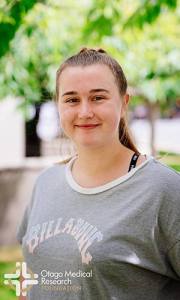
Deloitte Scholar
Kaitlyn Tippett
Project: Identification of new drivers of tumour growth in metastatic triple- negative breast cancer
Supervisor: Dr Sarah Diermeier, Biochemistry
Triple negative breast cancer (TNBC) accounts for ~15% of all breast cancer in New Zealand. TNBC lacks the three markers found in the other types of breast cancer. TNBC is particularly prone to metastasis, meaning the primary tumour commonly spreads to other organs in the body, resulting in secondary tumours. The aim was to identify molecules that are found at high concentrations in metastatic TNBC but at low concentrations in the primary tumour. This was done by quantifying potential molecules in TNBC that metastasizes specifically to the lung, brain and bone. From this, two molecules were identified, AC025176.1 and CASC9. AC025176.1 was identified in all three metastasis sites and CASC9 was identified in just the lung-specific site. The discovery of these molecules can be used to do further research to identify whether they are drivers of metastatic TNBC, and if they could be used as markers of metastatic TNBC

Flavell Memorial Summer Research Scholar
Lars Humblestone
Project: Translating complex TB genomic data for clinicians
Supervisor: Dr Htin Lin Aung, Microbiology and Immunology
Tuberculosis (TB), mainly caused by a bacterium Mycobacterium tuberculosis (Mtb) is responsible for a great deal of suffering worldwide. Rising levels of drug resistant strains of Mtb pose a significant risk to global public health. Whole genome sequencing is a constantly evolving technology that could be of great benefit in drug susceptibility testing (DST). This project aims to translate complex Mtb genomic data into an easily interpretable report for hospital clinicians, to help combat drug resistance. In this project we constructed a pipeline of programs to process TB whole genome sequence data in order to identify mutations that could confer resistance. This information was then input into a report framework tailored for New Zealand clinicians to simplify treatment options for the patient.

Middlemass Scholar
Maria Larsen
Project: Characterising the role of PD-L1 in oestrogen receptor positive breast cancer
Supervisor: Dr Anita Dunbier, Biochemistry
Oestrogen receptor positive breast cancer causes more deaths than any other form of breast cancer in New Zealand. Resistance often arises to current treatments. The cancer cells can express a protein called PDL1, which enables the cancer cells to evade the immune system. Immunotherapy is a new type of cancer treatment that can retrain the immune system to recognise cancer cells, enabling the immune system to attack the cancer. However, immunotherapy does not work for the majority of patients. There is evidence suggesting PDL1 could be used to predict which patients will respond to immunotherapy. This project showed that SSM3 cells, which model breast cancer, do overexpress PDL1 when transfected with a PDL1 containing construct.

Middlemass Scholar
Nathan MacDonell
RENSHAW PRIZE WINNER
Project: Childhood Television Viewing and Adult Health at 45 years
Supervisor: Professor Bob Hancox, Preventive and Social Medicine
Metabolic syndrome (MetS) is a clustering of risk factors which significantly increases risk of cardiovascular disease and diabetes. Evidence of an association between youth TV viewing and MetS is vastly lacking. Using data collected over a lifetime (to age 45 years), we are one of the first to provide evidence that there is an association between TV viewing during childhood and adolescence with MetS in adulthood. Evidence shows approximately 35-40% of youth (5-17 years) average less than 2 hours of screen-time per day. We found those averaging greater than 2-hours-per-weekday of TV between 5-15 years had 1.39 times the odds of developing MetS at age 45 compared to those below this measure. This finding must provide a wake-up call for parents, health practitioners and government officials alike, that changes must be made to promote less screen-time in our youth population.

EMM Haynes Charitable Trust Scholar
Nikita Lyons
Project: Investigating altered brain chemistry in a mouse model of absence epilepsy
Supervisor: Associate Professor Beulah Leitch, Anatomy
Childhood absence epilepsy is the most common paediatric epilepsy, yet one third of sufferers do not respond to currently available treatments. These children endure frequent non-convulsive seizures where they briefly lose consciousness. Seizures are thought to be caused by imbalanced inhibition and excitation in the brain, but the precise mechanisms are uncertain. Our mouse, the stargazer, has a mutation thought to reduce inhibition. This project determined if stargazers have altered levels of proteins that produce and transport GABA, an inhibitory signalling molecule. Expression patterns for all targets were as expected with no differences observed between epileptic and non-epileptic animals. However, levels of a production protein were elevated in epileptic animals, but no significant alterations detected in other targets. This protein may be increased to allow production of more GABA in an attempt to compensate for reduced inhibition. Therefore, this may be important in defining an underlying mechanism to therapeutically target.

The Southern Trust Scholar
Owen Peng
Project: Unmasking antibiotic resistance in Pseudomonas aeruginosa
Supervisor: Professor Iain Lamont, Biochemistry
Pseudomonas aeruginosa is one of the most problematic pathogens due to its ability to develop antibiotic resistance. It is a frequent cause of chronic and nosocomial infections in cystic fibrosis patients, which causes an arms race between the bacterium and modern medicine. The bacterium is constantly evolving new mechanisms to increase its survivability in presence of antibiotics. The aim of this project was to develop a CRISPR-Cas method to understand how deletions in the genome of P. aeruginosa confer antibiotic resistance.

MM & JH Hughes Family Trust Scholar
Paddy Cheah
Project: Sectional anatomy of the extracranial facial nerve trunk and its neighbouring structures
Supervisor: Associate Professor Ming Zhang, Anatomy
Thirty skulls were scanned using a 3D scanner and data involving the jugular foramen were collected. These data were analysed to provide neurosurgeons a more detailed understanding of the area. This is important as endoscopic surgery to the jugular foramen region is becoming more popular recently. Unlike traditional macroscopic surgery, structures which are normally not visible to the naked eyes are now able to be seen with an endoscope. These knowledges will help surgeons to avoid damaging neighbouring important structures such as the facial nerve. Damaged facial nerve could result in facial paralysis. The results suggest no significant differences between two sides and bony landmark is used to better protect the facial nerve.

Esperanz Summer Research Scholar
Phoebe Dewar
Project: The role of cell metabolism changes in activation of anti-bacterial immune cells
Supervisor: Dr James Ussher, Microbiology and Immunology
Mucosal associated invariant T (MAIT) cells are antibacterial immune cells found in the blood, liver and mucosal sites. MAIT cells can be activated via interaction of the T cell receptor with MR1, on antigen presenting cells (APCs), displaying an activating antigen. This antigen is formed by a reaction between a bacterial-derived metabolite of riboflavin synthesis and methylglyoxal, a by-product of cell metabolism. Previously, we found the presence of bacteria enhances activation of MAIT cells, particularly when bacteria are intact. Using a Seahorse assay, we investigated a potential mechanism by which intact bacteria could enhance antigen formation, thus MAIT cell activation, which was hypothesised to be cell metabolism. Early evidence suggests that glycolysis (cell metabolic process) may be enhanced to a greater degree by intact bacteria, giving promise to the potential identification of a mechanism that in the future, could be externally targeted to fine-tune the immune response during bacterial infection.

ANZ Private Scholar
Sharnee Diamond
Project: Aging in rural communities: access to specialized support
Supervisor: Associate Professor Chrystal Jaye, General Practice and Rural Health
To “age in place” in a rural community is only as pragmatic as the availability of access to and provision of health and social services. Among older folk, anticipation of increased need to access health services can make the aging journey daunting. This project not only evaluated the current rural initiatives which are working well, but also the current unmet needs of older rural residents in Central Otago.
In partnership with Aged Concern Otago, this qualitative research, generously funded by ANZ Private and the Otago Medical Research Foundation, provides a window into the lived experiences of these older rural residents. In addition, contributions from rural social workers and other key healthcare providers, highligh the substantial disconnect between government commitment to supporting older rural residents, and overwhelming obligations held by the various non-profit organisations.
The project found:
Rural uniqueness It became clear that living rurally was a preference for each participant, whether born and raised in a small community or relocating later in life, the integrity associated with being a part of Central Otago was universally emphasised.
Aged social work This area of social support work is specialised regardless of the geographical characteristics; however, social work in a rural setting comes with more additional roles and challenges. The effectiveness of this role relies upon the various interlinked agencies working closely together, allowing exchanges of information and not delaying the provision of support.
Action needed to provide effective and consistent support service in rural settings.

The Southern Trust Scholar
Shaun vaz Viegaz
Project: Investigating the dental consequences of perinatal vitamin D deficiency with energy dispersive x-ray analysis
Supervisor: Deanna Beckett, School of Dentistry
Severe vitamin D deficiency commonly results in developmental defects in bone as well as defects in tooth mineralisation. The effects of milder vitamin D deficiency on foetal and neonatal oral health outcomes is still unclear. This study used energy dispersive x-ray analysis (EDX) to characterise the mineral content in vitamin D deficient, insufficient, and sufficient primary exfoliated teeth. A negative relationship between placental cord blood vitamin D status and both calcium and phosphorous weight percentages in enamel and circumpulpal dentine was found, however these differences were not statistically significant (p-value >0.05). This differed from the known relationship between severe vitamin D deficiency and mineralisation defects in bone and non-bone tissues. EDX is a powerful tool but has detection limits that prevent detection of trace elements such as fluoride and magnesium that might have been affected by vitamin D. Future studies could employ other tools such as LA-ICPMS to investigate this.

Otago Southland Diabetes Research Trust Scholar (Administered by Perpetual Guardian)
Shreya Bir
Project: Exosomes as the future of delivering genetic therapies to treat and prevent diabetic complications
Supervisor: Associate Professor Rajesh Katare
As we advance into this new genetic age, gene therapies are starting to be considered as the future of treating and managing chronic diseases such as diabetes. The current area of interest is finding an effective mode of delivery. Exosomes are bubble-like structures responsible for transporting small genetic molecules known as microRNAs in the blood. Changes in the levels of these molecular regulators have been shown to damage the heart and blood vessels in the diabetic state. In this project, we isolated exosomes from the blood of diabetics and non-diabetics and used them to deliver the beneficial microRNAs-126 and 132 to cells in the diabetic state, which improved both proliferation and migration. With diabetic heart disease accounting for 80% of deaths in diabetics, it is our hope that in the future exosomes can be administered therapeutically to correct the levels of microRNAs, reducing morbidity and mortality in this vulnerable population.

Dr Ailsa Goulding Scholar
Stephanie Baldwin
Project: Controlling Arrhythmia in the Heart
Supervisor: Associate Professor Pete Jones, Physiology
Cardiovascular disease (CD) is the leading cause of death in New Zealand and is currently treated with β-blockers. This treatment successfully reduces abnormal heart rhythm (arrhythmia) in patients, however, it is also associated with an increased risk of heart failure. With an ageing population the prevalence of CD is expected to increase, thus, research into future drug targets with reduced risks for patients is crucial. This project investigates the effect of altering the activity of a certain cardiac protein on the generation of arrhythmia, using genetic alterations and drug treatments to inhibit its function. A general trend from this pilot study revealed that there is a possible link between reduced protein activity due to drug inhibition and an increase in arrhythmia generation. This has the potential to be significant for future research into this protein as a prospective drug target; that could influence the lives of many people suffering with CD symptoms.

Werribee Trust Scholar
Susan Naing
Project: Determining the appropriate dose of the drug Raclopride to use in studies attempting to identify a new treatment for Parkinson's disease.
Supervisor: Professor Brian Hyland
The most effective treatment for Parkinson’s disease is Levodopa (L- DOPA), but its use is limited by side-effects. Methylphenidate is a potential treatment that prevents the reuptake of dopamine into the nerve terminals, prolonging the effects of released dopamine. This, however, triggers a negative feedback which dampens dopamine release to reduce the therapeutic benefit. Raclopride is a drug that blocks this negative feedback but may result in Parkinsonian symptoms. Our aim was to construct a dose-response curve to find a raclopride dose that does not produce symptoms, to be used in combination with methylphenidate. The effect of different raclopride doses was assessed using a series of behavioural tests in a rat model of Parkinson’s disease. Severe lack of limb movement was seen with 0.04mg/kg of raclopride, although this improved significantly with 0.02mg/kg of raclopride. This sets a benchmark for future studies combining methylphenidate and raclopride as a drug for Parkinson’s disease.

Esperanz Summer Research Scholar
Thomas Lunt
Project: Evaluating Brain Function in People with Psychosis Experiences
Supervisor: A/P Bruce Russell, School of Pharmacy
Schizophrenia is a debilitating mental condition creates a substantial burden on the lives of those afflicted and the people close to them. Because there is no cure for schizophrenia the best way to treat it is through early intervention, which can be achieved if the early warning signs, known as Psychosis Experiences (PEs) are detected. Current methods of detecting PEs are useful but subjective, so this study aims to create a more objective method using existing imaging technology. Magnetic Resonance Imaging is an effective tool for understanding the structure and function of the brain, and by comparing the brains of those at risk for schizophrenia to those who are not at risk, we hope to gain a better understanding of how psychosis works before the onset of symptoms. Currently there is no data from this study.

Lions Club of Dunedin South Scholar (Administered by Perpetual Guardian)
Tiffany Tsang
Project: What is the benefit of carcinoembryonic antigen (CEA) monitoring in colorectal cancer follow-up?
Supervisor: Associate Professor Mark Thompson-Fawcett, Surgical Sciences
Background: After surgical treatment, colorectal cancer (CRC) recurs in 30-40% of patients. Carcinoembryonic antigen (CEA) can be elevated by recurrent disease, so CEA is measured for early detection. However, it can be elevated in the absence of recurrence, triggering extra unnecessary investigations. We aimed to evaluate CEA testing in CRC surveillance.
Methods: We analysed data on 350 patients who started colorectal cancer surveillance at Dunedin Hospital. Data collected included CEA and imaging results, detection of recurrence, and survival.
Results: 15.1% patients had recurrence. CEA testing had a sensitivity and specificity of 64.2% and 57.6% respectively. 194 (61.2%) scans done due to elevated CEA did not detect a recurrence. In CEA-detected recurrences, 91.7% were still alive compared to 75.9% of non-CEA-detected recurrences, but this may be due to chance.
Conclusion: CEA testing in our surveillance programme provides limited benefit. Further research is needed to refine CEA testing guidelines.

Iverach Scholar
Xiao Li
Project: Who uses on-the-spot blood glucose testing?
Supervisor: Dr Andrew Reynolds, Medicine
On-the-spot blood glucose testing is a health service performed at public events or in pharmacies to raise diabetes awareness and screen for elevated blood glucose levels. We audited data service collected over the last 20 months to identify who uses on-the-spot blood glucose testing, and the frequency of detecting elevated blood glucose levels. Data from 2156 individuals from all major ethnic groups and socioeconomic quantiles were audited, 78% of whom were female. For 53% of responders, this was the first time their blood glucose had been checked. 153 (7.1%) cases of elevated blood glucose (>8mmol/L) were identified. Those identified with elevated blood glucose levels accessed their medical practitioner more frequently than those with normal blood glucose, regardless of a previous diabetes diagnosis. Further research set in the general practice could identify prompts in the timeline leading to a diabetes diagnosis, such as receiving an elevated blood glucose level reading at an on-the-spot service.
2018/2019 Summer Scholarships
Supervisor: Dr Sarah Diermeier
Department: Biochemistry BMS
Funder: Ailsa Goulding Scholar
Project Title: Characterization of a potential new drug target in colorectal cancer
Lay Abstract: Colorectal cancer is the second highest cause of cancer related deaths in New Zealand. One of the most lethal aspects of the disease is its spread from the colon or rectum to distant organs such as the liver, lungs or brains. No currently available medicines are designed to specifically target the spread of colorectal cancer. This research aimed to characterize a potential new target for colorectal cancer medicines, named hMaTAR17. While cells with reduced hMaTAR17 were identified as part of this study, subsequent experiments examining the effect of this target on cell proliferation and survival were inconclusive, suggesting that further experiments need to be performed to make a clear conclusion.
Supervisor: Rachael Augustine
Department: Physiology Department - BMS
Funder: The Southern Trust
Project Title: Novel research into O-GlcNAc protein modification indicated in diabetes.
Lay Abstract: Diabetes or glucose intolerance affects millions worldwide and leads to often debilitating complications in the future. New proteins and modifications indicated along the disease’s pathway could provide future target options for treatments. My research involved one of these protein modifications named O-GlcNAc. O-GlcNAc has been shown to be elevated in the hearts of diabetic patients, and glucose intolerant pregnant mice, and maybe crucial in the disease’s pathway. My research was interested in establishing the differences in O-GlcNAc between diabetic and non-diabetic mice. To do this I immunologically stained the cells containing O-GlcNAc within the mice hypothalamus, and then counted the number of cells positive for the modification in both glucose intolerant and control mouse models. No statistically significant difference between the two groups was found, however trends towards an increase in diabetic mice were observed. Further research is now being conducted looking at other regions of the hypothalamus.
Supervisor: Dr Tania Slatter
Department: Pathology – DSM
Funder: MM & JH Hughes Family Trust
Project Title: Effects of the Tumour ‘Microenvironment’ and Chemotherapy on Brian Tumour Development.
Lay Abstract: Glioblastomas are a type of malignant brain tumour with particularly bad prognoses for patients. Tumour protein p53 (TP53) is a gene that encodes p53 tumour suppressor proteins, that normally function to prevent cancer growth. However, abnormal p53 proteins are produced in some glioblastomas and may play a part in their progression. Here we investigate how different microenvironmental and chemotherapeutic stimuli change the levels of these abnormal p53 proteins in glioblastomas. We also investigate how the levels of these abnormal proteins differ between primary and recurrent tumours. We found that there may be a difference in the expression of these proteins in glioblastomas subjected to various cellular stressors. Also, these abnormal proteins were found in higher quantities in primary tumours compared to recurrent tumours. This study urges further investigation into how abnormal p53 proteins contribute to glioblastoma development.
ELENI HACKWELL Renshaw Prize Winner
Supervisor: Prof Dave Grattan
Department: Anatomy – BMS
Funder: Lions Club of Dunedin South – administered by Perpetual Guardian
Project Title: The mechanism underlying lactational in fertility.
Lay Abstract: Lactation is associated with a period of infertility. However, the mechanism underlying lactational infertility is unclear. This in fertility coincides with elevated levels of a hormone called prolactin, which is important for milk production. However, high levels of prolactin is also known to cause in fertility in both men and women. We were therefore interested in testing the hypothesis that during lactation prolactin acts on cells in the brain called ‘kisspeptin neurons’ suppressing them and there by inhibiting fertility. Using genetically modified mice that can’t respond to prolactin in these kisspeptin neurons, we were able to show that prolactin acting on these neurons is indeed crucial for maintaining infertility during lactation: mice not able to respond to prolactin started ovulating significantly earlier than control mice. This research shows a likely mechanism through which the hormone prolactin acts to keep women in fertile during lactation.
Supervisor: Dr Regis Lamberts
Department: Physiology - BMS
Funder: The Southern Victorian Charitable Trust
Project Title: Exploring the nerves regulating the diabetic heart.
Lay Abstract: Heart disease is one of many complications that patients with diabetes may face; but the reason behind is still not well understood. One type of heart disease common in diabetics emerges from a problem in communication between the heart and brain, and the nerves connecting the two. My study looked at the nerve pattern on the heart surface in rats induced with Type 2 diabetes, using an immunohistochemical staining technique. I found that the innervation pattern of diabetic rat hearts features an increase in the number of short nerve branches. Nerves were also analysed to determine the number of axons, however results were inconclusive. My study adds knowledge about structural neuronal changes in diabetes, to compliment previous studies on functional changes in diabetes, and create more options for possible treatment target.
GEORGINA FAGAN
Supervisor: Professor Michael Shultz
Department: Medicine - DSM
Funder: Otago Medical Research Foundation - Iverach
Project Title: Changes in the composition of gut bacteria in patients with Inflammatory Bowel Disease following a personalised exercise programme.
Lay Abstract: Inflammatory Bowel Disease (IBD) is a chronic and debilitating condition which causes inflammation in the lining of the gut, significantly affecting a patients’ quality of life. It is unknown the effect that exercise has on the composition of gut bacteria in patients with IBD, therefore, the purpose of this study was to investigate this. To do so, 108 faecal samples were collected from patient with IBD who had participated in a four-month exercise intervention and were analysed using standard analysis methods. No significant changes were seen in the composition of the gut bacteria of patients after the exercise intervention. In line with previous research, the effect that exercise has on the gut microbiota was not obvious in this study, therefore further research with more advanced techniques are recommended to fully investigate the compositional changes of gut bacteria in patients with IBD following an exercise intervention.
Supervisor: Prof Cliff Abraham
Department: Psychology
Funder: Healthcare Otago Charitable Trust
Project Title: Effects of a Neuroprotective Protein on Expression of a Neuronal Signalling Protein.
Lay Abstract: Neurodegenerative Alzheimer’s Disease (AD) displaying memory and thought impairment is associated with low levels of secreted amyloid precursor protein (sAPPα) in the brain. Research in the past has shown sAPPα to protect from and reverse the undesirable effects of AD in mouse trials. The beneficial properties of sAPPα suggest it has potential to be used as a therapeutic treatment for patients suffering from AD and other types of neurodegenerative conditions. The following experiment aimed to investigate the underlying mechanism by which sAPPα works to improve and protect brain function through treatment of cells from rat brains. Results from this experiment found no significant effect of sAPPα however, when combined with wider evidence from other research, sAPPα related therapeutics still appear to have potential benefits and should be further investigated.
Supervisor: Dr. Joanne Choi
Department: School of Dentistry
Funder: The Southern Victorian Charitable Trust
Project Title: How does the water coolant design of a dental drill affect frictional heat reduction on the tooth?
Lay Abstract: How does the water coolant design of a dental drill affect frictional heat reduction on the tooth? In dentistry, a high-speed hand piece (HSH) is used to “drill” teeth prior to restoration. HSHs have a water coolant system to prevent heat generation by friction, which would otherwise damage the teeth. However, there is a lack of knowledge among practitioners regarding the cooling effect of these various cooling designs, such as that of the number of water coolant ports. This study compared the cooling efficiency of 1-, 3-, and 4-coolant port designs on extracted human teeth by recording real-time temperature change. All three coolant port designs resulted in cooling of the tooth and net decreases in pulpal temperature.
Supervisor: A/P Mik Black
Department: Biochemistry - BMS
Funder: Deloitte
Project Title: Investigating the genetic influences in the development of stomach cancer.
Lay Abstract: Stomach cancer is a common worldwide cancer, responsible for 720,000 annual deaths. The E-cadherin gene (CDH1), acts to stick neighbouring cells together, and when inactive is implicated in a type of stomach cancer called diffuse gastric cancer (DGC). Thus, identification of genes functioning in conjugation with CDH1 provides a potential drug target strategy, allowing treatment of DGC that lacksCDH1 activity. Targeting inactivated CDH1 is challenging as it is no longer expressed in cells. Therefore, targeting certain genes may provide a mechanism to kill CDH1-deficient cancer cells while non-cancer cells are unharmed.
Supervisor: Dr Abdullah Barazanchi
Department: School of Dentistry
Funder: EMM Haynes Charitable Trust
Project Title: How do former refugees in Dunedin access oral health care?
Lay Abstract: Former refugees face many challenges in resettlement with very few resources. They are likely to have high health needs and difficulties in accessing health services. Dunedin resettled 468 former refugees between 2016 and 2018. New Zealand increased the annual refugee quota in 2018 and committed to an additional increase by 2020. Thus, a thorough understanding of the burden on the health care system is indicated. The Faculty of Dentistry served the majority of former refugees in Dunedin at some point on their care pathways. In Dunedin, former refugees may start with their general practitioners who refer to the oral health care system or may present directly. We interviewed frontline administrative and clinical staff to identify perceived barriers to care. We also conducted a facilities review to identify relevant resources and processes. We combined the findings to characterise the pathways refugees experience in seeking oral health care.
Supervisor: Prof Rhonda Rosengren
Department: Pharmacology and Toxicology – BMS
Funder: Crest Cleaning
Project Title: The potential of seaweed constituents to modulate cellular metabolic responses.
Lay Abstract: Daily human exposure to a vast number of xenobiotics (non-naturally occurring chemical substances) , whether that be through food or environmental pollution, requires an adaptive metabolic response at the cellular level. It also happens that this evolutionarily-conserved system also influences the cellular response to a variety of pathological conditions, such as inflammation, immunity and breast cancer. Given the relative ease by which dietary constituents may be able to modulate this system, the identification and characterisation of such xenobiotics is a worthwhile pursuit to find natural means of preventing or treating a range of diseases. The current study undertook such initial investigations into five seaweed-derived compounds, assessing their capacity to modulate this adaptive metabolic response. All five compounds exerted low toxicity on both human and mouse liver cells and demonstrated differential modulation of the signalling pathway of interest. Therefore, further testing of these compounds as therapies towards numerous different conditions is warranted.
Supervisor: Prof Iain Lamont
Department: Biochemistry - BMS
Funder: Otago Medical Research Foundation – Wilkinson
Project Title: How does a superbug become resistant to antibiotics?
Lay Abstract: Pseudomonas aeruginosa is a highly antibiotic resistant bacterium and is a leading cause of hospital related infections. Many of the mechanisms through which P. aeruginosa gains resistance are poorly understood. The aim of this project was to determine how P. aeruginosa develops resistance to two commonly used antibiotics, meropenem and ceftazidime. This was undertaken by screening a constructed library of the bacterium Escherichia coli containing random mutations in P. aeruginosa AmpC (a gene encoding an enzyme that degrades β-lactam antibiotics) to identify genetic variations which may cause antibiotic resistance. The screening results did not identify any genetic variations in AmpC, indicating that E. coli resistance to these two antibiotics occurs through different mechanisms. These results open the possibility for further research into how P. aeruginosa develops resistance to meropenem and ceftazidime.
Supervisor: A/P Lianne Parkin
Department: Preventive and Social Medicine - DSM
Funder: PaperPlus Dunedin
Project Title: Treatment of type 2 diabetes: are guidelines being followed?
Lay Abstract: It is recommended by current guidelines that people with type 2 diabetes take certain drugs following their initial metformin therapy if needs be. In New Zealand, there are currently limited studies on the treatment patterns of patients and whether or not these guidelines are being followed. In our study, we have used routinely collected anonymised data from the Ministry of Health over the years 2006 to 2014 to identify such treatment patterns. We found that overall, 73% of people who had treatment beyond metformin used a recommended second-line therapy whilst only 24% of those who had further treatment use a recommended third-line therapy. We conclude that the real-world type 2 diabetes treatment patterns in New Zealand are not always consistent with the guidelines.
Supervisor: Prof Colin Brown
Department: Physiology - BMS
Funder: The Southern Trust
Project Title: Brian Regulation of Oxytocin Neurons for Birth.
Lay Abstract: The hormone, oxytocin, triggers uterine contractions, which are required for the delivery of a baby. Oxytocin is released directly into the blood stream from cells in the brain. In non-pregnant animals, oxytocin secretion is low but increases during pregnancy in preparation for birth. Currently, the changes within the brain that increase oxytocin secretion for birth are unknown. Here, I used in-vivo recording from oxytocin cells to show that the neuropeptide, alpha-melanocyte-stimulating hormone, inhibits oxytocin cells in non-pregnant rats but excites oxytocin cells in late-pregnant rats. Hence, alpha-melanocyte-stimulating hormone might contribute to oxytocin release required for birth.
Supervisor: A/P Jo Kirman
Department: Microbiology and Immunology - BSM
Funder: The Werribee Trust
Project Title: Sorting Innate Lymphoid Cells Implicated in the Immune Response to Tuberculosis.
Lay Abstract: Mycobacterium tuberculosis causes tuberculosis (TB) in humans, a globally significant, potentially fatal disease of the lungs, for which there is currently no effective vaccine. Vaccine efforts have historically focused on producing immune responses from TB-specific immune cells, with limited success. A recently discovered group of immune cells, called innate lymphoid cells (ILCs) are activated by a wider range of signals than other, more specific cells. ILCs have also been shown to move into the lungs and become activated after TB vaccination, but it is unclear how important they are in the immune response against TB. This project made progress in development of a method to sort ILCs into different subsets without killing them, so that they may be used in experiments with TB to determine their role in the response. If their role is significant, these cells may be the target of future vaccine efforts against the disease.
NATALIE HYLAND
Supervisor: Prof Murray Thomson
Department: School of Dentistry
Funder: Kingston Sedgfield Charitable Trust
Project Title: The residual dentition among New Zealanders in aged residential care.
Lay Abstract: This study analysed the remaining teeth among older New Zealanders living in residential aged care facilities. Using national data from the Older People’s Oral Health Survey, we determined the residual dentition arrangement and Kennedy classification for each dental arch. Individuals were categorized based on their upper-lower dental configuration. Upper tooth bounded saddles had the highest prevalence, meaning natural teeth remained adjacent to the empty spaces. Younger participants had less exposure to accumulated dental disease and favoured Kennedy class II, III and IV configurations. There were minimal sex differences for partially dentate configurations, although females were more likely to have a fully dentate arch. Great disparities were observed across ethnic groups. Māori were up to eight times as likely to have only lower anterior teeth remaining than other ethnic groups. Upper dentures were worn more than their lower counterpart. Age, sex and ethnic characteristics were associated with particular residual teeth configuration.
Supervisor: Dr Anita Dunbier
Department: Biochemistry - BSM
Funder: Stonelake Scholar
Project Title: Role of Aspirin in Improved Breast Cancer treatment.
Lay Abstract:
Three quarters of breast cancers diagnosed in New Zealand express oestrogen receptor alpha positive and are commonly treated with anti-oestrogen therapy . These treatments are not always effective and a number of individuals are resistant to treatment. Aspirin is a leading anti-inflammatory drug which has the potential to improve the efficacy of AIs through inhibition of cyclooxygenase 1 and 2 (COX1/2). This mechanism is still poorly understood and so cannot yet be applied effectively. Our research aimed to explore this mechanism via analysis of the genes expressed in tumour biopsies before and after treatment, and identify markers of improved treatment efficacy. Through analysis of these data, 178 genes were identified as differentially expressed when the before and after treatment samples were compared.
Supervisor: Dr James Ussher
Department: Microbiology and Immunology BMS
Funder: Otago Medical Research Foundation
Project Title: Effects of bacterial viability on activation of anti-bacterial immune cells.
Lay Abstract: Activation of Mucosal associated invariant T (MAIT) cells, a type of anti-bacterial immune cells, requires interactions with other immune cells and can be influenced by bacterial signals. There is the potential that live, infective bacteria provide additional signals to immune cells that dead bacteria do not, enabling the immune system to correctly recognise the threat of the bacteria. We investigated whether these potential signals from live bacteria influence activation of MAIT cells by combining white blood cells with bacteria that were either alive, heat-killed, formaldehyde-treated or lysed. The results indicated that live bacteria may influence secretion of molecules from cells, therefore the presence of live bacteria may be influencing MAIT cell activation.
Supervisor: Dr Jeff Erickson
Department: Physiology - BMS
Funder: Crowe Horwath/Findex Community Fund
Project Title: Nitric Oxide and CaMKII; A New Target for Treating Heart Disease?
Lay Abstract: In cardiovascular disease (CVD) the adrenaline stress response is upregulated, calcium/calmodulin dependent kinase II (CaMKII) is over activated and causes lethal heart rhythms. The prescription of β-blockers to manage this effect is controversial due to the adverse side effects; thus, it is imperative for alternatives to be developed. CaMKII can be activated and inhibited by nitric oxide (NO), so this study assessed NO inhibition of CaMKII as a novel alternative drug target. Mice were genetically engineered to have CaMKII that could not be inhibited by NO and therefore had overactive CaMKII. Heart ultrasounds were done to assess heart function. In young mice, heart function was significantly enhanced. With age, heart function deteriorated to a diseased state and the development of abnormal heart rhythm increased. I concluded that NO inhibition of CaMKII may be dysregulated in CVD and could be a potential new drug target.
Rebecca Weiming Yi
Supervisor: Dr Peter Li Mei
Department: School of Dentistry
Funder: Otago Medical Research Foundation
Project Title: Along-term retrospective study of the curve of Spee in orthodontic patients.
Lay Abstract: The curve of Spee (COS) is a naturally occurring curve in the human dentition. It is commonly levelled as a part of routine orthodontic treatment, but the stability of such a movement is unclear. This project investigated the long-term stability of levelling the COS, and the related factors influencing relapse. Patients who had fixed appliances debonded 4-11 years ago were recalled to complete a questionnaire and digital impressions were taken with TRIOS 3Shape. One hundred percent of participants experienced relapse in their COS, assuming COS immediately post-treatment was zero. Multiple regression also discovered that self-perceived adherence to retention protocols, overbite and over jet explained 57% of the variability in the COS, with over jet as a statistically significant factor in predicting the average COS (p=0.003). Thus it is of clinical relevance for clinicians to be able to use a patient’s easily measureable overjet and overbite to predict any concurrent potential relapse in COS.
Supervisor: Dr Xochitl Morgan
Department: Microbiology and Immunology - BMS
Funder: The Southern Trust
Project Title: Screening poultry for vancomycin-resistant enterococci (VRE).
Lay Abstract: Vancomycin-resistant enterococci (VRE) are alarming bacteria which kill approximately 1,300 people every year in the United States and infected 67 people in New Zealand in 2017. Between 2000 and 2004, Janet Manson and colleagues demonstrated that VRE was commonly isolated from NZ boiler farms due to the use of multiple antibiotics in the poultry industry. One group of Enterococcus faecalis was particularly common among poultry and causes human infections. It has also persisted in the environment as recently as 2014 (Rushton Green). We performed this follow-up study to determine the prevalence of VRE in commercially available poultry products to show whether supermarket poultry is a potential reservoir of VRE. We were able to isolate vancomycin-resistant bacteria from chickens, but not VRE.
Supervisor: A/P Fiona McDonald
Department: Physiology – BSM
Funder: Walsh & Beck Creative Agency
Project Title: The regulation of the epithelial sodium channel in breast cancer cell lines by the steroid hormone aldosterone.
Lay Abstract: In New Zealand, the leading cause of cancer-related death in women is breast cancer. In order to uncover new treatment options, it is important to understand if ion channels such as the epithelial sodium channel (ENaC) are possible regulators of cancer cell function. There is limited research investigating ENaC in breast cancer. This project aimed to investigate the effect of aldosterone: a steroid hormone and regulator of ENaC, on the protein level of ENaC in breast cancer cells. Two breast cancer cell lines were used and these were incubated with aldosterone or a vehicle control for varying amounts of time. Western blotting was used to visualise the amount of ENaC present following each condition. There was no significant reduction or increase in ENaC found at any time point but after 30 minutes there was a trend towards a reduction in ENaC present on the breast cancer cell.
Supervisor: Prof Kurt Krause
Department: Biochemistry - BMS
Funder: Otago Medical Research Foundation – McQueen
Project Title: Targeting glutamate racemase to aid the discovery of new tuberculosis treatments.
Lay Abstract: Mycobacterium tuberculosisis causal in tuberculosis, and the emergence of multidrug-resistant strains highlights the need for improved therapeutics. Glutamate racemase (GR) is an enzyme essential for mycobacterial growth, making it an attractive target for development of new inhibitors. Testing the ability of drug candidates to bind and inhibit GR requires a purified and active model. Unfortunately, GR shows reduced stability and activity outside the cell, and it has proven difficult to measure its natural activity. This project aimed to use an existing assay to confirm its reliability as a measure of enzyme activity. GR from M. smegmatis, a non-pathogenic cousin of Tuberculosis, and Bacillus anthracis, an unrelated enzyme with significant activity were used, and the results of the project confirmed enzyme characteristics generated by previous investigations pertaining to the rate of activity of the enzymes.
Supervisor: A/P Barbara Galland
Department: Women’s and Children’s Health - DSM
Funder: Otago Southland Diabetes Research Trust administered by Perpetual Guardian
Project Title: Managing Diabetes in a ‘flash’: Flash glucose monitoring in adolescents with unhealthy control of type 1 diabetes.
Lay Abstract: Healthy glycaemic control is important for preventing and minimizing long term diabetes complications; however, the majority of adolescents fail to meet international targets. Flash glucose monitoring (FGM) is the newest technology targeting better glucose monitoring in diabetic patients. FGM provides accurate glucose information painlessly, and may reduce disease burden. This study aimed to explore barriers and facilitators in using FGM among parents of adolescents with a history of unhealthy type 1 diabetes mellitus (T1DM). Twelve parents (9 mothers, 3 fathers) were interviewed in total. The interviews were transcribed and analysed to identify major parental experiences regarding FGM use. The key findings included: emotional improvements in parents, improved parent-child relationships and sensor failure/malfunction challenge. Overall, commencement of FGM in adolescents with unhealthy glycaemic control has a variety of positive impacts on parents of these children. This data may be helpful for health care providers when discussing this technology with families of teenagers impacted by T1DM.
Supervisor: Dr Jim Faed
Department: Pathology – DSM
Funder: The Southern Trust
Project Title: New test methods for identifying harmful ABO blood group antibodies
Lay Abstract: Some antibodies cause rapid in vivo destruction of red blood cells (RBCs) -called haemolysis. This study evaluated variables affecting a new method for detecting antibodies that cause haemolysis. The method used a high salt (chaotropic) technique to detect antibodies that bind with high affinity. Samples from 174 Blood Service donors were tested, comprising 87 potentially haemolytic donor samples in Blood Service tests and 87 that were not haemolytic. The samples were tested using group AB red cells with chaotropic conditions. Red cell agglutination (aggregation) scores were assessed. Best discrimination between potentially haemolytic antibodies (92% reactive) and non-haemolytic antibodies (2% reactive) occurred with 1.0 Mchaotropic conditions with the samples diluted 1:8 in phosphate-buffered potassium chloride (PBKCl). Further studies indicated that the Blood Service test method may be improved by the chaotropic technique. The new method requires plastic tubes coated with albumin to prevent red cells sticking to the plastic.
2017/2018 Summer Scholarships
ANNE JUDE (Dr Dawn Coates, Dr Gemma Cotton, Professor Warwick Duncan and Ms Syarida Safii, Sir John Walsh Research Institute, Faculty of Dentistry)
Title: The effects of nanosilver on human cells
(Southern Victorian Charitable Trust Scholar)
Moa Bone® (MB) is a bovine bone product that has been found by this group to induce clinically important bone growth when used as a graft material. It thus has the potential to enhance jaw bone growth following disease or tooth extraction. A challenge associated with using MB is minimising infections and we are therefore investigating an antimicrobial coating comprised of nanosilver. This research will investigate the safety of nanosilver using in vitro live and dead cell assays with primary human gum-derived fibroblast. This will provide information on the suitability of nanosilver for delivery as an antimicrobial coating for MB.
CAMERON KEELTY(Dr Bill Hawkins, Department of Chemistry, Division of Sciences, and Professor Parry Guilford, Department of Biochemistry, School of Biomedical Sciences)
Title: A new paradigm in drug design
(Otago Medical Research Foundation Scholar)
The E-cadherin protein acts as a tumour suppressant, the down regulation of which has been associated with the formation of metastatic cancers. The treatment options for these cancers are currently limited. Work by Professor Parry Guildford’s research group has identified several compounds via a high throughput screen that selectively target E-cadherin deficient tumour cells. The exact mechanism of action of these compounds is unknown and may be probed by the identification of structure-activity relationships (SARs), characterisation of target molecules (by protein screens) and computational analysis. This will provide information about cellular receptors and allow for the identification of potential drug candidates.
CAMERON REDDINGTON(Dr Peter Mace, Department of Biochemistry, School of Biomedical Sciences)
Title: An interaction study: How do TRIB1 and CDC25 interact?
(Southern Victorian Charitable Trust Scholar)
Conventional kinases add phosphate groups to specific amino acids, to regulate protein activity. Interestingly, a non-functional family of kinases, the Tribbles psuedokinases, have an alternative role. Tribbles proteins recruit substrates to COP1, an enzyme which tags other proteins for degradation. Upregulated in many cancers, Tribbles recruit a variety of important proteins to COP1, leading to the degradation of proteins involved in both cellular growth and proliferation. One degraded protein, CDC25, is a component of a vital cell cycle checkpoint, where enhanced degradation is often catastrophic. As yet, this interaction has not been extensively characterised; this research will examine this.
CONOR McGUINNESS(Dr Anitia Dunbier, Department of Biochemistry, School of Biomedical Sciences)
Title: Can combining treatments improve the response to immune therapies in breast cancer?
(RG and B Calvert Family Trust Scholar)
Oestrogen receptor α-positive (ER+) breast cancers represent the majority of breast cancer diagnoses in New Zealand. ER+ breast cancer is commonly treated with drugs that block oestrogen activity such as tamoxifen to inhibit tumour growth, with variable success. Immunotherapy has been successfully used as a treatment in other cancers, but its potential in breast cancer has not yet been realised. The aim of this project is to further understanding of the immune response to oestrogen deprivation in breast cancer. Thus, the potential of immunotherapy and oestrogen deprivation in combination, as a therapy for breast cancer, will be further determined.
FRANCESCA TEMPLER(Professor Terry Doyle, Department of Medicine, Dunedin School of Medicine, and Associate Professor Niels Hammer, Department of Anatomy, School of Biomedical Sciences)
Title: Re-examining assumptions about the human hind foot and heel pain
(J. A. Iverach Scholar)
From a biomechanical perspective, it appears to be reasonable to consider the Achilles tendon (AT), the calcaneus and the plantar fascia (PF) as a functional complex, and many treatments for plantar fasciitis are based on this assumption. However, little morphological evidence exists regarding the hypothesis of a functional continuity between AT and PF, and there are conflicting descriptions of the anatomy in the existing literature. This summer student project, jointly conducted by Radiology and Anatomy, will investigate the functional relation of the three structures, AT, calcaneus and PF, using state-of-the art imaging, dissection and histological techniques. We will also further investigate any spurs found, to shed light on their structure, development, and associated changes to surrounding tissues.
HAMISH AITKEN-BUCK(Dr Peter Jones, Department of Physiology, School of Biomedical Sciences)
Title: Discovery of a novel regulator of cardiac calcium cycling
(Southern Victorian Charitable Trust Scholar)
The timing and strength of heart contraction is dependent on handling of calcium (Ca2+) within cardiac muscle cells. Critical to this process is the ryanodine receptor (RyR2), which is responsible for mediating Ca2+ release from the sarcoplasmic reticulum into the cytosol of the cell. Numerous protein kinases have been shown to phosphorylate RyR2, however few have had this correlated with altered RyR2 activity. By utilising Ca2+ imaging in combination with RyR2 mutagenesis and pharmacological validation, this study aims to determine the role of the stress-induced kinase, protein kinase G, as a novel regulator of RyR2 and, therefore, cardiac Ca2+ -handling.
JESSICA HARTE(Associate Professor Merilyn Hibma and Ms Allison Tschirley, Department of Pathology, Dunedin School of Medicine)
Title: The effect of HPV cancer proteins on host immunity
(Hughes Family Trust Scholar)
Human papillomavirus (HPV) is a well-known cause of cervical cancer. Mechanisms involved in the progression from low grade premalignant lesions to high grade lesions and cancer have been widely studied. Progression to an invasive cancer is likely contributed to by virus-mediated immune evasion, in part due to a reduced ability to detect viral antigens, and in part due to functions of the HPV oncoprotein E7. This study will explore the regulatory effects of E7 protein on incorporation of cellular protein into microparticles shed from E7 expressing cells and will further determine the efficacy of the drug Y-27632 in suppression of microparticle shedding from E7 expressing cells.
JOSHUA PRESTON(Professor Dave Grattan and Dr Mohammed Rizwan, Department of Anatomy, School of Biomedical Sciences)
Title: Metabolic sensing in the hypothalamus
(Nadia Lim/Paper Plus Scholar)
The summer research project aims to identify the hypothalamic neurons in which activation of beta-catenin-mediated signalling in the hypothalamus can be identified in the rats after feeding. Brain tissue samples from fasted and re-fed groups of rats have already been collected, and the project will entail using dual label immunohistochemistry to identify which populations of hypothalamic neurons are showing feeding-induced increases in beta-catenin. We hypothesise that feeding-induced beta-catenin will be found in neurons known to be involved in body weight regulation, including the NPY/AGRP neurons in the arcuate nucleus, and oxytocin neurons in the paraventricular nucleus of the hypothalamus.
JOSHUA QUONO(Dr Lianne Parkin, Department of Preventive and Social Medicine, Dr Jack Drummer and Associate Professor Katrina Sharples, Department of Medicine, Dunedin School of Medicine)
Title: Are clinicians prescribing beta-blockers to New Zealanders with lung disease and co-morbid heart disease?
(Southern Victorian Charitable Trust Scholar)
Historically, the use of beta-blockers has been avoided in patients with COPD due to a fear of exacerbating respiratory symptoms. International guidelines recommend beta-blocker use following heart attacks, even in patients with COPD. Moreover, recent evidence suggests that cardio-selective beta-blockers actually provide benefit to COPD patients. Despite this, studies in several countries have found that people with COPD and co-morbid heart disease are being under-treated with beta-blockers. No similar study has been performed in New Zealand. This research will describe real-life prescribing behaviours and address a knowledge gap about the use of beta-blockers by patients with COPD in New Zealand.
MANISH KUMAR(Dr Erwin Lamping, Dr Hee Ji Lee and Professor Richard Cannon, Sir John Walsh Research Institute, Faculty of Dentistry)
Title: What stabilises the structure of Candida albicans efflux pump Cdr1?
(Werribee Trust Scholar)
Candida albicans, a human commensal microorganism, is the most frequent cause of oral fungal infections that can become life-threatening invasive infections in the immunocompromised. Azole antifungals are the first line of defence to treat candidiasis. However, azole resistance due to the overexpression of the C. albicans multidrug efflux pump Cdr1 can seriously impair treatment outcome. Six conserved cysteines within the extracellular domain of Cdr1 are predicted to stabilise its structure by forming three disulphide bonds. This project will create and over-express four Cdr1 variants in Saccharomyces cerevisiae and use mass spectrometry to determine which cysteine pairs form three disulphide bonds.
MATTHEW REILY-BELL(Associate Professor Caroline Beck, Department of Zoology, Division of Sciences, and Dr Louise Bicknell, Department of Pathology, Dunedin School of Medicine)
Title: Establishment of frog model to find chemicals from herbs that will reduce epilepsy’s effects
(Jan Warburton Scholar)
Gotu kola herb is used in traditional medicine to treat varicose veins and other conditions including reported beneficial effects in epilepsy. The effect is attributed to high levels of pentacyclic triterpenoids (chemical compounds) this edible plant produces. Intractable epilepsy is defined as uncontrolled epilepsy, refractory to treatment with available or tolerated medications, which leads to significant loss of quality of life. We aim to adopt a new model for intractable epilepsy using tadpoles of the frog Xenopus laevis so that extracts from the Gotu kola herb can be tested for their ability to protect the brain from seizures.
NATSUKO FUSHIDA-HARDY(Associate Professor Keith Ireton, Department of Microbiology and Immunology, School of Biomedical Sciences)
Title: Investigation into the role of cell microtubules and proteins in Listeria infections in humans
(Southern Victorian Charitable Trust Scholar)
An investigation into the role of human cell microtubules and proteins in Listeria monocytogenes infections will be carried out. Listeria entry is mediated by interaction of the bacterial surface protein InlB with the human receptor Met. Entry of Listeria is known to require bacterial manipulation of the host actin cytoskeleton. However, the role of the host microtubule cytoskeleton in Listeria infection remains poorly understood. Importantly, entry of Listeria is known to require an intact microtubule cytoskeleton and several host proteins that associate with microtubules, including LL5α, LL5β, and CLASP2. The aims of this project are to (1) determine whether microtubules mediate the translocation of LL5α and LL5β proteins to areas of the plasma membrane contacting InlB-coated beads and (2) examine the role of host protein CLASP2 in translocation of the LL5 proteins.
REES GUISE(Dr Fiona Doolan-Noble, Professor Tim Stokes and Mr Kyle Forde, Department of General Practice and Rural Health, Dunedin School of Medicine)
Title: Do adults with intellectual disabilities receive less preventative care compared to those who do not have intellectual disabilities in primary care?
(HealthCare Otago Charitable Trust Scholar)
For people with intellectual disabilities (ID), disparities in unmet health care need and poorer health outcomes is a significant issue in New Zealand, recognising that Otago and Māori have higher rates of ID. Further research into this area would meet the goals of the New Zealand Disability Strategy 2016-2026, the United Nations Convention on the Rights of Persons with Disabilities, and the Vision Mātauranga: Hauora/Oranga Improving Health and Social Wellbeing. This research aims to increase understanding of both differences in preventative care, as well as utilisation of primary health care between people with and without ID in the Southern region.
SHREYA BIR(Associate Professor Rajesh Katare, Department of Physiology, School of Biomedical Sciences)
Title: Macromolecules for early diagnosis of heart disease in diabetic individuals
(Otago/Southland Diabetes Research Foundation Scholar)
The rising prevalence of diabetes has made it an epidemic in the developing world. Diabetic cardiomyopathy (DCM), a common form of heart disease in diabetics, is a long-term complication of diabetes which remains asymptomatic until considerable structural and functional damage has occurred. MicroRNAs are small, highly-conserved genetic molecules involved in the pathophysiological process of DCM and it is thought that the specific patterns of these molecules may indicate the development of this disease. This project attempts to show that changes in the circulating levels of cardio-specific microRNAs can be used to detect DCM in its initial stages allowing for early intervention.
SIMONE THOMAS(Professor Vernon Ward and Ms Vivienne Young, Department of Microbiology & Immunology, School of Biomedical Sciences)
Title: Can a norovirus protein stop the cell cycle?
(Stonelake Scholar)
Can a norovirus protein stop the cell cycle? The human norovirus is a huge economic and health burden to New Zealand. There is no reliable way of growing human norovirus for research. Therefore, mouse norovirus is used as a substitute. Our lab has revealed that the mouse norovirus can stop the cell cycle in an infected cell and that this is caused by a protein called VPg. However, the mouse norovirus may not fully represent human norovirus. This project will investigate whether human norovirus VPg protein can also stop the cell cycle, allowing us to better understand human norovirus infection.
STEPHANIE CHO (Dr Wayne Patrick, Department of Biochemistry, School of Biomedical Sciences)
Title: All hope may not be lost: uncovering the vulnerability in antibiotic resistance
(Garth McQueen Scholar)
As microbes speed ahead, evolving resistance to all known clinical antibiotics, new drug development lags behind, and our hopes to gain a leg in the ‘antibiotic arms race’ diminish. Fortunately, recent research suggests that evolution of resistance comes with an exploitable underlying vulnerability: resistance against one antibiotic provokes increased sensitivity to others. Known as collateral hypersensitivity, this project aims to explore this phenomenon. High-throughput techniques will be used to study resistance development while, in parallel, systematically assess the collateral hypersensitivity profile in two bacterial species. Ultimately, this hints at new strategies to combat antibiotic resistance, without demanding novel drug design.
VALERY LIU(Associate Professor Fiona McDonald, Department of Physiology, School of Biomedical Sciences)
Title: Targeting sodium (Na+) transport to control high blood pressure
(Allan Wilkinson Scholar)
Epithelial Na+ channels (ENaC) maintain fluid and electrolyte balance by regulating Na+ transport. To control Na+ transport, the density of ENaC membrane expression may be controlled. The retromer protein complex regulates endosome recycling of ENaC. SNX proteins (components of the retromer) contribute to formation of endosomal membrane tubules and packaging of ENaC into those tubules for recycling back to the cell surface. This research aims to identify the function of SNX17 on Na+ transport thus shedding light on its role in the retromer complex. This will be achieved through the use of western blot and Na+ transport assay.
WILLIAM CLARK (Professor Michael Colombo, Department of Psychology)
Title: Neurons in a higher visual area of the pigeon brain respond selectively to faces
(Alisa Goulding Scholar)
The mammalian and human visual system processes complex visual information in a ventral pathway, terminating in the inferior temporal cortex. A network of inferior temporal cortex cells fire specifically to faces, allowing individual recognition. The avian visual system processes complex visual information in an analogous pathway, terminating in the nidopallium frontolaterale (NFL). Very little is known about the NFL, but recent investigation suggests it is functionally comparable to the inferior temporal cortex. The aim of the present experiment is to investigate the response properties of cells in the NFL to faces, to develop a non-primate animal model for disorders of facial recognition.
WILLIAM WARREN(Dr Michael Jack, Department of Physics, Division of Sciences and Dr Sigurd Wilbanks, Department of Biochemistry, School of Biomedical Sciences)
Title: Development of new tools for protein folding investigations and data analysis
(Deloitte Scholar)
Doing origami is harder in hurricanes. Likewise, protein folding is more error-prone in busy cells. Hsc70 is a protein that protects nascent proteins while they fold. This is important for preventing disease associated with misfolded proteins, and for engineering proteins with new useful functions. To understand how it does this, Hsc70 can be tracked in a live cell. However, the data are hard to interpret. This project will compare two analytical methods, one with precedent in the field, and one novel approach, in order to assess the viability of the novel approach.
2016/2017 Summer Scholarships
ALEC CROSS (Professor Greg Cook, Department of Microbiology & Immunology, School of Biomedical Sciences)
Title: Understanding malate metabolism in mycobacteria
(Rabia Siddique Scholar)
Mycobacterium tuberculosis (TB) is a worldwide killer that claims 1.5 million lives each year. The drugs available to treat TB are running out, as resistance develops faster than we can kill the bacteria. Therefore, we need to develop new therapeutic agents to help those afflicted with TB. Energy generation was recently identified as a viable target for new antibiotics and this project specifically investigated the energy-generating malate:quinone oxidoreductase (MQO). Progress was made on creating several genetically modified strains that will be essential for understanding the role and druggability of MQO.
ALICE FREEMAN (Associate Professor Christine Jasoni, Department of Anatomy, School of Biomedical Sciences)
Title: Epigenetic changes in the brains of offspring exposed to maternal obesity
(Ailsa Goulding Scholar)
Commendation for an excellent summer scholarship report
Maternal obesity during pregnancy is known to increase the risk of offspring obesity, however the mechanism underlying this is poorly understood. A region in the brain, called the arcuate nucleus is central to controlling how much food we eat. When a fetus undergoes gestation in an obese mother, key genes involved in development of the arcuate are reduced. It is thought that this is due to altered epigenetic (non-genetic influences on gene expression) control. This project aimed to investigate in mouse embros if in utero exposure to maternal obesity alters the distribution of a repressive epigenetic marker in the arcuate nucleus of the offspring. The repressive epigenetic marker was found to be increased in the arcuate nucleus of fetuses exposed to maternal obesity. This finding supports the idea that epigenetic changes may underlie the increased risk of obesity in offspring exposed to maternal obesity.
ANDREW KIM (Dr Tania Slatter, Department of Pathology, Dunedin School of Medicine)
Title: Do brain tumours metastases display two markers that could predict tumour behaviour?
(Southern Victorian Charitable Trust Scholar)
Tumours commonly spread to the brain and currently we are unable to predict which tumours will do so. Previous research carried out suggests that tumours which use a specific mechanism, the Alternative Lengthening Telomere (ALT), are more likely to spread. This study aimed to determine whether brain metastases express two ALT-associated mutations: alpha thalassemia/mental retardation syndrome x-linked (ATRX) and isocitrate dehydrogenase 1 (IDH1). 114 samples were tested for these markers using routine immunohistochemistry. This study found that ALT-associated mutations in brain tumour metastases were more common than ALT in primary tumours suggesting that brain tumour metastases are more likely to use the ALT mechanism. If this is true, it would make an easy transition into a clinical setting for an early indication of tumours likely to spread to the brain. However, further research is required to confirm if ALT-associated mutations can be a reliable surrogate for ALT.
CHARLOTTE STEEL (Dr Stephanie Hughes, Department of Biochemistry, School of Biomedical Sciences)
Title: Investigating sleep disturbances in childhood Batten disease
(Allan Wilkinson Scholar)
Batten disease refers to a family of fatal inherited diseases that primarily affect children causing visual, cognitive, and motor problems. A genetic mutation causes one form of Batten disease that also occurs in mice. These mice exhibit reduced dendritic spine density in the cortex of the brain. However, spine density and morphology in the hippocampus, a region important to sleep, have not been investigated. Hippocampal degeneration may contribute to the sleep disturbances seen in Batten disease. Total sleep time, slow wave sleep time and delta wave power spectral density were quantified. Qualitative observations were made of hippocampal dendritic spines in mice with Batten disease as compared to healthy controls. The results of the study suggested a higher number of awakenings in mice with Batten disease, but no significant conclusions could be made as more animals are required for analysis.
DANNI CHEN (Dr Mikhail Keniya, Faculty of Dentistry)
Title: Identifying contact points for the development of next-generation antifungals
(Otago Medical Research Foundation Scholar)
Commendation for an excellent summer scholarship report
Invasive fungal infections are a major global health issue causing 1.5 million deaths annually. New drugs are urgently needed due to the increasing number of immunocompromised patients and resistance to existing antifungal medication. In this summer studentship project we analysed sites that potentially affect drug interactions within the essential fungal enzyme lanosterol 14- demethylase. This enzyme is the target of azole drugs and is required for the production of ergosterol, an essential component of fungal cell membrane. In this project, mutations introduced in amino acid residues around the active site of the protein were used to assess their potential as drug targeting features. We found that these mutations increased susceptibility to certain antifungal drugs, and may aid in the development of next-generation antifungals.
DOUGLAS GASKARTH (Associate Professor Sarah Young, Department of Pathology, Dunedin School of Medicine, and Dr Greg Walker, School of Pharmacy))
Title: Linking skin cancer components to immune system activators, a new vaccine strategy to combat tumours
(Healthcare Otago Charitable Scholar)
Developing new strategies to combat cancer is a growing challenge for medical researchers worldwide. In recent years, therapies which stimulate the body’s defences to fight cancer have had renewed interest. In this study, we aimed to produce two vaccine formulations which could be used to induce protective immunity in a mouse model by linking a known immune activator to the skin cancer component ‘gp-100’. As well as this we aimed to confirm previous studies which used the model antigen ‘OVA’ also linked to the immune activator. By linking activator to cancer component, we aimed to provoke an effective immune response in mice against the cancer, leading to its removal by effector immune cells in the body. Our study successfully confirmed previous studies on the model antigen ‘OVA’ showing an enhanced anti-tumour immune response by the linked compound. This is to be repeated with the tumour antigen ‘gp-100’ in the future.
EMILIE BUTTERFIELD (Dr Richard Egan & Dr Kate Morgaine, Department of Preventative & Social Medicine, Dunedin School of Medicine)
Title: Health promotion workforce interests and needs survey
(Heritage Day Scholar)
Health promotion values the competencies of advocacy, enablement and mediation to develop population level interventions that target the environment of communities and individuals to improve health outcomes. This exploratory cross-sectional study has investigated the profile and professional development needs of the NZ health promotion workforce through the use of an online survey. The survey included questions around organisation, role, personal characteristics, values and competency application. Overall 499 self-identified health promoters responded from a diverse range of organisations and geographic locations. The study has shown that the workforce requires upskilling and support, however, cultural diversity, a high level of competence, and satisfaction with workplace and job was displayed. Overall, a positive depiction of the workforce was seen. The results of this study will help to guide future workforce development within NZ and will form the basis for future studies into the workforce.
GINNY NIEMI (Professor Sarah Hook, School of Pharmacy & Associate Professor Roslyn Kemp, Department of Microbiology & Immunology, School of Biomedical Sciences)
Title: Optimisation of a mouse model to study immune responses in colorectal cancer
(Stonelake Scholar)
Colorectal cancer (CRC) is one of the most common and deadly cancers in New Zealand. In order to research this disease, animal models, which give accurate data that can apply directly to humans, are required. In this study, a previous mouse model of CRC was improved to meet better animal welfare standards, surgical standards, and to be performed in a new animal facility. A new protocol was developed and tested. Major changes to the protocol, such as using gas anaesthetic and performing the surgery in sterile conditions, may affect the mouse immune system. Therefore, data from this modified surgery will be compared to data from a previous surgery protocol to investigate any changes in immune response, which could affect results. This mouse model of CRC could be used in a variety of research, such as the testing of CRC treatments or preventative therapeutics.
HAMISH AITKEN-BUCK (Dr Regis Lamberts, Department of Physiology, School of Biomedical Sciences)
Title: Newly discovered protein has no effect on relaxation of cardiac muscle, despite its key role in relaxation of skeletal muscle
(Garth McQueen Scholar)
Commendation for an excellent summer scholarship report
Relaxation of cardiac muscle is essential for adequate heart function, without it the efficiency of the heart as a blood pump is reduced. Previous research has shown that a newly discovered protein, named myoregulin, has a significant role in inhibiting skeletal muscle relaxation. Therefore, this study aimed to determine the function of myoregulin in cardiac muscle and if it may influence relaxation of the heart. To do this, we exposed isolated heart preparations to myoregulin and measured key relaxation parameters. Contrary to our hypothesis, we found that myoregulin did not have any effect on relaxation of isolated rat heart preparations and therefore does not have a significant role in regulating the relaxation of the heart. Despite this, the continued discovery of new proteins that influence muscle function, whether cardiac or skeletal muscle, provides a means of understanding how these muscles work and, in turn, how these proteins may influence disease development.
HANNAH SIM (Dr Roland Broadbent, Department of Women’s and Children’s Health, Dunedin School of Medicine)
Title: Daily auditing of nutritional intake and prescriptions in the Neonatal Intensive Care Unit (NICU)
(Jan Warburton Scholar)
In very premature new-born infants nutritional intake is vitally important. For various practical reasons the prescribed nutrition cannot be given, so little is understood about the actual amounts of nutrition that is received by comparison. This project aimed to explore whether the aid of a nutritional calculator tool that displays information in graphical form would be useful in clinical practice. The tool was developed as part of the research, with an audit of nutritional intake being done for several patients. The tool also allowed for nutrient levels to be compared with established guidelines. Clinicians were surveyed after seeing it in use as to how they found it and whether they would use it. There was a positive response to the tool, with the potential for it to be implemented into everyday use, to provide better care for premature infants.
HYUN KIM (Dr Ruth Napper, Department of Anatomy, School of Biomedical Sciences)
Title: A single alcohol binge during late fetal development results in cell death in the brain
(Southern Victorian Charitable Trust Scholar)
Individuals with fetal alcohol spectrum disorder (FASD) have mental and/or physical impairment. FASD results from alcohol exposure during pregnancy. The objective of this study was to investigate the effect of a single binge alcohol exposure on acute cell death in the cingulate cortex. The cingulate cortex is an important forebrain area involved in complex cognitive functions and any damage here will impact on learning. This study used a rat model, where a single binge of alcohol was given to rat pups on postnatal day 6 or 8, a period of rat brain development equivalent to brain development of the human fetus during the third trimester. The study quantified the dead cells, 12 hours after giving alcohol using a protocol called ‘unbiased stereology’. The alcohol exposed animals had a significantly greater number of dying cells compared to those without the exposure. The finding highlights the importance of not drinking alcohol in pregnancy.
JAMES NUTTALL (Associate Professor Michael Schultz, Department of Medicine, Dunedin School of Medicine)
Title: Quality of life for people with a stoma. Does this differ according to the underlying disease process?
(J.A. Iverach Scholar)
There are around 500 people in Dunedin, Central Otago and Southland who live with a bag on their tummy, where their bowel opens to empty its contents. It is called a stoma and it is formed most commonly in surgery for bowel cancer, but can be formed for other conditions such as inflammatory bowel disease. A survey was completed alongside an audit of the participant’s medical records. The aim of the research was to identify how the underlying disease relates to quality of life with a stoma which had not been described in previous research. In this study, we found the quality of life was not significantly different in those who had bowel cancer compared to people with inflammatory bowel disease. The next step is to complete a more in-depth analysis of the relationship, considering the other quality of life scores and more of the clinical audit data.
JONATHON ROWE (Dr Adele Woolley, Department of Pathology, School of Biomedical Sciences)
Title: Investigating the link between YB-1 and cell migration in melanoma
(Hughes Family Trust Scholar)
Melanoma is considered one of the most aggressive human cancers. Cancers arise when cells acquire DNA mutations that result in uncontrolled cell growth. Some cells can then cease to proliferate and may become migratory. The Y-box-binding protein 1 (YB-1) has been implicated in both cell proliferation and migration. The aim of this research was to investigate two molecular sites on the YB-1 protein (S176 and S165) in four human melanoma cell lines, which may underpin the ability of melanoma cancer cells to transition from this proliferative to migratory phenotype. The results from this study suggest that two sites on YB-1 may be potential molecular targets for melanoma therapy for patients. In summary, YB-1 plays a critical role in melanoma progression and understanding this behaviour is critical to help prevent the spread of cancer.
JOYCELYN HO (Associate Professor Russell Poulter, Department of Biochemistry, School of Biomedical Sciences)
Title: Gene editing of pathogenic bacteria
(Otago Medical Research Foundation Scholar)
Recent breakthroughs now enable researchers to precisely modify or edit specific DNA sequences in humans, plants and microorganisms. This project focused specifically on CRISPR/Cas9. The system acts as ‘molecular scissors’ that enable researchers to ‘cut’ and modify specific sequences of DNA. This research project looks to optimise CRISPR/Cas9 in pathogenic bacteria, in particular, pseudomonads. This included validating the specificity of the CRISPR/Cas9 system and investigating different methodologies of introducing the CRISPR/Cas9 system in pseudomonads. The experiments conducted was able to show that certain methods display considerable promise of successfully introducing CRISPR/Cas9 into pseudomonads. Successfully introducing the gene editing tool in the bacteria will give researchers the ability to modify specific sequences of DNA. This will be highly valuable in the investigation of virulence and antibiotic resistance in the human pathogen Pseudomonas aeruginosa.
JUSTINE PADDISON (Dr Nichola Swain, Department of Psychological Medicine, Dunedin School of Medicine)
Title: Patient-reported outcomes in those living with implantable cardiac devices
(Lions Club of Dunedin South Scholar)
Adjustment to living with an implanted cardiac device is complex, while most people respond well, others struggle. Collecting patient reported outcomes (PROs) will provide better understanding to the way people adjust to living with an implantable cardiac device. This studentship assessed the feasibility, and established a means, of prospectively collecting PROs in those living with implantable cardiac devices. Data collected will establish normal patterns of psychosocial adjustment, better identifying patients who will benefit from additional care. Analysis will identify common issues facing patients, informing rehabilitation support practices. Expectations and self-confidence in self-care will be investigated, as potential determinants of psychological distress and maladjustment. From this, the effectiveness of targeted interventions can be designed and tested. This study will inform which measures should be included when developing a nationwide PROs programme. Collecting PROs nationally will overcome District Health Board dependent variations in cardiac device populations.
LIZELE BORGES (Dr Pete Jones, Department of Physiology, School of Biomedical Sciences)
Title: Structural changes to cardiac proteins may underlie arrhythmias
(Kingston Sedgfield Charitable Trust Scholar)
Heart disease is the major cause of death for diabetics. For the heart to contract, it requires calcium ions, Ca2+, which is released from Ryanodine Receptors (RyR2) inside the cell following an electrical trigger and mediates contraction. However, it can also be released spontaneously which can trigger arrhythmias. In diabetes elevated blood glucose increases O-GlcNAcylation levels. This involves the attachment of sugar to proteins, and may potentially contribute to protein structural and functional impairment. The aim of this project was to determine if O-GlcNAcylation can alter the activity of RyR2. To observe this, molecular assays and Ca2+ imaging were undertaken of a cell line similar to heart cells. Our results showed inhibition of O-GlcNAcylation to have no increased occurrence of un-triggered Ca2+ release in HEK293 cells. However, promoting O-GlcNAcylation resulted in an increased occurrence of these events. This suggests that RyR2 is O-GlcNAcylated and that it increases the level of spontaneous Ca2+ release and may help explain why diabetics have more arrhythmias.
NATALIE LAGESSE (Dr James Crowley, Department of Chemistry, Division of Sciences)
Title: A new golden age: Is gold the answer to the prevention of post antibiotic era?
(Southern Victorian Charitable Trust Scholar)
Discovering new antimicrobial agents with novel modes of action is the only way to prevent the onset of a post-antibiotic era. Synthesis of a family of gold(I) triazolylidenes which have been shown to have good antimicrobial activity has been completed. Conversion into cationic analogues via substitution of the chloride ligand for a triphenylphosphine ligand was also completed. Preliminary biological testing has shown antimicrobial activity against both methicillin-resistant Staphylococcus aureus (MRSA) and Escherichia coli, and stability against biological nucleophiles.
NICOLA JONES (Dr Anna Wiles, Department of Pathology, Dunedin School of Medicine)
Title: A rapid diagnostic test to direct brain cancer treatment
(Deloitte Scholar)
Glioblastoma (GBM) is the most common, aggressive and lethal form of brain cancer worldwide. Survival times and responses to treatment vary widely, but all patients receive the same treatment. The molecular subtype of the GBM underlies this variability, however these subtypes currently cannot be distinguished by histopathology, a routine diagnostic lab method. This research project investigated the histopathological features of New Zealand GBM patient cases with the aim of establishing a rapid and inexpensive diagnostic tool that could allow for personalised treatment. A particular arrangement of cells known as pseudo-palisading was observed and found to be significantly associated with a molecular subtype of GBM. Additionally, it was discovered that pseudo-palisading is also associated with other specific features of GBM tumours. These findings have the potential to be useful in a diagnostic lab setting and could ultimately lead to improved health outcomes for patients with GBM.
NIGAAH KHAN (Dr Jeff Erickson, Department of Physiology, School of Biomedical Sciences)
Title: Effects of CaMKII on alpha adrenergic receptor activity in the diabetic heart
(Otago Diabetes Research Scholar)
Diabetes mellitus (DM) is a highly prevalent disease that can result in cardiovascular outcomes that may be fatal. CaMKII is a protein that shows increased activity in DM-associated cardiovascular outcomes and in response to α-adrenergic receptor (α-ADR) stimulus. It can increase and decrease activity of downstream proteins that are involved in the normal contraction and relaxation of the heart. Our aim was to determine whether an α-ADR stimulus in the presence or absence of CaMKII contributes to the cardiovascular pathology seen in DM. Our results in isolated rat hearts show that DM hearts have poor contractility basally, and CaMKII could be playing an inhibitory role on speed of contraction and relaxation in DM hearts, but helps increase speed of relaxation in non-DM (NDM) hearts. There is no difference in the expression of total or phosphorylated CaMKII between DM and NDM hearts and thus there may be another way by which CaMKII is being over-activated.
PINKY LAL (Dr Kirk Hamilton, Department of Physiology, School of Biomedical Sciences)
Title: Transport of the calcium-activated potassium channel (KCa3.1) to the cell membrane
(Otago Services Clubs Medical Trust Scholar)
It is understood KCa3.1 is synthesised within the cells of the human body. This channel is required to move from its synthesis station (Point A) to the membrane of the cell (Point B). In order for KCa3.1 to function, it must undergo correct movement to the membrane with the assistance of accessory proteins also called SNARE proteins. KCa3.1 is a channel, which is critical in nutrient and waste exchange in the body. Impairment to the movement of KCa3.1 can result in disease like ulcerative colitis (UC), a type of inflammatory bowel disease, and is commonly caused by the down regulation in KCa3.1 within the intestinal cells. This project focused on the interaction of the SNARE proteins with KCa3.1 in an epithelial cell line. An interaction was established for two of the three SNARE proteins with the channel. These data will enable future studies to focus on potential therapies and drugs for patients suffering from diseases such as UC.
SAM FLAHERTY (Dr Anita Dunbar, Department of Biochemistry, School of Biomedical Sciences)
Title: Identifying cancer-associated mutations within the New Zealand population using high resolution melting analysis – developing new methods to improve the diagnosis of cancer
(Crowe Horwath Scholar)
Alterations in the DNA sequence of some genes can predispose individuals to a higher risk of developing various cancers. Other changes occur during cancer development and can be used for cancer diagnosis and as prognostic markers. This project used a modified version and existing method known as high resolution melting (HRM) analysis as a cheap and simple approach to identify these cancer-associated mutations. HRM analysis was used in this study to identify mutations in BRCA1 and PIK3CA genes, both of which are involved in the development and progression of various cancers. The modified HRM demonstrated greater sensitivity than more traditional techniques for identifying mutations such as DNA sequencing. These results demonstrate the potential of this HRM technique as a cheap and simple way of identifying cancer-associated mutations.
SASHIKA SAMARANAYAKA (Professor Robert Walker, Department of Medicine, Dunedin School of Medicine)
Title: The effect of multiple medication usage on hospital admissions and death in older kidney disease patients
(Sharon Hyndman Scholar)
Renshaw Prize Winner for the best OMRF summer research scholar report
It is unknown whether multiple medications (polypharmacy) are beneficial or harmful. Even less is known about the risk of multiple medications in patients with kidney disease. This study investigated what effect polypharmacy had on hospital admissions and death in a group of older kidney disease patients. This study utilised data collected in a previous study on the medications use, hospitalisations and death of older New Zealand kidney disease patients over a three-year period. Increasing numbers of medications were associated with worse health outcomes. Each additional medication increased the risk of death by 8% and showed a tendancy to increase hospitalisations. Each ‘medication group’ increased the risk of death by 11% and had a similar effect with hospitalisation. The study identified specific medication groups responsible for these associations. In conclusion there is an association between increased medication use and unfavorable health outcomes.
SEWOON KIM (Dr James Ussher, Department of Microbiology & Immunology, School of Biomedical Sciences)
Title: Characterisation of carbepenem resistance in a culture collection of invasive gram-negative isolates from Myanmar
(Southern Victorian Charitable Trust Scholar)
The purpose of this study was to isolate carbapenemase encoding plasmids to determine its molecular context in carbapenem resistant gram-negative bacteria isolated from patients in Myanmar. Conjugation experiments were conducted to obtain trans-conjugates along with electroporation to obtain trans-formants. Confirmation of these trans-conjugates and trans-formants were done by polymerase chain reaction (PCR). One trans-conjugate was obtained through the conjugation method and six trans-formants were obtained from all 6 isolates. These results provide the material for further analysing how the carbapenemase gene is transferred to different bacteria and hence provide useful information in reducing carbapenem resistance and furthermore combat the increasing problem of its dissemination.
2015/2016 Summer Scholarships
AIMEE SMITH (Professor Cliff Abraham, Department of Psychology, Division of Sciences, and Dr Joanna Williams, Department of Anatomy, Otago School of Medical Sciences)
Title: Understanding enzymes to find Alzheimer’s cure
(Southern Victorian Charitable Trust Scholar)
Stable memories require the creation of new proteins to strengthen neuronal connections in the brain. In healthy brains, histone deacetylase enzymes (HDACs) regulate this process to stop the memory system becoming overloaded, but an abnormal increase in HDAC activity has been linked to disorders like Alzheimer disease. Researchers seeking a cure for Alzheimer’s need to understand how, and when, HDACs are at work. We used immunohistochemistry to investigate HDAC activity, by looking at the level of histone acetylation, 12 hours after a learning event. Interestingly, despite successful learning in the test group, we did not find a difference in histone acetylation between groups, despite prior evidence that HDACs are more active at this time point. This suggests that other enzymes may be activated to stabilise histone acetylation. Further studies are needed to understand the complex inter-relationships between these molecules as memories stabilise over time.
ANNAMARIE van WICHEN (Dr Erwin Lamping and Dr Hi Ji Lee, Department of Oral Sciences, School of Dentistry)
Title: Understanding the structure of the multidrug efflux pump Cdrlp in the fungal pathogen Candida albicans
(Southern Victorian Charitable Trust Scholar)
Over-expression of the model fungal multidrug efflux pump Cdrlp, found in the major opportunistic fungal pathogen Candida albicans, causes multidrug resistance. This has the potential for serious consequences such as prolonged treatment or even death for the infected patient. The aim of this project was to determine whether we could employ the novel NanoBRET™ technology developed by Promega Corporation, Wisconsin, USA, to investigate possible homo-dimerisation of Cdrlp in live cells. For this purpose we created a genetically modified yeast strain that over-expressed Cdrlp to which a NanoBRET molecule was physically linked. The results from these experiments confirmed, for the first time, that the highly sensitive and robust NanoBRET technology could be used in yeast cells. We also confirmed that Cdrlp function was not significantly altered by the NanoBRET extension. We can now proceed to investigate Cdrlp homo-dimerisation in live yeast cells.
BETH DENNIE (Associate Professor Colin Brown, Department of Physiology, Otago School of Medical Sciences)
Title: Receptor expression in hormonal related brain cells in pregnancy and breast feeding
(Crowe Horwath Scholar)
Certain brain cells have been shown to change their signalling activity to other brain cells during pregnancy and breast feeding. A molecule called kisspeptin is thought to be the main factor in causing these changes. We looked to see if these brain cells expressed a certain receptor and whether this was increased during pregnancy and breast feeding, to show a mechanism of how kisspeptin could cause the changes seen in these brain cells. We used the brains of female mice either non-pregnant, pregnant or breast feeding and stained for the brain cells and secondly for the receptor. We found that these brain cells did express this receptor however there wasn’t an increase in its expression during pregnancy and breast feeding. This suggests that kisspeptin may be acting via another receptor or via a larger pathway via other cells to cause the changes seen in pregnancy and breast feeding.
BHAMINI RANGNEKAR (Dr Shyamal Das, School of Pharmacy)
Title: Inhalable multi-drug powder for treating pulmonary tuberculosis
(Paper Plus Dunedin Scholar)
The aim was to create a formulation for tuberculosis that infected the lungs. Pyrazinamide and moxifloxacin hydrochloride were combined to create a powder that could be inhaled. These drugs were aided by two excipients, L-leucine and 1,2-dipalmitoyl-sn-glycero-3- phosphatidylcholine. The powders were created using the BUCHI B-290 Mini Spray-dryer which produces the dry powder from a solution by continuously spraying the solution into smaller droplets followed by drying. An in vitro lung model called the next generation impactor was used to test the ability of the powders to reach the deeper lung. The results showed that after spray-drying the particles are spherical in shape with a size of <5 µm indicating suitability for deep lung delivery. The powder composed of both the drugs and 10% L-leucine showed effective delivery with approximately 70% of the inhaled drug reaching to the deeper regions of the lung.
BRIAN SHIN (Dr Andrew Bahn, Department of Physiology, Otago School of Medical Sciences)
Title: Is the onset of type-2 diabetes the result of iron-dependent cell death due to high plasma uric acid levels?
(Southern Trust Scholar)
Insulin producing pancreatic P-cell death and dysfunction are hallmarks of type 1 and 2 diabetes. Studies show circulating urate level is high (hyperuricemia) in people with diabetes. It has been observed that hyperuricemia alone can cause pancreatic P-cell death, but exact cell death pathways involved are unknown. Therefore, our project aimed to observe if the novel cell-death pathway, ferroptosis, is involved in hyperuricemia-induced human pancreatic P-cell death while exploring the involvement of other novel cell-death pathways such as necroptosis. We found hyperuricemia induced significant cell death but use of ferroptosis and necroptosis inhibitors did not significantly rescue the cells from cell death. Therefore the cell death pathways of ferroptosis and necroptosis may not be directly linked to hyperuricemia-induced pancreatic P-cell death.
CARA ADOLPH (Professor Catherine Day and Dr Anita Dunbier, Department of Biochemistry, Otago School of Medical Sciences)
Title: Investigating the role of two proteins (Arkadia and RNF12) in breast cancer
(MM & JH Hughes Family Trust (Cancer) Scholar)
The purpose of this project was to knockdown the expression of two proteins, Arkadia and RNF12, in breast cancer cells. These proteins are of interest as they enhance the activity of a molecular pathway that promotes metastasis, the main cause of mortality in breast cancer. Knockdown was achieved using shRNA which cause degradation of the target mRNA and hence reduce the overall level of the protein in the cell. Five different shRNA constructs targeting Arkadia and three different constructs targeting RNF12 were tested to determine which was the most effective at reducing the expression of each gene. The best constructs gave 40 and 60 % knockdown of Arkadia and RNF12, respectively, at the mRNA level. These findings will allow the use of these shRNA in future investigations to determine how important these proteins are in metastasis and other breast cancer cell behavior.
CHANTELLE ROSSOUW (Professor Mauro Farella and Dr Joseph Antoun, Department of Oral Sciences, School of Dentistry, and Associate Professor Tony Merriman, Department of Biochemistry, Otago School of Medical Sciences)
Title: Finding the genes that cause open bite of the teeth
(Southern Trust Scholar)
The purpose of this study was to investigate the association between anterior open bites (AOBs) and genetic factors and to determine the facial traits of AOB patients. Nineteen AOB patients and 73 control patients were identified using radiographic tracing techniques. DNA was then extracted from existing blood samples of each patient and genetic analysis was completed on the growth hormone receptor (GHR) gene. A significant preliminary association between AOBs and the GHR gene was discovered from the genetic analysis. Further, it was found that the gonial angle and overbite depth indicator were characteristic facial traits of open-bite patients. Although individual facial traits are the result of many small underlying factors, a significant association between such AOB cases and the GHR gene may provide predictive measures for such patients in the future.
DANYON GRAHAM (Associate Professor Brian Monk, Department of Oral Sciences, School of Dentistry and Dr Rajni Wilson, Faculty of Dentistry)
Title: The molecular basis of triazole inhibition of an antifungal target
(Healthcare Otago Charitable Trust Scholar)
Mutations in yeast lanosterol 14-demethylase (Erg 11p) can reduce the susceptibility of pathogenic fungi to the well-tolerated and widely-used triazole drugs, limiting therapeutic options. A Saccharomyces cerevisiae hyperexpression system was used to investigate the effects of two common, clinically relevant mutations (Yl40H and I1471T) in Ergllp. Cell-based and molecular analysis revealed that the Y l40H + I1471T double mutation conferred resistance to short-tailed but not medium or long-tailed azoles. The chemistry of the linkage between the haem-bound triazole head group and the rest of the drug, together with a medium length tail, may stabilise the drug in the binding cavity and limit the desensitising effect of the double mutation. Improved design of medium tailed azole drugs may lead to a new generation of antifungals that will circumvent the resistance problem.
DARREN RITCHIE (Professor Barry Taylor, Dr Gloria Dainty and Associate Professor David Reith, Department of Women’s & Children’s Health, Dunedin School of Medicine)
Title: The value of a childhood obesity assessment tool
(Dr Alisa Goulding Scholar)
New Zealand is facing a childhood obesity epidemic, with approximately 33% of children being classified as overweight or obese. This is a significant public health issue due to obesity being a major determinant of childhood health, quality of life, and well-being. However, despite the evidence concerning the outcomes of childhood obesity, there has been a lack of research into tools that support appropriate assessment and management as part of routine care. Our research tested the value of such a tool developed in Dunedin. We found that our tool leads to an improvement in the completeness of assessment in over half of the categories we tested against. Additionally, our research suggests improvement in the patterns of lab-test ordering, and clinical management, which may have additional benefit. This is an important finding as it shows that standardised tools have a role in supporting the high quality assessment and management of childhood obesity.
ERIN McKERGOW (Dr Lianne Parkin, Department of Preventive & Social Medicine, and Dr Ben Wheeler, Department of Medicine, Dunedin School of Medicine)
Title: Patterns of insulin pump utilisation in New Zealand: A population-based study
(Kelliher Charitable Trust Scholar)
Type 1 Diabetes Mellitus (T1DM) is lifelong disease requiring insulin delivered by injection or a pump. Some patients find pumps more convenient and blood glucose levels may be better controlled, reducing the risk of complications. PHARMAC has funded pumps since 2012, but there has been no research into the impact this has had on pump use. Our aim was to estimate the proportion of New Zealand patients with T1DM who used pumps in the years 2012 to 2014, overall, and according to patient demographic characteristics and region. Proportions were calculated using anonymised patient information provided by the Ministry of Health. Pump use increased annually, with almost 10% of patients using a pump by 2014. The greatest increases were seen among females, children, New Zealand Europeans, higher socioeconomic groups, and in some specific regions. We conclude that here are demographic and regional disparities in pump use which require further investigation.
FAY YAN (Professor Richard Cannon, Dr Li Mei and Professor Mauro Farella, Department of Oral Sciences, School of Dentistry)
Title: Overcoming bad breath with good bacteria
(OMRF Scholar)
Bad breath is a significant social stigma for many people. Good bacteria called probiotic have been used to treat diseases in the mouth like tooth decay. The tongue’s rough surface provides a large area on which bad breath-generating bacteria can live. Tongue brushing can reduce bacteria on the tongue. The purpose of this study was to investigate the effect of tongue brushing and /or taking lozenges of good bacteria on reducing bad breath. Volunteers (35) either did tongue brushing and/or took good bacteria lozenges or nothing for 4 weeks. Various measures of bad breath were recorded 3 times (at the start, after 4 weeks and after 8 weeks). Bad breath was reduced by 31% 26% or 30% in the groups using tongue brushing, probiotic or the combined treatment, respectively. Our preliminary results suggest that tongue brushing and/or use of good bacteria may reduce the level of bad breath.
ISABELLE van HOUT (Associate Professor Grant Butt, Department of Physiology, Otago School of Medical Sciences, and Associate Professor Michael Schultz, Department of Medicine, Dunedin School of Medicine)
Title: The effects of bacteria on colonic cell division and cell death
(Southern Victorian Charitable Trust Scholar and Renshaw Prize Winner)
The colon is home to trillions of bacteria, which are prevented from entering the body by the epithelial lining that forms a physical barrier. The barrier is constantly renewed, with a balance between cell proliferation and cell death maintaining its normal structure. Consequently, alterations in either cell proliferation or death can affect the barrier function and allow bacteria to enter the body. This can result in inflammation, leading to pathologies such as Inflammatory Bowel Disease. Here human colonic organoids, an in vitro model of the colonic epithelium, have been used to investigate the impact of growth factors and bacteria on the rate of proliferation and cell death in the epithelium. This will help us to better understand how the cellular proliferation and death is controlled in the colon.
JADE YIP (Dr Stephanie Hughes, Department of Biochemistry, Otago School of Medical Sciences)
Title: The effect of drug therapy on brain pathology in the mouse model for Batten disease
(Allan Wilkinson Scholar)
Batten disease is a group of lysosomal storage disorders that result in visual impairment, loss in cognitive function and premature death. Mutations in CLN6 gene cause one form of Batten disease. Pre-clinical testing of a drug called NDD-1 has been carried out on a mouse model of this Batten disease, and a previous study has shown that it decreases neuroinflammation in the cortex. In this project, a focussed analysis of three chosen regions using markers of inflammation was carried out to see if the same result was observed. This study however could not conclude a significant effect of NDD-1 in these regions which suggests that more animals/sections need to be analysed or different regions of the cortex contributed to results previously established.
JADE YORK (Associate Professor Stephen Bunn and Professor Dave Grattan, Department of Anatomy, Otago School of Medical Sciences)
Title: Hormone actions in the brain
(OMRF Scholar)
One of the brain’s important roles in the body is regulation of hormone production, including that of prolactin, which has many roles, essentially the production of milk after childbirth. In order to monitor the changes in the brain that occur when increased prolactin secretion is required, technology involving genetically modified rats has been used to monitor the specific neurons involved. The objective of this project was to assess the appropriateness of this rat model for future experiments. It aimed to determine whether it is possible to accurately target the right neuron population using specific staining techniques looking at these neurons under the microscope. The findings of this report indicate the model to be appropriate and effective for further research.
JAMES NEVILLE (Dr Euan Rodger and Professor Ian Morison, Department of Pathology, Dunedin School of Medicine)
Title: Investigating gene expression changes in a family with an inversion on chromosome 5 associated with myelodysplastic syndrome
(Kinston Sedgfield Charitable Trust Scholar)
Myelodysplastic syndrome (MDS) is a set of cancer like conditions within the blood, the severity of which can range from anaemia to an impaired immune system. The aim of this research was to investigate possible genes involved in the development of MDS using a family with a predisposing genetic abnormality. We predicted that one or more of the genes around this abnormality would be affected and display abnormal levels within blood cells. In order to investigate this we separated the blood into neutrophils and other white blood cells. These were broken down and specific candidate gene expression levels within the cell were measured using a technique called RT-qPCR. Specific primers were designed and evaluated prior to being used to investigate the family’s neutrophils and white blood cells. No significant results were obtained from this analysis.
LAUREN SMITH (Dr Jo Krysa, Department of Surgical Sciences, Dunedin School of Medicine)
Title: Vein dilation mechanisms to improve prediction of vein suitability for arteriovenous fistula
(Southern Victorian Charitable Trust Scholar)
Arteriovenous (AV) fistula, formed by connecting a vein to an artery, allows vascular access for haemodialysis in patients with kidney failure. Vein suitability is determined by a patient’s vein diameter and ability to dilate. This project aimed to determine whether 1) warm water bath, 2) warm air, or 3) handgrip exercise, was most efficient at dilating the cephalic vein, compared to current practice in the Otago Vascular Lab which is a tourniquet. The warm water bath was the most efficient and effective mechanism, and caused the highest percentage of participants to reach the threshold diameter of 3 mm. If used in clinical practice to measure vein suitability before surgery, the results suggest it would increase the number of patients put forward for AV fistula. AV fistula has a lower rate of complications than other forms of haemodialysis therefore the warm water bath could improve overall outcomes if these patients go on to form successful fistulae.
LAVAN SIVARAJA (Dr Heather Brooks and Dr Michelle McConnell, Department of Microbiology & Immunology, Otago School of Medical Sciences)
Title: Does the probiotic Infloran inhibit growth of harmful gut bacteria through acid production?
(Southern Victorian Charitable Trust Scholar)
Necrotising enterocolitis (NEC) is one of the most common and severe diseases in low birth-weight, preterm infants. It is believed to be caused by certain commensal gut bacteria which have become harmful due to the absence of probiotic bacteria. In Dunedin Hospital, the probiotic Infloran is used as prophylactic for NEC. This study aimed to investigate the action of Infloran on the bacteria that are involved in NEC. It was hypothesised that Infloran creates an acidic environment that inhibits the growth of NEC bacteria. The bacteria were cultured alone and together with Infloran in PreNan formula milk and the growth was measured over 24 hours. The results showed a significantly decreased growth in the presence of Infloran and significantly increased growth in the absence of Infloran. Also a change in pH was detected. In conclusion, Infloran does inhibit the growth of bacteria caused by NEC, and acid production is a likely mode of inhibition. Further investigation is required to fully understand the mechanism of inhibition.
MATTHEW PAGE (Dr Emma Wyeth, Department of Preventive & Social Medicine, and Professor Rob Walker, Department of Medicine, Dunedin School of Medicine)
Title: The accuracy of ethnicity data reporting
(Lions Club of Dunedin South Scholar)
Differing methods and inaccuracies of ethnicity data collection pose issues for planning and provision of healthcare and monitoring of health outcomes for various ethnic groups. This study used self-reported ethnicity data collected in the ‘Dialysis Outcomes in those aged 65years’ (DOS65+) study, to investigate the accuracy of two other sources of ethnicity data: the Australia and New Zealand Dialysis and Transplant Registry (ANZDATA), and DOS65+ participants’ clinical records. This study found high levels of agreement between self-reported ethnicity in DOS65+ and ethnicity recorded in both ANZDATA and clinical records. This has positive implications for future health planning and analyses.
MICHAEL YUAN (Dr Cherie Stayner and Professor Mike Eccles, Department of Pathology, Dunedin School of Medicine)
Title: How do mutations in meckelin cause polycystic kidney disease?
(OMRF Scholar)
Autosomal recessive polycystic kidney disease (ARPKD) is an inherited disorder that results in significant enlargement of the kidneys. It is caused by defects in the primary cilia, a sensing organelle on the cell surface. One form of ARPKD, called Meckel syndrome, can be due to mutations in the MKS3 gene. This codes for the protein meckelin which is required for primary cilia function. We investigated the effect that mutations in MKS3 have on the distribution of meckelin in human kidney HEK293 cells. Each MKS3 mutant construct was introduced into HEK293 cells. This was then passed through a laser to determine the percentage of meckelin within the cell and on the cell surface. Meckel in was found to have a greater accumulation within the cell in the MKS3 mutations when compared to the MKS3 WT. As a consequence there is disruption in the meckelin mediated signalling pathways that regulate primary cilia formation.
NAVNEET LAL (Associate Professor Phil Sheard, Department of Physiology, Otago School of Medical Sciences, and Dr Tania Slatter, Department of Pathology, Dunedin School of Medicine)
Title: Examination of the processes involved in human muscle fibre death
(Deloitte Scholar)
Muscular weakness is a hallmark of aging and occurs through loss of skeletal muscle mass, by loss of muscle cells (myofibres; myofibre death) or by a reduction in their diameters (myofibre atrophy). Dying myofibres were only recently discovered by our lab, in mice, and appeared strikingly similar to myofibres in diseases where autophagy (process of self-eating to remove damaged proteins) had become insufficient. Here, I aimed to describe changes in autophagy within dying human myofibres and whether autophagy was effective, by quantifying the autophagic substrate, p62. I also compared these results with my findings from murine models. Consistent with previous findings, autophagic activity was increased in dying versus normal myofibres. However, p62 was not elevated, but accumulated within identical autophagic structures, in similar proportions, as those identified in dying mouse myofibres. These results suggest that autophagic dysfunction in human myofibres occurs in the same autophagic structures as dying mouse myofibres.
NIGAAH KHAN (Dr Jeff Erickson, Department of Physiology, Otago School of Medical Sciences)
Title: Effects of stress signaling on a key cardiac signaling protein in the diabetic heart
(Otago Diabetes Research Trust Scholar and Renshaw Prize Winner)
Diabetes Mellitus (DM) is a highly prevalent disease which can result in cardiovascular outcomes that may be fatal. CaMKII is a protein that shows increased activity in DM-associated cardiovascular outcomes and in response to -adrenergic receptor (-ADR) stimulus. It can increase and decrease activity of downstream proteins that are involved in the normal contraction and relaxation of the heart. Our aim was to determine whether -ADR stimulus in the presence or absence of CaMKII contributes to the cardiovascular pathology seen in DM. Our results show that heart rate is lower in DM hearts but can be increased by CaMKII inhibition, CaMKII is needed for a response to -ADR stimulus, and that CaMKII may be overexpressed in DM hearts as inhibiting it showed a normal response to -ADR stimulus in DM hearts.
ROBERT SMITH (Dr Bill Hawkins Department of Chemistry, Division of Sciences, and Professor Parry Guilford, Department of Biochemistry, Otago School of Medical Sciences)
Title: Synthesis of possible anticancer compounds
(PricewaterhousCoopers Foundation Scholar)
The E-cadherin protein acts as a tumour suppressant, the down regulation of which has been associated with the formation of metastatic cancers. The treatment options for these cancers are currently limited and the development of selective treatments is difficult due to the lack of a clearly defined intracellular target. Work by Professor Parry Guildford’s research group has identified several compounds via a high throughput screen that selectively target E- cadherin deficient tumour cells. Synthesis and biological evaluation of analogues of a specific compound was performed during the summer scholarship. The information gathered will aid in the development of a chemotherapeutic agent selective for E-cadherin deficient tumours.
SARAH SANDFORD (Dr Joanna Kirman, Department of Microbiology & Immunology, Otago School of Medical Sciences)
Title: Which lung immune cell subsets activate mycobacteria-specific adaptive immune responses?
(Garth McQueen Scholar)
Tuberculosis (TB) is the leading cause of death by an infectious agent (Mycobacterium tuberculosis). Understanding the immune response following infection is essential to develop new immunemodulating treatments. Dendritic cells (DCs) activate important cells to initiate immune control of TB infection. There are many different DC subtypes and little is known about their role in the early response to TB. The aim of this project was to establish a method to detect whether DCs infected with mycobacteria (a model for TB) could activate other immune cells (T cells). DCs isolated from infected lungs were cultured in the laboratory with T cells, and activation and proliferation of T cells were measured by flow cytometry. We found that DCs isolated 7 and 14 days after infection cause T cell activation and proliferation, and therefore we can use this method to determine which DC subset activates T cells after TB infection.
SHIRLEY KIM (Dr Kristen Coppell, Department of Medicine, and Dr Kristen Kenrick, Department of General Practice & Rural Health, Dunedin School of Medicine)
Title: Has coeliac disease become more common in the Otago region between 1981 and 2010?
(JA Iverach Scholar)
Coeliac disease (CD), an increasingly common disorder, is a chronic small bowel gut disease precipitated by eating dietary gluten. Over the last 50 years, the incidence of CD has increased worldwide. The changing epidemiology of CD in NZ has not been well documented. The aim of this study was to describe the characteristics of CD in the Otago population from 1981 to 2010. A list of possible CD cases was obtained from multiple databases at Dunedin Hospital. Diagnosis was confirmed by checking small bowel biopsy results. Lists for each year were incomplete, except 2005. For this year the age-standardised incidence rate was 16.8 per 100,000 persons, which was higher than reports from Canterbury, the UK and Italy at a similar time, suggesting the incidence of CD in Otago has increased. Practitioners must consider the diagnosis of CD in patients seen with varying presentations.
SIMONETTE MALLARD (Associate Professor Lisa Houghton and Professor Rosalind Gibson, Department of Human Nutrition, Division of Sciences, and Andrew Gray, Department of Preventive & Social Medicine)
Title: The nutritional adequacy of the diets of HIV-exposed and -unexposed infants in urban Zambia in relation to subsequent growth
(Jan Warburton (Nutrition) Scholar)
Dietary diversity, defined as the number of food groups consumed, is used by the WHO as a proxy measure of the adequacy of vitamin and mineral intakes in the monitoring of infant feeding. However, the relationship between dietary diversity and vitamin and mineral adequacy may have weakened with the growing popularity of fortified infant foods. We assessed whether dietary diversity was associated with vitamin and mineral adequacy in HIV-exposed and -unexposed Zambian infants at 6 months of age, and also whether dietary diversity and vitamin and mineral adequacy were linked to growth to 18 months. Consumption of iron-rich, fortified, animal-source, and dairy foods showed better correlation with vitamin and mineral adequacy than did dietary diversity. Nonetheless, dietary diversity had a positive effect on subsequent growth in height that was separate to .that of vitamin and mineral adequacy, warranting its continued monitoring and further investigation into the mechanisms underlying this finding.
SOPHIE GANDHI (Dr Rajesh Katare, Department of Physiology, Otago School of Medical Sciences)
Title: Micro-molecules mediate cell-to-cell communication within the heart
(International Freight Logistics NZ Ltd Scholar)
Following a heart attack it has been observed that the amount of certain small molecules, termed microRNAs (miRs) is altered in the heart. One such molecule, known as miR-34a, has been shown to increase in the heart and blood. Release of miRs is speculated to be a mechanism of communication between different cells. In this study, we measured the effect of miR-34a released from cardiomyocytes (HL-1) on cardiac stem cells (CSCs). CSCs and HL-1 cells under high glucose stress (20 mM) were found to release more miR-34a into the media than in normal glucose conditions. Following treatment of CSCs with the conditioned media we observed no significant change in miR-34a within the cells, cell death or cell replication. However, the CSCs demonstrated reduced expression of senescence marker when treated with 20 mM glucose media or 30 mM HL-1 conditioned media suggesting high concentrations of glucose reduces the senescence characteristic of the cells (i.e. an inability to replicate).
STEPHANIE LYNCH (Associate Professor Bob Hancox, Department of Preventive & Social Medicine)
Title: Is there a relationship between nail biting and/or thumb sucking and the development of asthma?
(Kelliher Charitable Trust Scholar)
The Hygiene Hypothesis suggests that exposure to bacteria decreases the risk of allergies. Childhood thumb-sucking and nail-biting introduce bacteria into the mouth. It is not known whether these habits influence allergy development. Using data from the Dunedin Multidisciplinary Health and Development Study we assessed whether children who sucked their thumbs or bit their nails were less likely to have allergies and asthma when they grew up. We found that 31% of children were frequent thumb-suckers or nail-biters. These children had a lower risk of allergy at ages 13 and 32; children with both habits had the lowest risk. Thumb-sucking and nail-biting were not associated with asthma at either age. These findings show that thumb-sucking and nail-biting are associated with a lower risk of allergy.
URSULA POOLE (Dr Martyn Williamson and Dr Jim Ross, Department of General Practice & Rural Health, Dunedin School of Medicine)
Title: Mapping what is important to rural people with long-term diseases
(Otago Service Clubs Medical Trust Scholar)
Everyday New Zealanders are diagnosed with diseases such as diabetes or asthma. These diseases normally need life-long support from a lot of places, including the person’s family, their GP, the nurse at the practice, a specialist at the hospital, organisations like the Blind Foundation or Work and Income. One way of seeing how important all these different things are to the person’s wellbeing is by mapping them from an interview. The person is put into the centre of the map. The different sources of care are put into circles which can be closer or further away from them. This project studied what these maps looked like in people living in a small rural town. It found that people with family support, a sense of belonging to the community or who have ways of managing their disease by themselves, felt well looked after. The maps help GPs understand their patients in a broader way and identify gaps in their care.
2014/2015 Summer Scholarships
ADRIENNE MORALES (Associate Professor Ruth Empson, Department of Physiology)
Reducing mGluR1 hyperactivity in a mouse model of spinocerebellar ataxia type-1 – helpful or harmful? A behavioural study
(Fortune Theatre Scholar)
Spinocerebellar ataxia type-1 (SCAI) is a disorder that destroys the cerebellum – the part of the brain crucial for executing co-ordinated movements. Previous research has found hyperactivity of cerebellar metabotropic glutamate receptors (mGluRl) in the early stages of SCAI. My experiment aimed to answer the question whether this hyperactivity is helpful or harmful. I found that acute pharmacological blockade of mGluRl improved the motor performance of SCAI mice suggesting that mGluRl hyperactivity may herald the onset of harmful cerebellar destruction. Our findings suggest that moderation of mGluRl may be a good way to treat the early symptoms of human ataxia.
ALICE McSWEENEY (Professor Vernon Ward and Dr Zabeen Lateef, Department of Microbiology & Immunology)
How does mouse norovirus exit from cells?
(Garth McQueen Scholar)
Noroviruses are well known pathogens but currently there is no treatment, vaccine or ability to easily grow the virus in cell lines. Mouse norovirus (MNV), however, can be propagated in the laboratory and was used in this project to investigate if exocytosis was a possible exit strategy for MNV. Inhibitors were used to block aspects of the exocytosis pathway and the effects on intracellular and extracellular virus production analysed. No change in virus production was observed, demonstrating that MNV does not require the exocytosis pathways blocked by the inhibitors to exit cells.
ANTHONY SHAW (Professor Parry Guilford and Associate Professor Mik Black, Department of Biochemistry)
Detecting tumour cells in urine as a potential diagnostic test for prostate cancer
(Southern Victorian Charitable Trust Scholar)
Current tests for early detection of prostate cancer have relatively low effectiveness, often only being able to detect late-stage cancers, or in the case of PSA testing having high false positive rates, leading to unnecessary biopsies and potentially serious complications. Single cell sequencing provides the ability to identify urine-based ·prostate tumour biomarkers, which may offer improved diagnostic performance. By analysing data from single cell sequencing experiments we attempted to identify genes that are only active in prostate tumour cells, and accurately estimate the number of transcripts in single cells to help optimise the development of an improved urine-based diagnostic test.
CHANTAL CHEN (Professor Cliff Abraham, Department of Psychology)
Minimising effort to maximise a memory mechanism (OceanaGold NZ)
In order to store information, neural synapses must be capable of regulated change. This memory-related plasticity, for example long-term potentiation (LTP), must be maintained within a functional range by metaplastic mechanisms. Previous studies have shown that single hippocampal neurons could be positively primed for increased future LTP via intracellular stimulation but not extracellular stimulation, possibly because bulk stimulation activates other types of priming. We hypothesise that hippocampal CA1 neurons can be extracellularly primed by applying MRSl754, an adenosine 2B receptor inhibitor which blocks negative priming. We found a trend supporting our hypothesis, although it was not statistically significant.
DANYON GRAHAM (Associate Professor Brian Monk, Sir John Walsh Research Institute, Faculty of Dentistry)
The effect of a second-site mutation on triazole resistance in yeast: A research project seeking to facilitate structure-directed antifungal drug design
(Crowe Horwath Scholar)
Fungal infections caused by drug-resistant fungi are a serious and growing public health concern. Mutations in yeast lanosterol 14-demethylase (Ergllp) reduce susceptibility to triazole drugs, severely limiting therapeutic options. A Saccharomyces cerevisiae hyperexpression system was used to investigate the effects of two common, clinically relevant mutations (Y140H and I471T) in Ergllp. Cell-based analysis revealed that the Y140H + 1 471T double mutation conferred resistance to short-tailed but not long-tailed triazole drugs. The chemistry of the linkage between the triazole head group and the rest of the drug, together with a long tail, may stabilise the drug in the binding pocket and limit the desensitising effect of the double mutation. Improved design of long-tailed azole drugs may lead to a new generation of antifungals that will circumvent the resistance problem.
EMILY BRIDSON (Professor Iain Lamont, Department of Biochemistry)
A possible mechanism for increased antibiotic resistance in the bacterial pathogen Pseudomonas aeruginosa isolated from the lungs of cystic fibrosis patients
(Kinston Sedgfield Charitable Trust/ACE Shacklock Charitable Trust Scholar)
The majority of cystic fibrosis adults are infected with the bacterium Pseudomonas aeruginosa which can cause life-threatening illness. P. aeruginosa antibiotic resistance is rapidly advancing, so monitoring antibiotic effectiveness is essential. P. aeruginosa possesses an ampC gene which provides resistance to certain antibiotics. This project investigated whether highly antibiotic resistant strains of P. aeruginosa carry multiple copies of ampC which could increase their resistance. Most strains investigated appeared to have a single copy of ampC while two strains may have multiple copies (further research would provide conclusiveness) and one non-clinical strain may have lost ampC altogether.
HAYDEN SMITH (Professor Warren Tate, Department of Biochemistry)
An investigation into the interaction partners of a protective, Alzheimer’s disease-related, brain protein
(Allan Wilkinson Scholar)
An Alzheimer’s disease-related protein has drawn great interest because it has been shown to be neuroprotective. My project intended to begin a study to look for the interaction partner(s) of secreted amyloid precursor protein alpha (sAPP) in order to determine how it might mediate its positive effects on the brain. I carried out the first step by producing the complementary DNA (cDNA) for the gene of one potential protein partner, sortilin. I then inserted this into a larger DNA construct that can enter human cells in culture and express the protein, ready for interaction testing in the future. 6 NICOLAS THEIS (Dr Keith Ireton, Department of Microbiology & Immunology) Title: Purification of a bacterial protein essential for infection of human cells and its recruitment of human proteins to facilitate entry (Southern Trust Scholar) Yersinia species are food-borne bacteria that commonly cause intestinal disease. To establish infection, a protein on the surface of Yersinia, called invasin, interacts with a specific human receptor on the surface of intestinal cells. We aimed to purify invasin and introduce it to human cell cultures to observe its effects on human proteins associated with structural change. Introduction of invasin-coated beads to the surface of human intestinal cells resulted in recruitment of several proteins responsible for remodeling the cellular skeleton. This indicates that Yersinia invasin protein is capable of actively triggering structural changes in the human cell to facilitate infection.
HAZEL NISSEN (Dr Regis Lamberts and Dr Carol Bussey, Department of Physiology)
How does diabetes affect the microcirculation of the heart?
(Otago Diabetes Research Trust Scholar)
Diabetes Mellitus (DM) is strongly associated with cardiovascular disease and is escalating worldwide. DM-induced disease of small heart vessels, the coronary microvessels, contributes to increased cardiovascular morbidity and mortality in diabetic patients. However, our limited ability to directly measure coronary microcirculation restricts progress in our understanding of DM heart disease. I aimed to establish an innovative tool, vascular casting, to measure coronary microvascular perfusion and investigate how type 2 DM impairs this. My study supports the validity of this technique, demonstrates its potential to enhance our understanding of coronary microcirculation in DM, and generates novel opportunities for future cardiovascular research.
KATIE HOEKSEMA (Dr Chris Baldi and Associate Professor Gerry Wilkins, Department of Medicine)
Impaired heart function in type 2 diabetes
(J. A. Iverach Scholar)
Heart rate regulation and contractility are carefully modulated. In a pathophysiological system such as type 2 diabetes mellitus (T2DM), heart function is impaired and the heart is unable to meet the demands of exercise. However, the mechanisms underlying this impairment are not understood. We aimed to compare heart responses of T2DM patients to controls during pharmacological stimulation. Contrary to our hypothesis, no significant differences were seen in contractility, suggesting T2DM patients retain their ability to increase contractility and more extensive study is required to clarify the underlying pathology.
KHAI HOW (Nicholas) CHOO (Professor Richard Cannon, Dr Ann Holmes and Dr Hee Ji Lee, Department of Oral Sciences)
Which Candida albicans strains adhere to acrylic dentures?
(Lions Club of Dunedin South Scholar)
Candida albicans is the principal fungal cause of denture stomatitis – inflammation of mucosa beneath dentures. The ecology of C. albicans strains causing denture stomatitis is poorly understood. We used multilocus sequence typing to track changes in the C. albicans strains in the mouths of people following delivery of new dentures. We found C. albicans strains that were common to several individuals. Some people had more than one strain type. Some strains were maintained in individuals for up to six months despite renewal of dentures, others were acquired during the study. There was preliminary evidence for strain microevolution with time.
LAURELLE LOCK (Dr Greg Walker, School of Pharmacy and Professor Vernon Ward, Department of Microbiology & Immunology)
Nanofibre delivery of next generation vaccines
(Healthcare Otago Charitable Trust Scholar)
A controlled release virus like particle (VLP) loaded with vaccine has the potential to improve the efficiency of immunisations. Nanofibre scaffolds could be used as a matrix to bind VLP as a controlled release platform. In this research we used an electrospinning technique to fabricate nanofibres with various properties known to bind VLP: polycaprolactone (PCL) for hydrophobic attraction, PCL-chitosan blend for ionic interaction and fucoidan coated nanofibres for sugar binding. Scanning electron microscopic analysis showed a stable nanofibre network had been
fabricated for all formulations, with the hydrophobic PCL nanofibre appearing to have the highest affinity for VLP.
LAUREN SHARP (Dr Rachel Brown and Dr Katherine Black, Department of Human Nutrition)
Effects of two types of beetroot bread on blood pressure, endothelial function and consumer acceptability
(OceanaGold NZ)
Bread is a dietary staple of the New Zealand population, making it an ideal vehicle to provide nutrients known to benefit health. One such nutrient is nitrate found in beetroot. In this randomised, cross-over trial, subjects consumed bread containing beetroot juice or beetroot puree. Then blood pressure, endothelial function and gastro-intestinal acceptability were measured over a four-hour period. The beetroot bread was well accepted by participants, however there was no reduction in blood pressure or endothelial function. Fifteen more participants will be recruited to strengthen these findings and determine whether an association is present.
NICOLA DAVIS (Dr Jody Miller and Dr Lisa Houghton, Department of Human Nutrition)
The impact of increasing iodine levels in bread on the iodine status and intakes of elderly New Zealand rest-home residents
(Ailsa Goulding Scholar)
In response to re-emerging iodine deficiency, in 2009, the NZ government mandated the fortification of breads with iodised salt. Iodine intakes and urinary iodine concentrations were determined for participants from a 2014 nation-wide survey of rest-home residents, allowing the impact of fortification on iodine intake and status to be examined. Fortification increased iodine intakes, from 66.6 µg/day to 97.3 µg/day (P <0.001). However, the post-fortification median urinary iodine concentration was 72.5 µg/L, indicitive of mild iodine deficiency. Fortification of other staple foods or supplementation should be considered as additional interventions aimed at improving the iodine status of NZ's rest-home population.
PHILIPPA ROSS (Dr Ben Wheeler, Department of Women’s and Children’s Health)
Incidence and characteristics of insulin-pump adverse events in New Zealand children and adults
(Deloitte Scholar)
Insulin pumps are widely used in the treatment of type 1 diabetes mellitus (TlDM). Perhaps because of their popularity, there have been few recent studies considering the adverse events (AE) associated with their use. This study sought to describe the incidence and characteristics of insulin pump-associated AEs in New Zealand children and adults with TlDM, using a self-report retrospective questionnaire covering the previous 12-month period. We found a high rate of AEs of all types, with set/site problems most commonly reported. As AEs appear common, anticipatory patient education may therefore be important in order to minimise AB-associated complications.
RICHARD LAMB (Dr Bill Hawkins and Dr Eng Wui Tan, Department of Chemistry)
Rational drug design: Covalent inhibitors targeted towards improving Alzheimer’s treatment
(Southern Wide Real Estate Scholar)
Molecules containing reactive electrophilic centres are generally discouraged from being considered as potential drug candidates and often removed from screening libraries before biological evaluation. This central belief seems unfounded when considering the $US33 billion/yr in worldwide sales generated by covalently binding drugs (including aspirin and penicillin). As a case study, we explored the rational modification of the current standard for treatment of Alzheimer’s, that of using donepezil. Reactive electrophilic centres were incorporated into different analogues to improve its binding and selectivity, which could potentially improve the drug’s half-life, cellular resistance, and dosing as well as its pharmacokinetic profile. Synthetic studies were carried out directed towards obtaining these compounds which will eventually be tested for their biological activity. The enone analogue of donepezil, where R = H, was successfully synthesised as well as donepezil itself. However analogues of donepezil, where R = Me and Et, were unable to be synthesised using an aldol condensation from the precursors.
SAMUEL COSGROVE (Professor Rob Walker, Department of Medicine, and Dr Dan Wright, Department of Pharmacy)
Metformin dosing in patients with impaired kidney function: a pilot study
(Otago Service Clubs Medical Trust Scholar)
Our aim was to evaluate the renal clearance and dosing of metformin in subjects with reduced kidney function. Metformin 500 mg and gentamicin 40 mg (a marker of the kidney’s glomerular filtration rate [GFR]) was given to six volunteers with impaired (2 ) and normal renal function (4). Blood and urine samples were collected over 24 hours. Metformin clearance was compared to estimates of GFR using linear regression. Metformin clearance was strongly correlated with GFR (gentamicin clearance, R2 = 0.94, P <0.01), and published eGFR equations (R2 >0.90). Thus our results suggest that a proportional dose adjustment based on estimated GFR is a reasonable dosing strategy for metformin in renal impairment.
SAMUEL GRAINGER (Dr Antje van der Linden, Department of Pathology, and Dr James Ussher, Department of Microbiology & Immunology)
Can MALDI-TOF mass spectrometry be used to distinguish between methicillinresistant and methicillin-sensitive Staphylococcus aureus?
(Southern Victorian Charitable Trust Scholar)
Rapid and accurate discrimination between methicillin-resistant Staphylococcus aureus (MRSA) and methicillin-susceptible S. aureus (MSSA) is essential for effective treatment and prevention of transmission. This project investigated the ability of matrix-assisted laser desorption/ionisation time-of-flight mass spectrometry (MALDI-ToF MS) to discriminate between MRSA, MSSA and the seven major MRSA strains found in New Zealand. The hierarchical analysis
created from the mass spectral profiles showed that isolates were randomly distributed. Thus, we cannot recommend MALDI-ToF MS for discrimination of S. aureus isolates beyond the species level.
SIMONETTE MALLARD (Dr Lisa Houghton, Department of Human Nutrition)
Does weight loss improve vitamin D status? A pooled analysis of weight loss trials and bariatric surgery studies
(Jan Warburton Scholar)
To clarify the nature of the association between obesity and vitamin D deficiency, we undertook a meta-analysis of weight loss studies, aiming to describe the effect of decreasing body weight on vitamin D status. I developed a systematic literature search strategy, and from the 6766 articles identified, 95 met our inclusion criteria. This number was greater than anticipated, which will increase our ability to detect a significant finding. Data extraction sheets were developed and completed. Upon completion of duplicate data extraction by a second researcher, I will in future perform the meta-analyses and draft a manuscript for publication in 2015.
SOPHIE GANDHI (Dr Rajesh Katare, Department of Physiology)
Blood based biomarkers for diabetic heart disease
(MM & JH Hughes Family Trust Scholar)
Diabetes is a chronic metabolic disorder associated with acquiring heart disease, commonly known as diabetic heart disease. Heart disease among diabetics develops at an earlier stage than in nondiabetics. Changes in the structure and function of the heart occur as a consequence of stages at the molecular level. The expression of circulating microRNA-34a (miR-34a) and high-density lipoproteins (HDL) cholesterol were measured to determine use as a biomarker for early detection of heart disease. Results demonstrated diabetic plasma samples to have an increased level of miR-34a compared to non-diabetic plasma samples. Furthermore, HDL concentrations were lower in diabetics than non diabetics.
STENAR KIRS (Mr Ahmad Taha and Dr Noelyn Hung, Department of Surgical Sciences, Neurosurgery)
Metastatic brain tumours in a Dunedin cohort and their molecular markers
PricewaterhouseCoopers Foundation Scholar)
Brain metastases are even more common than primary brain tumours and there are limited treatments available for them. This study aimed to identify possible clinical and molecular prognostic factors for this devastating disease. Although the study had a small sample size, modality of treatment and location of tumour were found to be prognostic factors in this cohort as well as MGMT (O6-methylguanine DNA methyltransferase) and CD163 (macrophage/activated microglia associated antigen) marker status. These factors should be considered when a decision is made about how aggressively a patient is treated particularly if the treatment threatens the patient’s quality of life in their final days.
YAECHAN (DAVID) JU (Associate Professor Nigel Dickson and Dr Claire Cameron, Department of Preventive & Social Medicine)
The association of serum testosterone with relationship status and parenting at ages 26 and 38 in men: preliminary analyses
(Dunedin Casino/MediaWorks Otago Scholar)
Consistently serum testosterone (T) has been associated with relationship status in men, and in some studies with fathering. This was examined at ages 26 and 38 in the Dunedin Multidisciplinary Health and Development study. At both ages both total and free serum T were lower in men in long-term relationships; they were not associated with ever fathering a child, but were associated at age 38 (but not 26) with living with a child. Serum T was also associated with weight and smoking. Further analyses are planned to examine for independent effect of relationship status and of changes over time in individuals.
2013/2014 Summer Scholarships
AARON YAP (Professor Anthony Molteno and Associate Professor Gordon Sanderson, Department of Medicine)
The detection of choroidal melanoma in the New Zealand population
(Hughes Family Trust Scholar)
Choroidal melanoma encompasses 90% of all uveal (iris, ciliary body, or choroid) melanomas, and is associated with a mortality rate of 50%. The incidence of uveal melanoma is 4.3 cases per million people in the United States. Initially appearing as a small freckle beneath the retina, it can grow in height and diameter and may eventually spread to other parts of the body causing death. Most patients present with visual symptoms such as photopsia, floaters, vision loss or eye pain. Currently, there is a lack of research on choroidal melanoma in the New Zealand population. The aim of this research is to investigate how this disease is detected and treated in our country. Additionally, this will give us an opportunity to study the demographic profile and eventual outcome of the affected population.
ADELAIDE HOPKINS (Dr Anita Dunbier, Department of Biochemistry)
The role of DNA variants in controlling expression of genes involved in breast cancer
(Otago Service Clubs Medical Trust Scholar)
Breast cancer is the most common cancer in women accounting for 400,000 deaths per year worldwide. The majority of breast cancers produce the oestrogen receptor and require the hormone oestrogen to grow. Drugs that act by preventing the production of oestrogen are the most effective treatment currently available for this type of cancer. However, these drugs do not work well for all patients. We plan to investigate the role of a DNA variant in controlling how the gene that encodes the oestrogen receptor is turned on. This may help us understand why treatment does not work for some patients.
BRITTANY DAVISON (Dr Paula Skidmore, Department of Human Nutrition, and Dr Robin Quigg, Department of Preventive & Social Medicine)
Pilot testing an electronic food diary app in nine- and ten-year olds
(Foodstuffs Community Trust Scholar)
Childhood obesity rates in NZ are among the highest worldwide, and one of the major modifiable determinants is diet. Measuring diet comprehensively in children using traditional pen and paper methods is difficult to do accurately. The Department of Human Nutrition has recently developed an iPod-based food diary for recording food and drink intake in adolescents, using food photography. This has proven to be a user friendly, efficient and accurate method of measuring nutrient intake in adolescents. The aim of this project is to investigate if this new app is suitable for measuring food and drink intake in younger children.
CHLOE SQUIRES (Dr Sarah Baird, Department of Pharmacology & Toxicology)
Could coffee be used to treat cancer?
(PricewaterhouseCoopers Foundation Scholar)
Solid tumours contain many cells derived from the bone marrow which includes mesenchymal stem cells (MSCs). MSCs contribute to cancer malignancy and so present as good targets for cancer therapy. Coffee is a very popular drink worldwide and is made up of a large group of chemicals, including caffeine. This project will investigate the effect of coffee and its constituents on MSCs. We will show which of the constituents are able to kill MSCs and demonstrate the mechanism of cell death. This will establish how coffee may be affecting cancer development and whether it has possible use in cancer treatment.
DAN PRESTON (Dr James Crowley, Department of Chemistry)
Improved cisplatin encapsulation in dipalladium cages
(Garth McQueen Scholar)
Cancer treatment by cisplatin can be hindered by drug resistance and toxicity. The use of drug delivery vectors to selectively transport cisplatin to tumours to increase effective dosage and decrease toxicity is therefore a blossoming field of research. Our group has developed a supramolecular cage capable of binding cisplatin and the technologies to functionalise the cage for added solubility, stability and potential targeting. Changes can be made to improve the encapsulation of cisplatin within the cavity of the cage, and this project would develop this methodology and test its effectiveness in improving cisplatin binding.
DANNY NAM (Dr Jeff Erickson, Department of Physiology)
Hyperactivity of the protein CaMKII: What role does this play in the diabetic heart?
(Otago Diabetes Research Trust Scholar)
Ca2+/Calmodulin-dependent protein kinase II (CaMKII) is a protein that, when activated, is able to modify other proteins in the body and contribute to specific physiological functions. Normally CaMKII is in an inactive state in cardiac tissue. However in disease, CaMKII is modified so that it becomes hyperactive, and this process has been linked to pathologies such as cell death. Recent studies in the context of the heart have shown that diabetics have increased mortality compared to non-diabetics, and CaMKII hyperactivity has been implicated. Therefore our aim is to investigate the role of CaMKII in the diabetic heart.
DEEPA MISTRY (Professor Richard Cannon, Dr Kyoko Niimi and Dr Masakazu Niimi, School of Dentistry)
Understanding how fungal drug efflux pumps work
(Deloitte Scholar)
Candida albicans is an opportunistic fungal pathogen that causes serious infections in immunocompromised individuals. Treatment of patients with azole antifungals is hampered by the emergence of drug resistance. The major mechanism of C. albicans azole resistance is overexpression of the efflux pump Cdr1p. It is not known how inhibitors bind to Cdr1p or how substrates are pumped. We will use site-directed mutagenesis and a unique library of yeast expressing mutated Cdrlps to test our hypothesis that amino acid glycine 521 in Cdrlp forms a ‘gate’ with amino acids in another part of the pump that controls inhibitor binding and substrate access.
HAZEL NISSEN (Professor Ian McLennan, Department of Anatomy)
Why do the brains of autistic boys develop rapidly?
(Southern Victorian Charitable Trust Scholar)
Autistic spectrum disorders (ASD) include deficits in socialising, language and behaviour. ASD have a male bias, and are associated with an accelerated rate of brain development. AntiMüllerian hormone (AMR) is during development a male-specific testicular hormone which putatively controls the speed of male development. ASD boys with high levels of AMR have mild symptoms suggesting that AMR may protect against ASD by slowing development. My proposal will test whether AMR directly slows the rate of early brain development. This will be achieved by comparing the maturity of the brains of AMH-deficient (Amh-/- ) male mice with their normal (Amh+/+) male littermates.
IUN KAO (Dr Greg Walker, School of Pharmacy, and Dr Michelle McConnell, Department of Microbiology & Immunology)
Antimicrobial textile made from wine waste extracts
(Otago Medical Research Foundation Scholar)
Wine waste extracts containing a high amount of compounds called polyphenols have been shown to kill bacteria. The aim of this project is determine whether we can incorporate these bioactives into a nanofiber textile which can then release these actives slowly over time to kill bacteria. We will make the bioactive nanofiber textile by electrospinning a solution of polymer and wine waste extracts together. Using a chemical assay for polyphenols we will measure the release of the bioactive compounds over time. These textiles will be put in contact with bacteria in the laboratory to see if they can kill the bacteria.
IVOR MALAHAY (Associate Professor Fiona McDonald, Department of Physiology)
Effect of a novel protein on pancreatic secretion
(Pub Charity Scholar)
The secretion of digestive proteins by pancreatic acinar cells is a vital and highly regulated process required for the digestion of food. Defects in secretion may lead to an illness known as pancreatitis. COMMD (Copper Metabolism MURR1 Domain containing) proteins are a family of recently discovered proteins known to have a diverse role in cellular regulation including protein secretion. One of those proteins, COMMD10, is thought to have an effect on pancreatic protein secretion. This project aims to determine how COMMD10 regulates the secretion of proteins by pancreatic acinar cells.
JEFFREY ONG (Dr Mikhail Kenita and Dr Brian Monk, School of Dentistry)
Genetic regulation of drug resistance in yeast
(Allan Wilkinson Scholar)
The emergence of multidrug resistance in fungal pathogens compels the development of new classes of fungicides that do not induce drug resistance. Transciptional regulation of multi-drug drug resistance in Saccharaomyces cerevisae has provided insight into potential drug targets, including the transcription factor Pdrlp. A recent experimental approach aimed at identifying antagonists of Pdrlp has found that bactopeptone can activate Pdrlp. This research project aims to identify the component in bactopeptone responsible for the activation of Pdrlp-mediated multi-drug resistance in order to assist antifungal drug design.
JOANNE LEE (Dr Joanna Kirman, Department of Microbiology & Immunology)
Development of a test to measure memory immune responses to tuberculosis (TB)
(Pub Charity Scholar)
Mycobacterium tuberculosis is the causative agent of tuberculosis (TB), a disease that infects and kills millions of people every year. The only vaccine available does not work well to protect against TB of the lung, which is the most common form of TB. In order to develop a better vaccine we need to understand the immune populations that can recall and fight the infection effectively. As part of this effort in this project we plan to develop a test to accurately measure the features and functions of the recall (or memory) immune cells that develop after TB vaccination.
JOHN BRADY (Associate Professor Phil Sheard, Department of Physiology)
The muscle protein MuSK and age-related loss of muscle function
(Healthcare Otago Charitable Trust Scholar)
As we age, we experience a progressive decline in strength and muscle mass, a condition called sarcopenia. We believe that the progressive decline in strength is caused partly by muscle denervation.Although the causes of denervation are currently unknown, our hypothesis is that it occurs due to age-related loss of synapse maintenance signals between the muscle and the motor nerve. Here I propose to investigate one such protein – MuSK, a regulatory protein that is involved in formation and maintenance of the neuromuscular junction.
JOYCE TANG (Dr Brian Monk, School of Dentistry)
The electrochemistry of the fungal drug efflux pump
(Crowe Horwath Scholar)
ATP binding cassette transporters play a pivotal role in the development of xenobiotic resistance. Two highly conserved features, the pairs of nucleotide binding domains and the pairs of transmembrane domains, suggest ABC transporters may be electrogenic primary pumps because ATP hydrolysis generates protons and transported substrates are partially positively charged. This study aims to confirm the concept that overexpression of the Candida albicans Cdr1p drug efflux pump confers on yeast the ability to produce an enhanced electrochemical gradient at the plasma membrane and to test whether this applies more broadly to efflux pumps of the ABC transporter superfamily.
KATE McELROY (Lara Friedlander, Suzanne Hanlin and Dr Claire Cameron, School of Dentistry)
Evaluation of direct pulp capping of permanent teeth in general practice – A PBRN study
(Southern Trust Scholar)
Practice Based Research Networks (PBRNs) are internationally recognised in bridging the research gap between general practice and universities. This study launches our recently developed ARCH (Applied Research through Clinician’s Hands) dental PBRN in New Zealand. Direct pulp capping is a conservative approach for the management of pulp exposures and this project will investigate this treatment and its application in general dental practice. A survey will be sent to practitioners who have previously expressed interest in joining the ARCH PBRN with the objective of gaining information around the understanding and management of pulp exposures in general practice, and to inform future dental PBRN projects (on the ease of data collection in private dental practice).
KATIE HOEKSEMA (Dr Pete Jones, Department of Physiology)
Development of a new screening assay for anti-arrhythmic drugs
(Southern Victorian Charitable Trust Scholar)
Arrhythmias are irregular heartbeats that can be triggered by the spontaneous opening of a calcium channel named the cardiac ryanodine receptor (RyR2). Anti-arrhythmic drugs typically act by blocking plasma membrane ion channels or sympathetic nervous activity to alter cardiac action potentials, although recently some have been discovered to act by directly inhibiting RyR2. Currently, tools used to screen drugs for inhibiting RyR2 are time-consuming and expensive processes. This project aims to develop a higher throughput cell model to allow efficient screening of anti-arrhythmics using calcium measurement techniques. This model will help rapidly identify drugs with the potential to prevent arrhythmia.
MARK HUANG (Dr Harry Bradshaw and Associate Professor Gordon Sanderson, Department of Medicine)
Risk of rhegmatogenous retinal detachment in patients with various degrees of shortsightedness in New Zealand
(J.A. Iverach Scholar)
Rhegmatogenous retinal detachment (RRD) is a medical emergency that, if untreated, can progress to visual impairment and blindness. High myopia has been found to be a significant risk factor for RRD and the risk for developing RRD is associated with a patient’s refractive error. The aim of the research is to investigate the prevalence and degree of refractive error in patients presenting with RRD in New Zealand using a multi-centre, retrospective study. From this data we hope to estimate RRD risk in people with refractive error in New Zealand and correlate the risk with the degree of myopia.
MONICA ARCHIBALD (Dr Sebastian Taurin and Dr Khaled Greish, Department of Pharmacology & Toxicology)
Nanomedicines for the treatment of prostate cancer
(OceanaGold – Prostate Scholar)
Overall, the five-year survival of patients with hormone refractory prostate cancer is less than 25%. Studies have highlighted the potential of tyrosine kinase inhibitors in the control and treatment of prostate cancer. Preliminary data have shown that a combination of sorafenib and nilotinib, which inhibit pro-angiogenic factors and cell proliferation, decreases cell viability of prostate cancer cells. However, these inhibitors are extensively metabolised and inactivated in vivo. The aim of our research is to evaluate the cytotoxicity of a combination of these two drugs into the same nanomedicine against various prostate cancer cells.
PAUL HSU (Dr Khaled Greish and Dr Sebastian Taurin, Department of Pharmacology & Toxicology)
Use of nanotechnology for oral delivery of targeted anti-cancer drugs
(Lions Club of Dunedin South Scholar)
Oral chemotherapy is the preferred treatment of patients and offers several advantages over intravenous administration of chemotherapeutic drugs. However, gastrointestinal (GI) toxicity and low oral bioavailability often limit the use of anti-cancer drugs via the oral route. This may be overcome by use of nanoparticles that encapsulate the drug to minimise contact with the GI wall and preferentially accumulate drug concentration at the tumor site. To date there are no approved nanoparticles in oral chemotherapy, thus here we aim to explore the potential of the SMA-paclitaxel nanoparticle construct in increasing bioavailability and antitumor efficacy.
PAUL HSU (Dr Khaled Greish and Dr Sebastian Taurin, Department of Pharmacology & Toxicology)
Use of nanotechnology for oral delivery of targeted anti-cancer drugs
(Lions Club of Dunedin South Scholar)
Oral chemotherapy is the preferred treatment of patients and offers several advantages over intravenous administration of chemotherapeutic drugs. However, gastrointestinal (GI) toxicity and low oral bioavailability often limit the use of anti-cancer drugs via the oral route. This may be overcome by use of nanoparticles that encapsulate the drug to minimise contact with the GI wall and preferentially accumulate drug concentration at the tumor site. To date there are no approved nanoparticles in oral chemotherapy, thus here we aim to explore the potential of the SMA-paclitaxel nanoparticle construct in increasing bioavailability and antitumor efficacy.
REGINA HEGEMANN (Professor Cliff Abraham, Department of Psychology)
Do hippocampal granule cells “retire” as they age?
(Kingston Sedgfield Charitable Trust Scholar)
Episodic memory formation is believed to require information processing in the hippocampus. Previous work has shown that young granule cells born in this brain region during adulthood possess unique electrophysiological properties which make them more excitable and particularly susceptible to incoming information, while older granule cells “retire” from information processing. However, overall low activation rates may have biased the result of previous studies. The aim of the proposed research is to provide a more accurate estimate of the contribution of young and old granule cells to hippocampus-dependent information processing by amplifying the proportion of granule cells activated in response to behavioural exploration, through previous exposure to an enrichment environment.
TARA MILLER (Dr Heather Brooks, Department of Microbiology & Immunology)
Antibiotic susceptibility of bacteria isolated from Oamaru school children
(Southern Trust Scholar)
Staphylococcus aureus is a major cause of serious skin infections and hospitalisations in New Zealand. This pathogenic bacterium commonly resides on our skin or in our noses. With the number and range of antibiotics that S. aureus is resistant to increasing in communities, it is becoming more vital to know which antibiotics are used in each region that the endemic S. aureus occurs because initial antibiotic treatment is empiric. In this project I aim to determine the antibiotic susceptibility of S. aureus strains previously isolated from Oamaru school children.
2012/2013 Summer Scholarships
AARON YAP (Dr Jim Faed and Dr Shinji Chiruka, Department of Pathology)
An audit of outcomes for patients treated with prothrombinex-VF
(Pub Charity Scholar)
Prothrombinex complex concentrates (PCCs) are commonly used to reverse the effects of the oral anticoagulant warfarin, in patients who are actively bleeding, or prior to high risk procedures. Prothrombinex-VF is a PCC, which when combined with Vitamin K, offers fast and complete reversal of warfarin. However, reports indicate PCCs may increase the risk of thrombosis. We retrospectively reviewed 121 patients treated with PTX-VF in Dunedin Hospital and found 5.0% of the patients subsequently had a thromboembolic episode within 30 days. The episodes could not be etiologically linked to PTX-VF use due to the presence of other multiple confounding factors such as patient age and co-morbidity.
ANTON REIMAN (Dr Sarah Young, Department of Pathology and Dr Greg Walker, School of Pharmacy)
Nanofibre delivery system for cancer immunotherapy
(James Russell Lewis Trust and Commendation)
The amount and duration of antigen presentation to dendritic cells dictates the quality of the subsequent immune response as well as preventing tolerance. Nanofibre devices are advantageous to drug delivery as they have defined structure, molecular composition and predictable biodegradation profiles. This project has demonstrated that an electrospun nanofibre device can be used to activate the immune system in vitro against a model antigen and induce effector cell proliferation, an essential step in the activation of the immune system against cancer. This study suggests that electrospun nanofibre devices are amenable for use as antigen delivery systems for cancer immunotherapy
ELIZABETH WILLIAMS (Dr Anne-Louise Heath and Associate Professor Rachael Taylor, Department of Human Nutrition, and Dr Andrew Gray, Department of Medicine)
Breastfeeding in the first six months of life: Prevalence and problems
(Lions Club of Dunedin South Scholar)
Exclusive breastfeeding is recommended for the first six months of life. Breastfeeding problems are a leading cause of breastfeeding cessation; however there is little quantitative evidence of the prevalence and types of breastfeeding problems that occur each month during the first six months of life. The research project described the prevalence of ‘exclusive’ and ‘any’ breastfeeding during the first six months of life, the prevalence of different types of selfreported breastfeeding problems and when they occur month-by-month during the first six months of life, and to investigate whether breastfeeding problems occur in clusters, in a representative sample of 209 Dunedin women.
FLY ING-ARAM (Professor John Highton and Dr Jo Dockerty, Department of Medicine)
Methotrexate use in the community – identifying a gap in patients’ knowledge of the therapy as well as their awareness of safety issues
(Deloitte Scholar and Renshaw Prize Winner)
Low-dose methotrexate has been implicated in medication errors resulting in life-threatening events. Sixty rheumatology patients were interviewed to obtain information about their methotrexate use and awareness of toxicity as well as to assess the risk of potential unintentional overdose from a medication error. Education from a rheumatology nurse and shorter duration of methotrexate therapy were found to be associated with superior knowledge of methotrexate toxicity. Two patients were identified as being potentially at risk of overdose due to medication error. We would recommend that patients receive education on methotrexate by nurses and subsequent information be given after 5 years of therapy.
GLEN RAWLINSON (Professor Jean-Claude Theis, Department of Surgical Sciences)
Transfusion requirements following elective hip and knee replacements
(Hughes Family Trust Scholar)
Haemoglobin (Hb) is an essential protein that exists within red blood cells and plays a major role of carrying oxygen within the blood. During surgical operations there is often blood loss, which can result in anaemia leading to a reduction in vitality due to lowered Hb. To solve this, blood can be transfused into the patient to increase the Hb levels within the blood. This research aimed to see whether there was a correlation between the preoperative Hb level of a patient and the requirement for a postoperative blood transfusion and discovered that with increasing Hb
level there was a decreasing chance of transfusion being required.
GRACE HAACK (Professor Ian McLennan and Dr Michael Pankhurst, Department of Anatomy)
Sexual dimorphism in the murine ventromedial pre-optic nucleus may depend on antiMullerian hormone: a pilot study
(Armstrong Prestige/Artists Room Scholar)
Most brain disorders differ between the sexes in incidence or severity. The testes secrete antiMullerian hormone (AMH) during childhood, whereas the ovaries do not. AMH may therefore generate sexual differences in the brains of children. This pilot study investigated whether a sexually dimorphic brain area (the medial preoptic area) shows a sex bias in the number of cells containing the enzyme tyrosine hydroxylase (TH-positive cells). It asked whether the absence of AMH during development affects this sex bias. The results indicate that this cell population is appropriate to study in further investigationsinto the role of AMH in brain development.
KIERAN BUNN (Professor Warren Tate, Department of Biochemistry)
Binding between proteins involved in Alzheimer’s disease
(Southern Victoria Charitable Trust Scholar)
Alzheimer’s disease is a progressive and debilitating neurological condition that affects approximately 50,000 New Zealanders. This project aimed to investigate a novel interaction between soluble amyloid precursor protein α (sAPPα) and β -amyloid, important in the disease. This was achieved by measuring the binding between the purified proteins in isolation. Binding between the two proteins was observed, and also occurred when shorter fragments of the β-
amyloid was used. The binding, however, only occurred under specific conditions regarding the orientation of the protein. These findings may have implications for sAPPα and β-amyloid’s physiological and pathological roles.
LOUIS SEONG MIN HAN (Dr Logan Mitchell, Department of Medicine)
Effectiveness of pupil dilating drops when used on consecutive days
(WHK Scholar)
Pupil dilation is often required both for eye examinations and eye surgery. Many ophthalmologists avoid using these dilating drops the day before surgery, fearing they are less effective when used on consecutive days. Our study examined pupil size after routine dilation in 25 patients, of whom 10 received dilating drops on consecutive days. We found no statistically significant difference in final pupil size between these groups -indeed the average increase in pupil size was larger on the second day. We conclude that pupil dilation the day before eye surgery does not need to be avoided.
MATTHEW CHAE (Professor Barry Taylor, Dr Benjamin Wheeler and Dr Julie Lawrence, Department of Women & Children’s Health)
Intuitive eating and type one diabetes mellitus
(Otago Diabetes Research Trust Scholar)
Maintaining good control of diabetes is crucial in preventing the progression and onset of severe short and long-term complications. This is a pilot cross-sectional study investigating the relationship between intuitive eating and long-term control in young adults between the ages 18 to 25 years, with Type 1 diabetes mellitus (TlDM). Full data was obtained from 33 participants through survey monkey with glycosylated haemoglobin (HbA1c) used as a measure of long-term glycaemic control. A logistic regression showed that no significant relationship between measures of intuitive eating and metabolic control existed. Despite this, the study is the first of its kind to look at intuitive eating in the young adult T1DM population, and is part of a growing body of research looking to enhance control in this population.
MATTHEW SHRIMPTON (Dr Phil Sheard, Department of Physiology)
Nerve degeneration as a cause of muscle weakness in the elderly
(Pub Charity Scholar)
Progressive loss of muscle mass (sarcopenia) is a widespread manifestation of ageing. The precise cause is unknown, but evidence supports motor nerve terminal degradation as a trigger. A protein, Lrp4, has been identified as a synaptic maintenance signal at the mouse neuromuscular junction, so this project investigated whether loss of that signal underpins sarcopenia. Immunohistochemistry and fluorescence microscopy quantified the level of Lrp4 at healthy and degenerating neuromuscular junctions in muscle extracted from an elderly mouse. No significant difference was found between Lrp4 expression at healthy versus degrading synapses which did not support the original hypothesis. However, qualitative assessment of individual synapses indicates potential for future investigation.
NATHAN HAMER (Dr Regis Lamberts, Department of Physiology) Atrial-ventricular differences of myocardial function in obesity (Kingston Sedgfield Charitable Trust Scholar and Commendation)
Obesity is a risk factor for development of cardiac disease. Knowledge of changes in underlying mechanisms determining cardiac function in humans are limited, but can be studied in trabeculae (small cardiac muscles) yielded from the right atrium (RA). We investigated whether obesity affects cardiac function differently between the RA and right ventricle (RV), and saw that trabeculae from RA and RV of lean rats showed similar cardiac responses at baseline, forcefrequency
and adrenergic stimulation. However, atrial and ventricular trabeculae in obese rats were affected differently. These disparities suggest atrial-ventricular differences with obesity, despite similar regulation of function in a healthy heart.
NICHOLAS INSTONE (Dr Shyamala Nada-Raja, Department of Preventive and Social Medicine)
The Child Abuse-Health Professional Interface – What is happening?
(Otago Services Clubs Medical Trust Scholar)
Child maltreatment in New Zealand is a significant burden. This online pilot study investigated health professionals’ reporting practices, barriers to reporting and mandatory reporting attitudes in the Southern District Health Board regions. Based on 63 participants’ responses to a questionnaire, 63% had suspected child maltreatment in the past year, and 37% of this group did not formally report their suspicions. Most (61%) favoured implementing mandatory reporting and 17% felt sufficiently trained to recognise and respond to maltreatment. Further research is needed to ascertain the consequences of health professionals not reporting their suspicions and how best to improve health professionals’ participation in research.
ROBBIE MASTERS (Professor Cliff Abraham, Department of Psychology)
A novel learning rule in the rat dentate gyrus of the brain
(PricewaterhouseCoopers Foundation Scholar)
Previous research suggests that information is stored at synaptic connections in the brain through a Hebbian spike-timing dependent plasticity (STOP) rule. In this rule, the strength of connections between neuronal cells is increased (or decreased) if their firing coincides in time. Here we aimed to explore whether granule cells of the hippocampus can also exhibit a novel form of non-Hebbian learning. We investigated this hypothesis by delivering spikes in the granule cells alone, without associated activity. We found no evidence of this novel learning rule, however we did provide results that may refute earlier findings in the same brain area.
SEHAN DE SILVA (Dr George Dias, Department of Anatomy)
Microscopic study of improved wound healing of a novel suture material
(Southern Victoria Charitable Trust Scholar)
A histological examination of sections preserved from a pilot study done in 2010 was carried out to determine the mechanism by which two novel hybrid resorbable sutures, containing growth factors and antibacterial agents, had increased healed wound strength compared with the unmodified control. The study indicated differences between the materials in granulation tissue per unit area that could account for the increased performance. Given the potential benefits to patients in terms of earlier mobilisation from surgery and shorter hospital stays, the results of this study suggest that larger in vivo trials to assess the efficacy of the new suture materials is warranted.
STEFFI SUPANGKAT (Professor Indrawati Oey, Department of Food Science)
Antioxidant capacity of summer fruits and vegetables
(Foodstuffs Community Trust Scholar)
Consuming fruits and vegetables are known to reduce the risk of diseases due to the high content of phytochemicals that can act as antioxidant. The purpose of this experiment was to evaluate the effects of processing on antioxidant capacity and bioactive compounds in summer fruits and vegetables grown in Otago and Nelson region. The result revealed that extraction solvent affected antioxidant capacity significantly due to different plant matrix, processing and the complexity of the corresponding phytochemicals. Processing could lead to the formation and release of phytochemical compounds, which could have more antioxidant capacity; but their degradation should also be considered. Moreover, it was found that heating fruits retained more L-ascorbic acid due to the inactivation of enzymes.
STEPHANIE YUNG (Dr Nick Cutfield and Dr Liana Machado, Department of Medicine)
How does healthy ageing and Parkinson’s disease affect strategic control over the eye fixation reflex?
(J.A. Iverach Scholar)
Past research has shown that both healthy ageing and Parkinson disease (PD) may compromise the ability to strategically control the eye fixation reflex. The current research investigated these possibilities by comparing the performance of patients with PD, healthy age-matched controls and healthy young adults. A fixation offset effect (FOE) paradigm with preparation of voluntary eye movements was performed. The time course of the eye movements was recorded by using an
eye tracker. Both control and PD groups demonstrated a significant cueing effect and a robust modulation of the FOE. Strategic control over the fixation reflex was preserved in the aged and PD groups.
THOMAS BOROWSKY (Dr Rebecca Campbell, Department of Physiology)
Examining ERα expression in the solitary nucleus in the polycystic ovarian syndrome mouse model
(Allan Wilkinson Summer Scholar)
Features of the polycystic ovarian syndrome (PCOS) are considered to be caused by impaired neuroendocrine regulation of ovarian function. Estrogen-sensitive noradrenergic neurons in the solitary nucleus (SOL) of the brain may have a role in controlling gonadrophin releasing factor (GnRH) release and ovulation. To examine possible differences in hormone sensitivity, which may impact upon GnRH release, my project examined differences in estrogen receptor alpha (ERα) expression in the SOL of fertile mice and PCOS-like infertile mice. This was performed using immunohistochemistry against ERα and ImageJ analysis to quantify differences in ERα positive cell number. There were no significant differences in ERα cells between the PCOS-like and control animals.
TOM KELLY (Dr Mik Black, Department of Biochemistry)
Comparing genetic variation and gene expression with colorectal tumour properties
(Garth McQueen Scholar)
A genomic approach to molecular genetics is one that studies all of the genes and RNA in a cell using the latest sequencing and microarray technology. This approach has been extensively applied in cancer research generating a large repository of genome sequence and gene expression data. The limiting factor for this approach to yield clinically relevant information is bioinformatics: statistical and computational analysis of very large datasets. This summer research project aimed to find clinically relevant conclusions from gene expression and methylation datasets in colorectal cancers. Colorectal cancer gene expression data generated by The Cancer Genome Atlas project was used for survival analysis of clinical factors, comparison of gene expression and DNA methylation in different tumour stages, and for unsupervised clustering to find molecular subtypes. Gastric cancer gene expression data was used to find potential synthetic lethal interactions with CDHl, replicating the findings from a larger breast cancer dataset.
YINDI JIANG (Professor Helen Nicholson and Dr Maree Gould, Department of Anatomy)
The role of the cell membrane in prostate cancer progression
(OceanaGold – Prostate Scholar)
Prostate cancer is the most commonly diagnosed cancer in New Zealand. In prostate cancer, there is a loss of caveolae and expression of the protein PTRF. The loss of caveolae may be associated with increased cell proliferation. This research attempted to reduce PTRF expression using SiRNA in the normal prostate cell line PNTI A to see if this affected cell proliferation. Whilst a reduction in PTRF expression occurred in hormone-treated PNT1A cells, a consistent reduction of PTRF in untreated cells was not achieved. No effect on cell proliferation was observed. Further studies are required to optimise the SiRNA treatment.
ZOE JAQUIERY (Dr Victoria Scott, Department of Physiology)
Changes in kisspeptin neuron number in the arcuate nucleus during pregnancy and lactation in rats
(Infinity Foundation Scholar)
Kisspeptin is critical for puberty and fertility, and preliminary results have shown it has a centrally mediated effect on oxytocin neurons during late stages of pregnancy. Understanding the changes that occur in neuronal circuitry during pregnancy is important; therefore, the aim of my project was to investigate change in kisspeptin neuron number, and expression of an immediate early gene, cFos, in the arcuate nucleus during pregnancy and lactation using immunohistochemistry. It was hypothesised that kisspeptin neuron number and c-Fos expression would increase. Results showed a decrease in kisspeptin neuron number from day 14 of pregnancy. No significant change was seen in c-Fos expression.
2011/2012 Summer Scholarships
BEOM JUN LEE (Dr Mary Jane Sneyd and Associate Professor Brian Cox, Department of Preventive & Social Medicine)
Seasonal variation in incidence of malignant melanoma in New Zealand
(Healthcare Otago Charitable Trust Scholar)
The mechanism of seasonal variation in cutaneous melanoma incidence is poorly understood. We analysed the characteristics of incident cases of cutaneous melanoma by season of diagnosis in the population of New Zealand from 1996 to 2007. Incident melanoma cases were grouped into one of four seasons by month of diagnosis defined in the study. The incidence rates among the seasons were compared using summer:winter ratios as well as negative binomial regression for several characteristics of melanoma. We found significant seasonal variability in melanoma diagnosis with the highest months from November through to March for both men and women. It is most likely that the phenomenon of seasonality in melanoma incidence is multifactorial including the effects of sunlight as well as behavioural factors that differ between seasons.
BRIGITTA CONNOCHIE (Dr Lisa Houghton, Department of Human Nutrition)
The perspectives and practices of New Zealand midwives regarding nutrition recommendations during pregnancy
The New Zealand Ministry of Health recommends supplementation with iodine during pregnancy and lactation but adherence to this guideline is low. Midwives are the preferred source of information for pregnant women however little is known about their opinions on the guidelines. Semi-structured interviews were carried out among Dunedin midwives to explore their opinions, implementation practices, and barriers to adherence. Results showed that midwives were implementing the guideline for iodine, but the majority did not have a good understanding of the supporting evidence behind it. Increased communication and education for incoming guidelines may therefore be beneficial.
CAITLIN GLUE (Associate Professor Tony Merriman, Department of Biochemistry)
Genes, fructose and the risk of gout
(Garth McQueen Summer Scholarship)
Gout is a form of arthritis most common in Maori and Pacific Island populations. High serum uric acid levels and fructose intake are risk factors for gout. Single nucleotide polymorphisms (SNPs) associated with high serum uric acid levels in the “Atherosclerosis Risk in Communities” population were identified, and the role of sugar sweetened beverage intake as a marker of fructose intake further investigated. The rs7598433 SNP of the glycerol-3-phosphate dehydrogenase 2 (GPD2) gene was identified as being of interest. In a New Zealand population the correlation between fructose intake and serum uric acid was significantly different between rs7598433 genotype groups.
FIONA FIRTH (Professor Tom Kardos and Dr Lara Friedlander, School of Dentistry)
Regulation of immune cells in lichen planus
This study aimed to investigate the role of two T-helper cell subsets: T regulatory cells (Tregs, FoxP3+) and Th17 cells (IL-17+) in the regulation of the immune response in oral mucosal lichen planus (OMLP) using immunohistochemistry and immunofluorescence. OMLP displayed significantly more FoxP3+ cells and fewer IL-17+ cells than non-specific inflammatory cases. Double-labelled immunofluorescence showed that FoxP3+ cells co-localised with T cells, while the IL-17+ cells did not. These results support the proposition that Tregs are involved in immune control in OMLP, while the role and nature of IL-17+ cells should be further investigated.
GAVIN YEH (Associate Professor Sally McCormick, Department of Biochemistry)
Identifying genetic variation in the LPA gene
(Kingston Sedgfield Charitable Trust Scholar)
Lipoprotein(a) [Lp(a)] is a cholesterol transport molecule found in blood and a risk factor for cardiovascular disease if elevated. Some individuals, however, have virtually no Lp(a) and this is thought to have a genetic basis. In this study we have identified 27 genetic variants within the LPA gene that result in amino acid changes in the glycoprotein component of Lp(a). One particular variant has previously been shown to impair Lp(a) synthesis and another variant shown to result in a complete inability to form Lp(a). Together, these genetic variants could help to explain the lack of Lp(a) in such individuals.
JASPER DIONG (Associate Professor Rhonda Rosengren and Dr Khaled Greish, Department of Pharmacology & Toxicology)
Improving the nanoparticle encasing the anticancer drug RL71 and testing its ability to kill breast cancer cells
(Perpetual Medical Services Charitable Trust Scholar)
Triple negative breast cancer (TNBC) is an aggressive subset of breast cancer lacking targeted drug treatments. To effectively deliver the novel drug RL71 to tumours, nanomicelles were constructed. Two micelle constructs were synthesised containing either a low or high concentration of RL71. Both micelle constructs were large enough to provide targeted delivery to tumours. Micelles were highly water soluble and stable, gradually releasing RL71 across 84 hours in conditions that mimicked blood and tumour environments. Micelles with a high RL71 concentration killed TNBC cell lines more efficiently than RL71 alone. Micelles synthesised possess ideal characteristics for further studies in animals.
JORDAN VINCENT (Professor Andre van Rij, Department of Surgical Sciences)
Detecting reflux into the small veins of the skin in the leg using contrast enhanced ultrasound
(Allan Wilkinson Summer Scholarship)
This study investigates a new method to test the function of the small veins just under the skin in the leg. These veins have valves within them that are thought to keep blood moving towards the heart. If these valves stop working people may be more susceptible to developing leg ulcers. We have used traditional ultrasound scanning combined with an injection of a contrast agent that shows up on the scan to image these small veins. The contrast agent only shows in the small veins if their valves are not working. We were able to demonstrate dysfunction of these valves in both healthy people and in those with ulcers. However the test needs to be developed further to be able to see if there is a difference between these two groups
MARINA KAMEL (Associate Professor Alison Rich and Dr Jonathan Broadbent, Department of Oral Diagnostic & Surgical Sciences)
Outcome of potentially malignant oral mucosal lesions: a follow-up study
(Otago Service Clubs Medical Trust Scholar)
The aim was to define clinical characteristics and behaviour of leukoplakia, the commonest potentially malignant oral lesion, in patients diagnosed histologically with epithelial keratosis (with or without dysplasia) from 1997 to 2006. For cases (565) that fulfilled the inclusion criteria, the male:female ratio was 1.23:1, and the average age was 54 years. Progression to a higher degree of dysplasia was observed in 4/107 (4%) of initially non-dysplastic lesions. Malignant transformation occurred in 5/169 (3%) of lesions; 3 previously diagnosed with mild and 2 with moderate dysplasia. None of the severely dysplastic lesions progressed. The absence of dysplasia in an initial biopsy did not preclude later progression.
MICHAEL MILNE (Dr John Ashton, Department of Pharmacology & Toxicology)
Pain in the spinal Cord (St Kilda Community Sports Society Scholar)
Calcitonin gene-related peptide (CGRP) is located in many areas throughout the body and has been shown to have a variety of roles. In the spinal cord, studies suggest CORP has a role in the production of neuropathic pain and generation of tolerance towards neuropathic drug treatments. We conducted an experiment to first determine the level of CORP released in the presence of capsaicin. We then determined whether the opioid, DAMGO, could reduce CGRP release in the presence of capsaicin. Results showed that DAMGO had no effect over CGRP release alone or with capsaicin, suggesting opioid receptors in the spinal cord have no control over CGRP release.
MIDORI FUJINO (Dr Jim Faed, Department of Pathology)
Review of experience with introduction of anticoagulant medicine, dabigatran, in Otago
The aim of the project was to evaluate the attitudes and responses by General Practitioners (GPs) and patients in Dunedin to the introduction of dabigatran. GPs and patients were interviewed, and a review of patient clinical records was undertaken. Response rate was 78% for patients and 26% for GPs. 83% of GPs had one or more reservations about dabigatran, however patients had a high satisfaction rating. Issues with a low level of reporting of side effects are highlighted, and it was also found that 16% of patients had ceased to take this agent during the study period.
NISHANTHAN RAMACHANDRAN (Associate Professor Gordon Sanderson, Department of Medicine)
Is your vision tested accurately in New Zealand
(Deloitte Touche Tohmatsu Limited Scholar)
Twenty-six eyes were tested for visual acuity in 17 Dunedin ‘Primary Healthcare’ centres (including the Emergency Department) and compared to the Dunedin Hospital Eye Department. Lighting, distance and other variables were also measured. On average 12 centres produced inconsistent visual acuity scores (11 were worse than the Eye Department’s and one was better). This could lead to unnecessary referrals or unfair withdrawal of a driver licence, and poor grading of suitability for surgery. Incorrectly measured visual acuity may also mean loss of independence for the elderly. We conclude that inconsistencies in visual acuity scores are easily modifiable by following lighting and distance standards.
RACHEL MOIR (Dr Alan Carne, Department of Biochemistry, and Dr Aladin Bekhit, Department of Food Science)
Analysis of proteins with health properties in sheep milk
(Foodstuffs Community Trust Scholar)
Recognition of the health properties of milk has stimulated interest in the potential medical value of milk whey proteins that are generated as a side-product fraction of cheese manufacture by dairy companies. There is interest in evaluating the protein composition of sheep milk generated by Blue River Dairy for its medical and health value and it is known that sheep milk is beneficial to people allergic to cow’s milk. This project achieved preliminary fractionation and characterisation of whey proteins in sheep milk for subsequent evaluation of the potential to develop health-promoting whey products.
REBECCA GRATTAN (Professor Cliff Abraham, Owen Jones and Dr Sarah Hulme, Department of Psychology)
Neuroprotection mechanisms in an oxygen-glucose deprivation model of ischaemic stroke
Ischaemic stroke is a leading cause of death in older humans. Recent evidence has emerged suggesting the brain has a coping mechanism named “ischaemic preconditioning” in which short sub-lethal strokes provide neuroprotection against a subsequent lethal stroke. The present study aimed to investigate the mechanisms of a previously established model of “ischaemic preconditioning” using oxygen-glucose deprivation in brain tissue. A preconditioning effect was not found using this model despite numerous methodological trials. Thus, the experiment has highlighted important methodological concerns for developing a clinically appropriate model of ischaemic preconditioning in brain tissue.
SARAHMARIE INNES (Dr Paul Hessian, Department of Physiology)
Reasons why smoking increases the risk of rheumatoid arthritis
(WHK Scholar)
Smoking increases the risk of developing rheumatoid arthritis (RA). Smoking also causes changes to DNA methylation that affects gene expression. Such changes could explain the increased risk of RA. This study investigated expression of F2RL3, a gene hypomethylated by smoking. Subcutaneous nodule and joint synovial tissues were examined from RA patients who smoked or were non-smokers. F2RL3 was expressed in rheumatoid nodule and synovial tissues seemingly independent of smoking. The methylation status of a further 24 inflammation-related genes was compared in rheumatoid synovium from a smoker and non-smoker. The results suggest reduced methylation is a feature in rheumatoid synovium from smokers.
SHIN SEONG (Professor Helen Nicholson, Department of Anatomy)
The role of the cell membrane in prostate cancer progression (Oceana Gold – Prostate Cancer Scholar)
MAYAD GEORGE (Dr Andrew Bahn, Department of Physiology)
Influence of urate on transporter protein expression in MIN-6 mouse pancreatic cells
(Otago Diabetes Research Trust Scholar)
Urate, the molecule that causes gout in humans, causes reduced insulin sensitivity. The aim of the project was to determine the effect of urate on the expression of the glucose transports, GLUT2 and GLUT9, in mouse pancreatic “MIN6” cells. No change in gene expression was seen after urate was administered to the cells for both GLUT2 and GLUT9. Low expression of both genes was observed leading to insufficient evidence to support the claim that urate reduces GLUT2 and does not change GLUT9 expression.
STELLA CAMERON (Associate Professor Dorothy Oorschot and Dr Rachel Sizemore, Department of Anatomy)
Mesenchymal stem cells: A possible treatment for cerebral palsy
(St Kilda Community Sports Society Scholar)
Third trimester hypoxic-ischaemic (H/l) injury causes a substantial loss of striatal medium-spiny neurons. Neuronal numbers are restored following delayed administration of mesenchymal stem cells (MSCs). A potential source of these new neurons is the adjacent subventricular zone (SVZ). This project investigated the effect of treatment with MSCs on the proliferation of progenitor cells in the SVZ following H/I injury. Ki-67, a specific label of proliferating cells, was utilised. Results demonstrated a decreased number of proliferating cells in the SVZ following treatment. It is proposed that MSCs serve to increase the migration and differentiation of progenitor cells into the striatum.
STEPHANIE YUNG (Dr Nick Cutfield, Department of Medicine)
Head-eye reflex function in Parkinson’s disease
(J.A. Iverach Summer Scholar)
The vestibulo-ocular reflex (VOR) is thought to be normal in patients with Parkinson’s disease (PD). Due to technical limitations only low frequency VORs have previously been tested. Twenty-three patients with PD were compared to age-matched older and young healthy control groups. Older healthy controls showed a trend to a lower VOR gain with a further trend to reduction in the PD group. The trend to a mild reduction in the high frequency VOR gain in older age may be relevant for imbalance in elderly populations and is worthy of further study. High frequency VOR is unlikely to be a reliable biomarker in PD.
SU ZHOU (Associate Professor Greg Jones, Department of Surgical Sciences)
Micro-RNA levels in patients with varicose veins (St Kilda Community Sports Society Scholar)
Micro-RNAs (miRNA) are a newly identified class of small non-coding RNAs that play an important role in regulation of gene expression. Circulating miRNAs have been found to be highly stable in plasma, which provides a potential role for miRNAs as plasma biomarkers for disease. By comparing the expression of all known miRNAs in patients with varicose veins, with healthy controls, we identified differences in miRNA expression in both the plasma and tissue samples. These miRNAs were associated with vessel wall homeostasis, angiogenesis and inflammation. This is consistent with prior knowledge of varicose vein pathogenesis, and creates the possibility of miRNAs as biomarkers for venous disease
WEE CHOEN ANG (Professor Mark Stringer, Department of Anatomy)
An analysis of two major abnormalities of the lower body’s largest vein
The inferior vena cava (IVC), a large vein that drains the lower half of the body, has two major anatomical variants namely the left-sided and double IVC. Four clinical cases were presented in the report to illustrate these variations, and provide novel data on venous dimensions. A systematic review of the recent literature (2000-2011) was conducted focusing on the anatomy, epidemiology and associated pathology of both malformations. These variants are clinically important for three reasons: the potential for misdiagnosis on imaging; technical difficulties during abdominal surgery; and their significance in relation to the clinical management thrombosis and embolism.